The 8 Best Things to Do in Querétaro, Mexico
Discover some of the best reasons to plan a trip to Querétaro
Sergio Mendoza Hochmann/Getty Images
Santiago de Querétaro, most often referred to simply as Querétaro, is a beautiful colonial city in central Mexico well worth putting on your travel radar. With San Miguel de Allende to the northwest and Mexico City to the southeast, Querétaro is easily accessible, whether for a day trip from a nearby destination or a longer stay. The city, with its UNESCO-listed historic centre, offers much in the way of culture, food, shopping, history and interesting things to see and do. Read on for eight of the best things to add to your Querétaro itinerary.

Head to a Winery
Photo courtesy of Finca Sala Vivé winery
Wine might not be the first thing that comes to mind when you think about Mexico in the way it would if you were visiting, say, France or Napa Valley. But the Querétaro region is a major producer of good quality wine (and some excellent cheeses) thanks to the region’s temperate weather and topography ideal for growing several grape varietals.
Depending on how much time you have, you can explore the region’s entire Wine and Cheese route, but if you’re looking for a couple of options to focus your wine drinking time on, put Finca Sala Vivé by Freixenet and Bodegas De Cote on your list. The former specializes in sparkling wines and cava (with some still wines as well) and the former offers a wide variety of wines, from chardonnay and sauvignon blanc, to merlot and rose wines. Both wineries offer comprehensive tours and tastings for wine-loving travellers.
Visit a Cheese Cave
Photo courtesy of Cava de Quesos Bocanegra
Like wine, you might not associate Mexico with speciality and gourmet cheeses, but there are plenty of cheese producers in the region creating some seriously good products. One of the best places to learn more about cheese production, taste some excellent cheeses and even visit a cheese cave, is at Cava de Quesos Bocanegra . The scenic grounds make for a perfect spot to relax with a glass of local wine and some cheeses, but before you do, a tour is highly recommended. Given by a cheese sommelier, tours walk visitors through the entire process of cheese making including the aging process, which you get to see in the cheese cave. Following the tour, take advantage of a tutored tasting accompanied by either wine or local craft beer.
Tours are offered Monday to Friday 9:00 a.m. to 5:00 p.m. and Saturday and Sunday 9:00 a.m. to 6:00 p.m.
Enjoy the Views From Peña de Bernal
If it’s Instagram-worthy views you’re looking for, make your way to Peña de Bernal, recognized as the third-largest monolith in the world. Though only experienced climbers should attempt to summit the peak, visitors can climb (or drive) to the rock's halfway point (allow one hour both ways if you’re on foot) to check out those aforementioned views of the town of Bernal. If you are planning to hike, wear sturdy shoes and a hat.
Peña de Bernal is about one mile (1.6 kilometers) northwest of the town of Bernal in the state of Querétaro.
See the Aqueduct of Querétaro
Jacobo Zanella/Getty Images
One of the most impressive sights in Querétaro is the city’s stunning 75-arched aqueduct, built in the early 1700s. The aqueduct rises 75 feet (23 meters) above street level and was built to supply drinking water to the city from regional springs, which it did until 1970. To this day, the aqueduct still supplies water to the fountains situated within Querétaro’s historic center.
Explore the Picturesque Historic Centre
Sergio Mendoza Hochmann/Getty Images
Whether you’re visiting Querétaro for the day or you have longer to explore, don’t miss out on the city’s scenic historic centre, designated a UNESCO World Heritage site in 1996 and filled with beautiful historic buildings from the 17th and 18th centuries. The historic centre was made for aimless wandering, snapping photos of the architecture as you walk, stopping at a café or bar to refuel and generally just taking the time to soak up the colonial atmosphere and relaxed vibe. There are photo ops at nearly every turn, so have your camera or smartphone ready.
Rest Your Head at Casa del Atrio
Photo courtesy of Casa del Atrio
If you’re looking to spend more than a day exploring Querétaro, one of the best places to spend the night (or a few nights) is Casa del Atrio , a stylish boutique hotel located in the heart of the historic centre, in a refurbished 19th century home. Walking inside the unassuming entrance feels a bit like entering an antique shop or the home of someone with an amazing collection of curios and one-of-a-kind pieces of home décor collected from years of traveling (almost everything you see is for sale). Each room here is decorated differently, set around a lush courtyard, which functions as the breakfast area in the mornings. Free Wi-Fi, handcrafted toiletries, and an intimate yet stunning spa round out the experience.
Hang Out at the Plaza de Armas
Robert Harding/Getty Images
Within the heart of Querétaro's historic center you’ll find Plaza de Armas, the city’s main square and a spot that’s perfect for people watching or soaking up the sun among locals. Surrounded by 18th century architecture, restaurants, bars, and cafes, Plaza de Armas is the ideal place to spend an hour or two at a street-side café or from the patio of one of the surrounding restaurants, of which there are many to choose from.
Do Some Museum Hopping
Photo courtesy of Museo del Calendario
If you’re craving some culture, there are numerous museums to visit in Querétaro. One of the most unique is MUCAL , or the Museo del Calendario (Calendar Museum), the first museum of its kind in the world. There are 19 exhibition rooms displaying original artworks that have been featured in Mexico’s calendars through the decades, along with hundreds of original retro-style calendars. Stick around following your musem visit to relax in the picturesque courtyard.
Museo de Arte de Querétaro , Querétaro's art museum, showcases European paintings and sculptures from the seventeenth through twentieth centuries, as well as 19th- and 20th-century Mexican paintings.
Museo Regional de Querétaro is where you’ll find interesting exhibits that tell the story of the city and its rich history, all housed in an ornate 16 th century building.
Top Mexico Destinations
Cubas Capital City of Havana
20 Top Things to Do in Mexico
UNESCO World Heritage Sites in Mexico
8 Magical Towns to Visit in Mexico
Mérida: Planning Your Trip
Madrid on a Budget
The 12 Best Day Trips From Barcelona
The 17 Best Things to Do in Mexico City
Your Trip to the Czech Republic: The Complete Guide
Your Trip to Montreal: The Complete Guide
10 Best Things to Do in Sagunto, Spain
Tuscany Guide: Planning Your Trip
Travel Inspiration: A Visit to Cusco
New York City Guide: Planning Your Trip
The 13 Best Day Trips from Boston

Queretaro Travel Guide
Your ultimate guide to queretaro mexico, queretaro travel guide contents.
Location | Getting There | Where to Stay | Things to Do | Tours | Safety Tips | FAQ
Queretaro travel guide
Queretaro mexico: at a glance.
Beauty and culture abounds in Queretaro, one of the most unique states in Mexico.
Though not as well known as some other Mexico travel destinations, those in the know flock to Queretaro state to escape the crowds, stroll the colorful colonial streets in the capital city, a UNESCO World Heritage Sites, and drink wine at small production vineyards .
Queretaro Mexico: Know before you go
- ✈️ Airport: Queretaro International Airport (code: QRO) ⏰ Time Zone: Central Daylight Time (GMT-5)
- 💰 Currency: Mexican Peso
- 🗣 Language: Spanish, though English is common, and you may even hear some indigenous languages
- 🎫 Mexico Visa: The vast majority of travelers do not need a visa for Queretaro — this includes Americans, Canadians, Japanese and most Europeans. Head here to see if you need a Mexico travel visa.
- 🔌 Electricity Socket : You’ll mostly find Type A (two-prong) and Type B (three-prong) — the same as used in the United States. For visitors from other countries, you’ll need this universal travel adaptor .
- 📲 Mexico SIM Card : Wondering, Do I need a SIM card for Mexico? The answer is yes, every traveler will want a one for the reasons explained in this article all about the best Mexico SIM cards .
- 🚙 Car Rentals : The Mexico rental car process can be a bit daunting, and many people are apprehensive to drive in a foreign country. I get it! Check out this guide to Renting a Car in Mexico for info on the process.
Where is Queretaro Mexico located?
Queretaro state is located in Central Mexico, about three hours northwest of Mexico City .
Two of the best things to do in Queretaro are visiting the capital city, Santiago de Queretaro , a UNESCO World Heritage Site, and Peña de Bernal , the third largest monolith on Earth, located in the picturesque pueblo magico (magic town) of Bernal, Mexico.
Queretaro Map
What’s the best time to visit Queretaro Mexico?
Queretaro and all Central Mexico has what is known as the Eternal Spring climate. This means you can expect mild springtime temperatures all year, and it’s never super hot or super cold.
The best time to visit Queretaro Mexico is from October to March , during the dry season. The rainy season is from April to September, and it can rain quite a bit.
What’s the best airport for Queretaro Mexico?
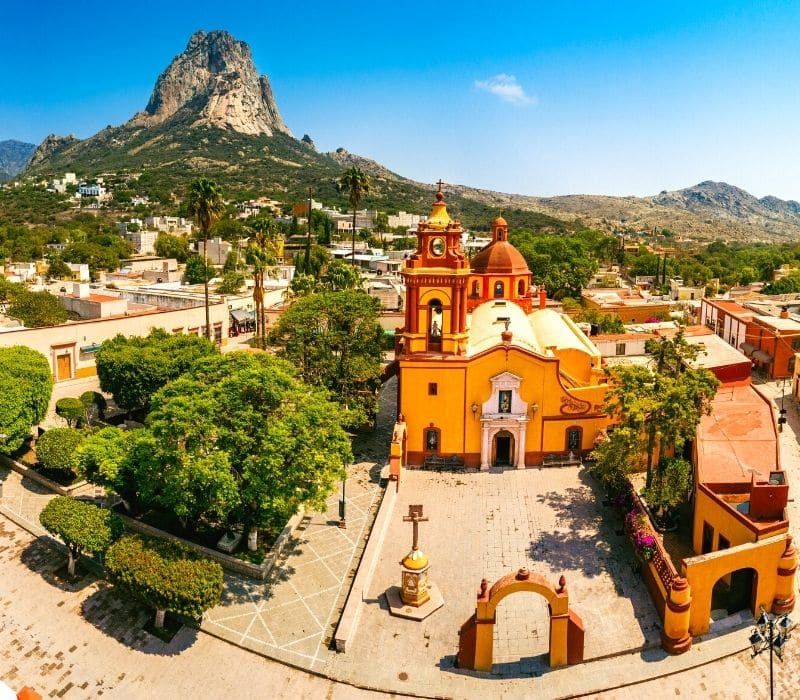
Queretaro International Airport (code: QRO) is the best airport to use for Queretaro Mexico travel. It is located in Tequisquiapan, Queretaro, about 45 minutes from Queretaro City in normal traffic. From the airport, you can rent a car and drive to your Queretaro hotel , or take a bus , taxi or Uber.
What’s the best way to get from Mexico City to Queretaro?
Some travelers will start their trip in Mexico City, and then head to Queretaro City from Mexico City. From Mexico City, the easiest and most comfortable way to get to Queretaro is by renting a car in Mexico City and driving there, but you can also take a bus .
Best places to visit in Queretaro Mexico
The vast majority of visitors stay in Santiago de Queretaro (or just Queretaro City for short).
From here, you’re just one hour by rental car from Bernal and Tequisquiapan, home to the Cavas Freixenet Vineyard and the Mexico Wine & Cheese Route. Besides Valle de Guadalupe in Baja, Queretaro state has the second best Mexico wine region.
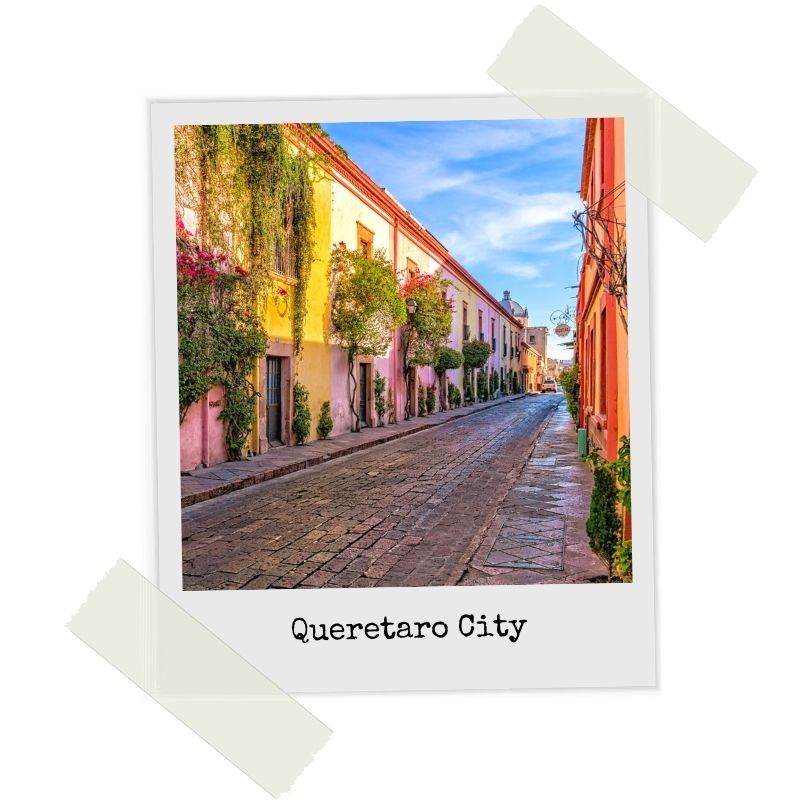
Queretaro City , Queretaro Mexico
Santiago de Queretaro has long been overshadowed by its colorful neighboring towns of San Miguel de Allende and Guanajuato . However, Queretaro gives them both a run for their money in the beauty department.
Is Queretaro worth visiting? Absolutely! From restaurants, historic sites, and even a beer garden, there’s no end to the amazing things to do in Queretaro City, Mexico. With the Queretaro Airport (code: QRO), you can fly directly there.
Best things to do in Queretaro Mexico
There is a seemingly endless amount of things to do in Queretaro Mexico, one of the best places to visit in Mexico .
The majority of them are in or near Queretaro City, the state’s main tourism hub, but for those who venture off the beaten path, there’s even more to Queretaro! Click on any image below to learn more ⤵

Peña de Bernal, Queretaro
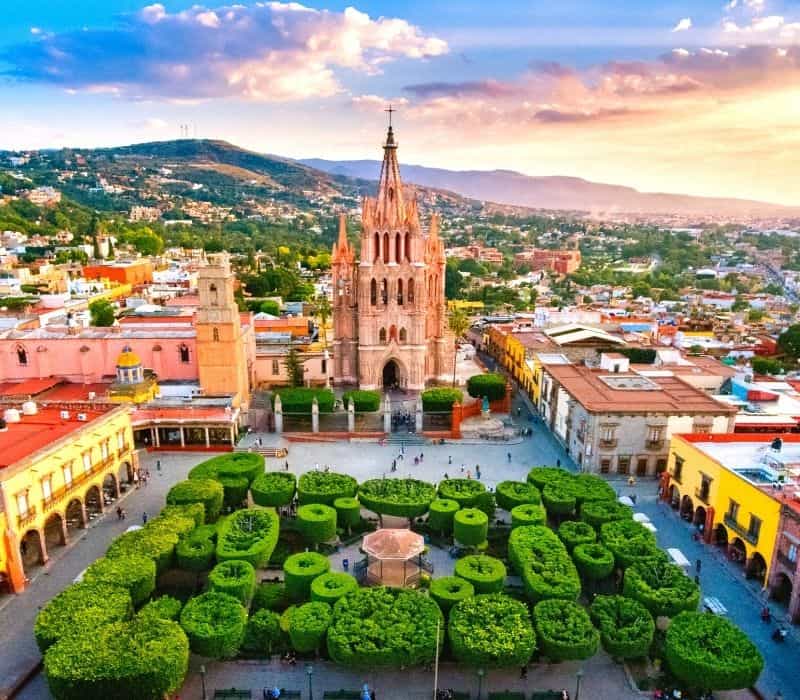
Day Trip: San Miguel de Allende
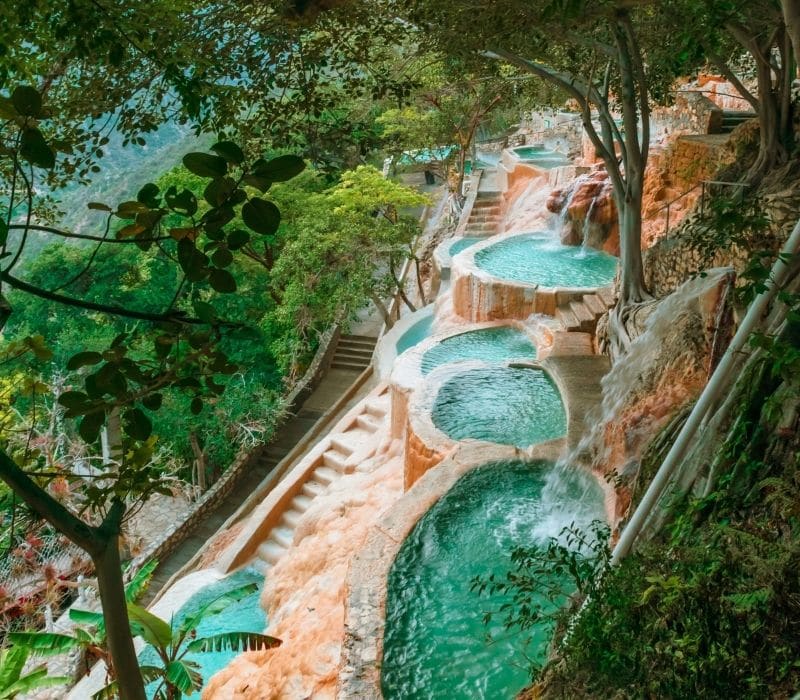
Grutas de Tolantongo

Tequisquiapan: Wine & Cheese Route

Sierra Gorda Biosphere

Go Bungee Jumping in Queretaro
Best queretaro tours.
Tours in Queretaro are a great way to see the main cities and their surrounding areas — and unless you’re planning to rent a car in Queretaro, this is the best way to get around because taxi fees add up quickly.
🚙💨 Note: If you do want to have a car in Queretaro, make sure to check out this guide to Renting a Car in Mexico .
Below, you’ll find the most popular and best tours in Queretaro City and the surrounding areas — including the Las Grutas de Tolantongo Mexico hot springs, local vineyards, and more.
Is Queretaro safe for travelers?
According to experts, you are statistically quite safe while visiting Queretaro — one of the safest states in Mexico. This is especially true of the best places to visit in Queretaro, including Queretaro, Bernal, Tequisquiapan, and the Sierra Gorda Biosphere Reserve.
Millions of Americans go to Mexico on vacation every year, so if we play the numbers game, the number of incidents is very small… When I’m asked if Mexico is a safe place to go travel on vacation, my response is yes . —Carlos Barron, FBI Veteran (source: Forbes )
That’s not to say bad things still don’t happen in those parts of Queretaro; they do. As with traveling anywhere, follow general travel safety like not walking home alone at night, watching your alcohol consumption and staying aware of yourself and surroundings.
For an added safety measure, pack these travel safety items , dress in a way so your Mexico outfits blend in with the locals, and buy a Mexico SIM card .
What’s the best travel insurance for Mexico?
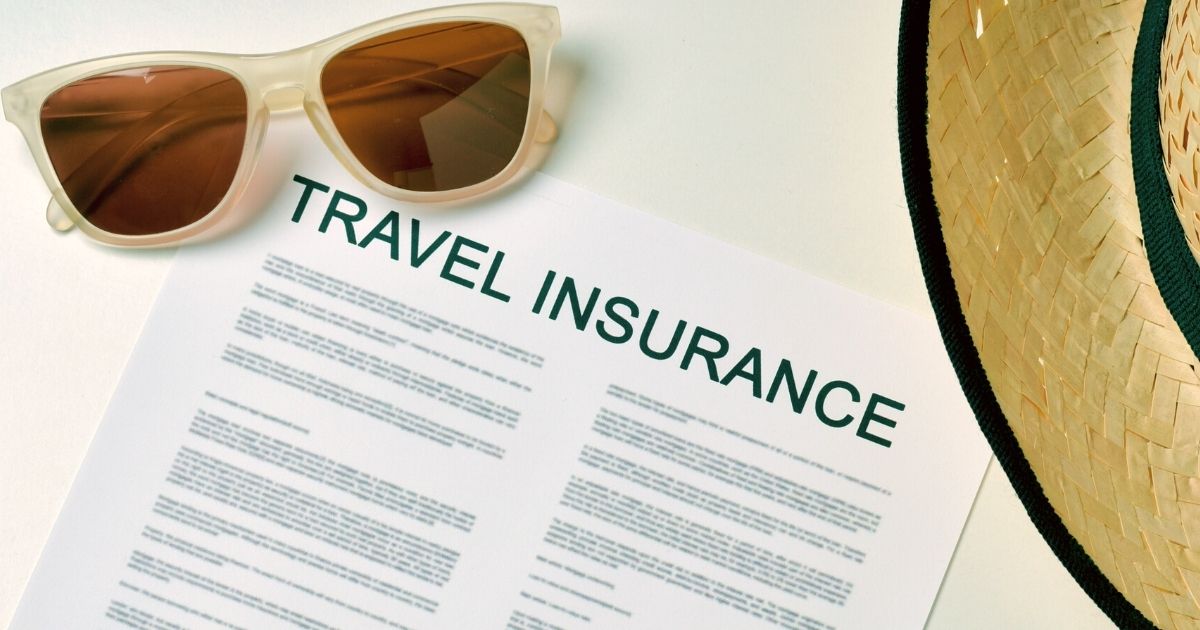
This is a question I get a lot as a Mexico travel writer and Mexico expat. To determine which Mexico travel insurance is best for you , consider factors like the policy’s total cost, your deductible, the coverage you need, your medical benefits, etc.
🏆 In general, I only ever recommend three companies to purchase Mexico travel insurance from:
- World Nomads — For general travelers and adventure travelers.
- SafetyWing — For general travelers and digital nomads in Mexico.
- Travel Insurance Master — Mexico travel insurance search tool, for those who want to compare policies.
- 👉 Click on any of the links above to get a FREE quote on your policy!
Queretaro Travel: Frequently Asked Questions
Can you drink the water in mexico.
No — Unfiltered Mexico tap water is not safe for human consumption. However, you will need to keep drinking water and to stay extra hydrated, as Mexico is quite close to the Equator. In fact, dehydration is one of the most common ways people get sick in Mexico.
So what can you do?
- If you’re renting a home with a kitchen, you can boil the water before drinking it.
- You can keep buying bottled water — Though this gets expensive, and is horrible for the planet!
- Use the Water-To-Go Filterable Bottle . This refillable bottle not only keeps you hydrated, but also filters your water so you don’t get sick in Mexico, and is good for the planet ♻️ Get 15% OFF with code SOLO15!
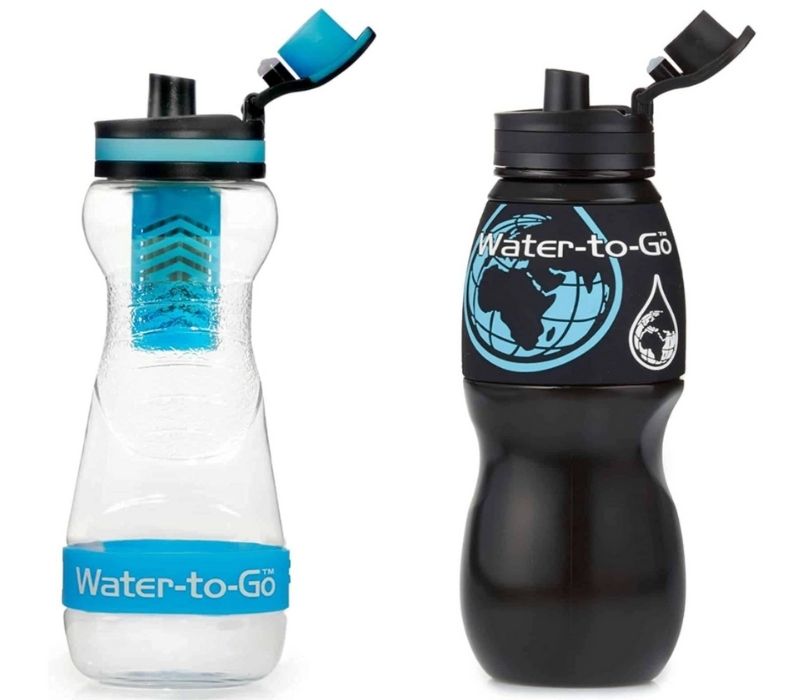
The Water-To-Go Bottle has a built-in, three-stage filtration system that removes 99.9999% of all water-borne contaminants. These include bacteria, microplastics, viruses, heavy metals, chemicals and more. I personally own one, as you can drink Mexico water from any source (even the tap), and be completely safe.
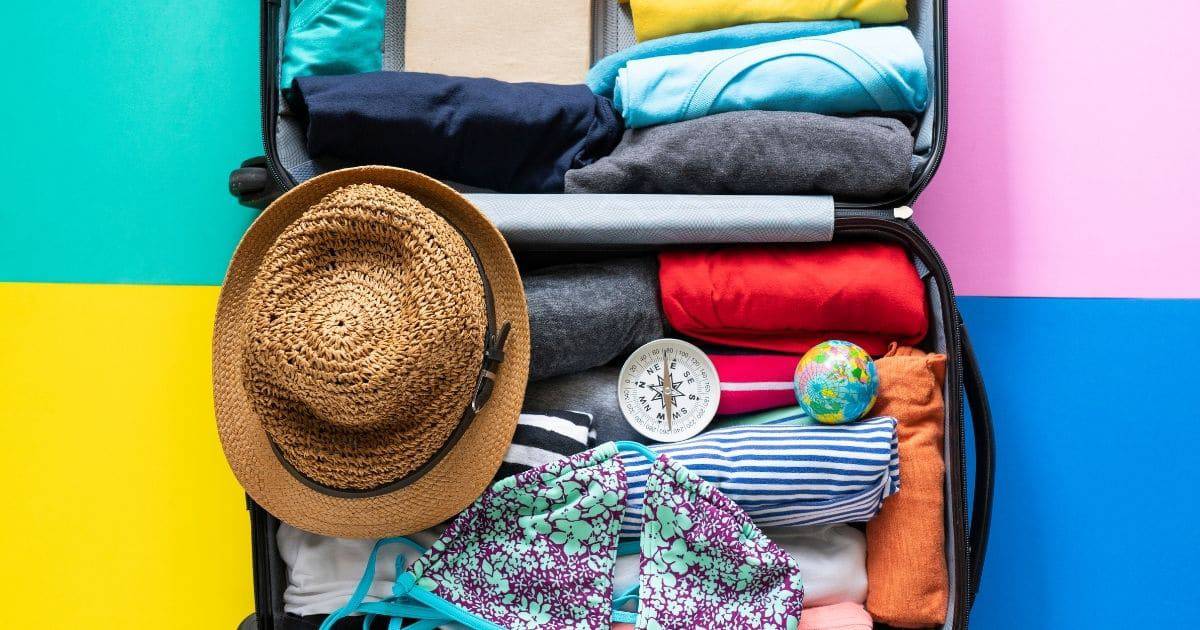
🧳 Mexico Packing list
Wondering what else you need on your packing list for Mexico? Check out this guide — Ultimate Packing List for Mexico + FREE Checklist Download !
What’s the Queretaro weather like?
Queretaro state, located in Central Mexico, has what is called the Eternal Spring climate. This means you can expect mild springtime temperatures all year, and it’s never super hot or super cold.
The Queretaro rainy season lasts from about April to September, and it can rain quite a bit, so try to visit from October to March, during the dry season.
☀️ Queretaro weather

Is Queretaro expensive?
No — Queretaro is one of the best Mexico budget travel destinations. While it’s still off the beaten path for international travelers, Queretaro travel is very popular with Mexicans travelers.
This means the state has great infrastructure to host visitors, but your money will stretch much further in Queretaro than neighboring San Miguel de Allende .
Is Queretaro worth visiting?
Yes — Queretaro is a unique Mexico destination that many types of travelers will love. Nature enthusiasts love climbing the Peña de Bernal and visiting the Sierra Gorda , a UNESCO World Heritage Site.
Located in the areas surrounding Queretaro, you can visit all the wineries and cheese caves on the Mexico Wine & Cheese Route .
How many days do I need in Queretaro Mexico?
With four full days , you could enjoy Queretaro City and its neighboring cities of Bernal and Tequisquiapan. If you want to venture off the beaten path into the Sierra Gorda Biosphere Reserve to see the Franciscan Missions and enjoy the gorgeous nature, add three days to the trip, for a total of seven full days .
🗣 Mexico Language
Mexico Fun Fact : There’s actually no official language of Mexico!
Spanish is the most widely-spoken, so some mistakenly say Spanish is the official language of Mexico. However, the government actually recognizes 68 national languages, including the Nahuatl Aztec language, and the Maya language.
💰 Mexico Currency
Mexican Peso — Exchange rates vary, but have hovered around $18-21 pesos to $1 USD for about the last decade. You will find some places that take U.S. dollars, but usually at an unfavorable rate, so stick to using pesos in Mexico .
☀️ Mexico Weather
Mexico is a big country — the 7th largest on Earth, in fact! It’s hard to generalize the weather in Mexico, because it will vary greatly by where you’re traveling.
In general, temperatures are mostly mild everywhere all year long, though summers on the coast are hot and humid, and winters in Central and Northern Mexico are on the colder side. Throughout the whole country, the rainy season runs from (about) April through September.
✈️ Mexico Busy Season & Slow Season
• Mexico Busy Season: The busy season in Mexico runs October to March, as this is the dry season and you’ll get the best weather. December is the busiest month for tourism in Mexico.
• Mexico Slow Season : If you don’t mind some rain, you’ll often find the best travel deal during the Mexico slow season of April to September. Do keep in mind that June 1-November 1 is Hurricane Season, and Mexico beaches are all susceptible.
• Mexico Shoulder Season : The shoulder season is that magical time when prices are still low and the weather is good. The Mexico shoulder season is from about mid-October to November and January to early-April.
🧳 Download your FREE Mexico Packing Checklist here!
Check out this Ultimate Packing List for Mexico — so you know what to pack and what NOT to pack for Mexico! This article offers advice on packing for Mexico cities, and packing for a Mexico beach vacation.
Beyond what Mexico outfits and clothing you’ll want to bring, here are a few extra things to consider:
• Filterable Water Bottle: Mexico is close to the Equator, so you’ll need to stay extra hydrated. In fact, dehydration is one of the most common ways people get sick in Mexico.
A filterable, refillable water bottle not only keeps you hydrated, but also filters your water so you don’t get sick in Mexico.
The Water-To-Go Bottle has a built-in, three-stage filtration system that removes 99.9999% of all water-borne contaminants. These include bacteria, microplastics, viruses, heavy metals and chemicals.
• Mexico SIM Card: Want to be able to use your phone in Mexico?! Of course you do! Pick up a TELCEL Mexico SIM card before your trip, and swap it out on the plane while you’re waiting to exit, so you have phone and data service the second you arrive in Mexico.
• Anti-Hangover Meds: Planning to party hardy?! Make sure you’re not wasting any of your precious travel time with a hangover. Liquid I.V. has about 70,000 reviews on Amazon, and is considered the best defense against a hangover.
• Sun Hat: No matter if you’re headed to the beach or a city, you’ll want to wear a hat to shield yourself from the strong Mexican sun. This cute sun hat is the perfect stylish and practical accessory for your Mexico vacation.
• Sunscreen: As you’ll want to reapply a few times throughout the day, a light, Mineral-Based Sunscreen is ideal.
Headed to the beach? Do your part to practice responsible tourism in Mexico by only using an eco-friendly reef safe sunscreen while swimming. You can even ditch the sunscreen altogether and opt for a long sleeve swimsuit (AKA rash guard) instead.
• Bug Repellent: Mosquitoes are common throughout Mexico — especially on the beaches! REPEL Insect Repellent is an eco-friendly brand that’s DEET-free and plant based, with a pleasant lemon and eucalyptus scent. Don’t want to use a spray? Pick up some Mosquito Repellent Bracelets .
The vast majority of travelers do not need a visa for Mexico — this includes Americans, Canadians, and most Europeans. Head here to see if you need a Mexico travel visa.
🤔 What is the mexico FMM ?
When you go through Customs & Immigration to enter the country, you’ll receive your Forma Migratoria Multiple , or FMM Tourist Card (sometimes listed as FMT). If you’re coming by plane or cruise ship, there is no charge; for those driving across the border, the FMM costs about $30USD.
In most circumstances, all visitors get a 180-day (six month) visa — so you can legally stay up to six months!
🚨 Have your FMM on you at all times
Keep in mind that though it’s called an FMM card , it’s actually just a small piece of paper. Keep your FMM on you at all times in your wallet, as this proves your legal status in Mexico. It’s rare, but if an officer stops you, they can ask to see your FMM.
🎫 Don’t lose your FMM!
You need to have your FMM on you at all times, as proof of your legal status in the country.
Be sure to keep track of your FMM, as you’ll have to give it back to an Immigration officer at the airport, cruise port, or land crossing when you’re leaving the country.
If you lose your FMM, there is a $600 peso ($30 USD) cost to replace it, and some paperwork you’ll need to fill out before you can leave the country.
If you’re flying home, plan to arrive at the airport about one hour earlier than you normally would to do the paperwork and pay the fine.
As this question doesn’t have a yes/no answer ( I wish it did! ), I do my best to answer it in depth in this article, Is Mexico Safe for Travelers Right Now ? However, for the most part, Mexico is actually statistically quite safe for all travelers — including solo travelers.
Check my Solo Female Mexico Travel page for more info.
💃 Mexico solo travel guides
Mexico is a big country, and it has plenty of amazing solo female travel destinations — like the ones featured in this article, Mexico Solo Travel: 20 Safe Destinations for Female Travelers .
In it, you’ll get recommendations of places to visit in Mexico, from solo travelers who have actually been to them.
🎧 solo travel podcasts
• Ep. 34 | Planning your first Mexico solo trip • Ep. 40 | Tips for safe solo travel in Mexico • Ep. 53 | 30 Solo female travel tips, Pt. 1
To answer the question, Is it safe to drive in Mexico? — YES , it’s considered safe to rent a car and drive in Mexico.
As the country is quite large, road trips are a great way to see a lot in a little time, and especially popular in the Yucatan Peninsula and Baja California Peninsula.
The one caveat to Mexico driving safety is that you’ll be in a foreign country, unfamiliar with their laws and customs. Head here for a complete guide to Renting A Car in Mexico: Everything You Need to Know , where you’ll also get 10 useful Mexico driving tips!
🚙💨 Looking for the best Mexico car rental company? Discover Cars works with both local Mexican companies and international companies to get you the best rates. Not only do I recommend them — I also use them!

As a general rule, you’ll want to know at least a few words of Spanish when visiting anywhere in Mexico. This is both a sign of respect, and will also help you have a better, smoother trip.
If you stick to the more touristic places in Mexico, you should be fine with basic Spanish. For those planning to venture off the beaten path, be advised most people in pueblos (small towns) speak little to no English.
🗣 Here are some options:
- Brush up on your Spanish: Use a language-learning program like Rocket Spanish , so you’re confident, and conversational, before your trip.
- Download the Google Translate App: For this to work at all times, you’ll need a Mexico SIM card with data — as the app won’t work when you’re off-WiFi.
- Travel with a Mexico phrasebook: This Lonely Planet Spanish Phrasebook is an Amazon best seller, and a great non-digital language assistant!
- Save this infographic an image on your phone. This way, you have access to these common words, phrases and questions, even when you’re off-WiFi.
Roaming Around the World
Travel Guides, Tips, and Tales
15 Best Things to Do in Queretaro Mexico: Travel Guide
August 19, 2018 By John Widmer 54 Comments
Querétaro is an emerging star of a travel destination in Mexico and has quickly joined our growing list of favorites places within the country. It’s such a pleasant colonial city to experience in the central highlands of Mexico. We found so many fun things to do in Queretaro to make it worth spending at least a few days in this gorgeous city.
More formerly known as “Santiago de Querétaro,” most people just call the city Queretaro, which is the same name as the State that this city is the capital of. This capital is a thriving city of nearly a million people. That makes it the 24th largest city in Mexico, by population. Yet Queretaro’s historic centro still manages to retain an alluring quaintness for a city of this size. This centro historico is perhaps best experienced while ambling the many squeaky-clean pedestrian streets that are instead littered with countless fountains, churches, museums, and monuments.
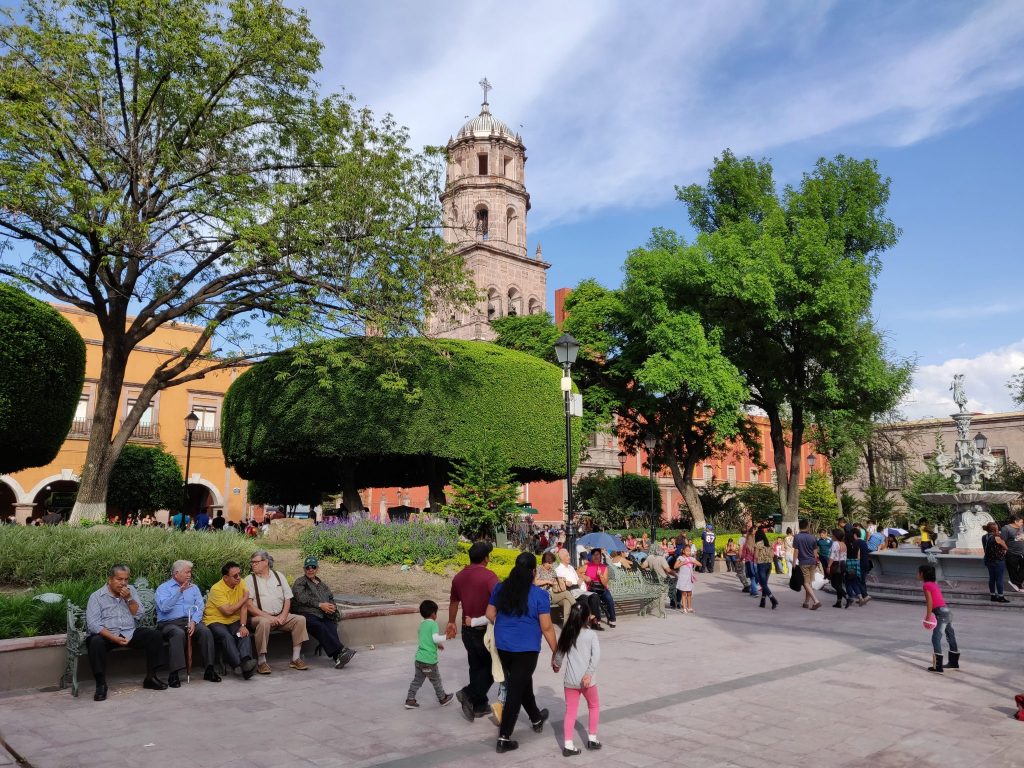
There are over a thousand monuments throughout the lively historic center. Most of those date back to the 1700’s when the city initially thrived, during a time when Spaniards lived peacefully here with the indigenous people. It’s this unique history and the subsequent architecture from that era, which has led Querétaro to be recognized as one of Mexico’s 35 UNESCO World Heritage Sites .
Simply walking around the historic streets to see the architecture and monuments is clearly one of the best things to do in Queretaro. Yet those picturesque streets are also sprinkled with great restaurants and patio bars. The latter are just too inviting, given the mountain temps regularly hover around 70°F (~21°C) during happy hour time.

Source: Google Maps
Queretaro is located at altitude after all, so the city maintains an eternal spring-like climate throughout much of the year. You wouldn’t realize it from the mostly flat streets of Queretaro’s historic center, but the town is situated over a mile high (1,820 meters). The cool & dry mountain air comes as a most welcomed reprieve in this country that is otherwise very warm throughout the low-lying areas.
We love the cooler summer climate that Queretaro’s surrounding mountains delivered. It’s those same mountains that also provide great hiking opportunities, including a trek up one of the biggest rocks in the world!
After working up an appetite, Queretaro has excellent restaurants to refuel! The cuisine in Queretaro is delicious, from Mexican favorites to international fare, and from fancy patio restaurants to equally tasty taco stands in the mercado . And what an awesome surprise to find that there’s even a wine region way out this way to wash down all of Queretaro’s fine cuisine with.

Queretaro is a very friendly city and is a university town too, so you’ll likely notice its youthful presence. The friendly vibe of the city is carried over to Queretaro’s safety. We find it to be very safe too and many people often cite Queretaro as one of the safest cities in Mexico.
As for crime in Queretaro, Numbeo (the largest numeric database of cities worldwide) gives Queretaro a “low” rating of 39, which is even lower than my hometown back in the US (52). For perspective, you can see crime stats of how your hometown compares to Queretaro: here . You may be surprised! We never felt any safety concerns, even when walking around the streets at night. Like many places in Mexico, the only danger may be not wanting to leave.
So now that we’re finished swooning over why this city is such a lovely place in Mexico to travel, we’re ready to divulge what we’ve found to be the best things to do in Queretaro!

Best Things to Do in Queretaro Mexico
There are so many events, activities, and tours to consider all throughout Queretaro. So where do you even begin? Points of interest range from ancient ruins to national parks, and perhaps even a few brews in between. So below are our suggestions for the 15 best things to do in Queretaro. This map can help you to locate each of the recommendations.
1) Roam Around the Monuments of Queretaro’s Historic Center
The Historic Monuments Zone of Queretaro is what garnered the city its Unesco-listed status. Per Unesco, “The old colonial town of Querétaro is unusual in having retained the geometric street plan of the Spanish conquerors side-by-side with the twisting alleys of the Indian quarters.” Complete Unesco description: here .

This unique architecture from the 1700’s still remains much intact and well-preserved today, making for a beautiful setting to simply stroll around and explore. Within the 204 city blocks, across 4 sq. kilometers, there are a total of 1,400 designated monuments . That’s a lot of monuments!
Many of the streets and alleyways throughout Queretaro’s historic center remain completely car-free. So you can be carefree to wander around the pedestrian streets without having a deal with traffic. While doing so, you’ll undoubtedly bump into many of the 1,400 monuments along the way.
Some of the more notable Queretaro monuments to look for are these four:
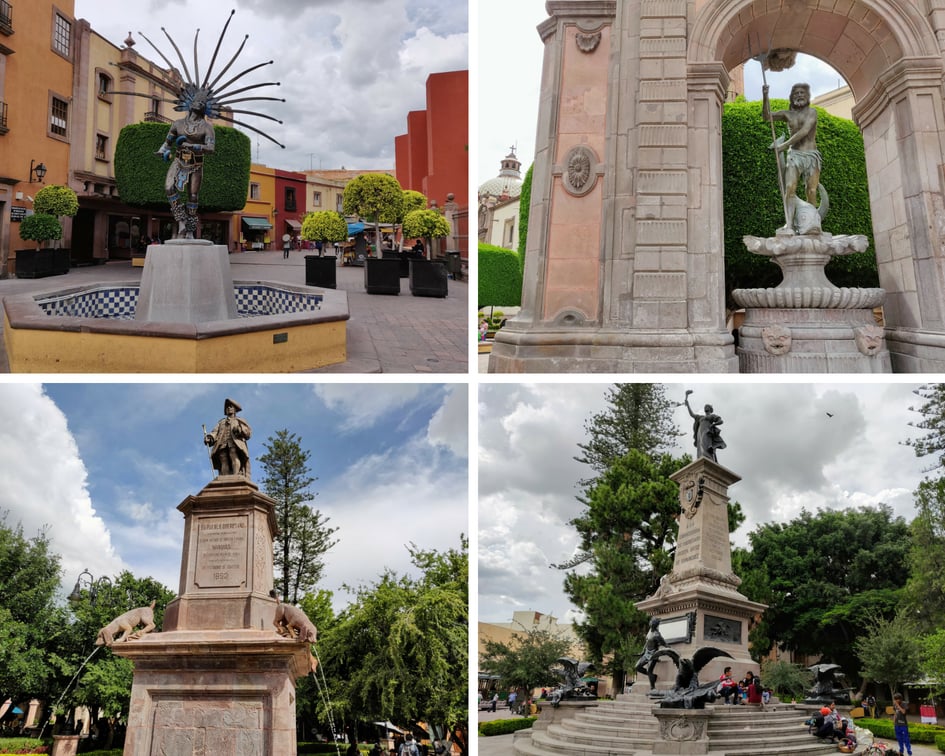
- El Danzante Conchero – Dancing Conchero statue showing an important traditional dance
- Fuente de Neptuno – Fountain of Neptune, Roman God of the Sea (1797)
- Fuente de los Perritos – The puppy fountain dedicated to the benefactor of Queretaro
- Monumento de La Corregidora – Large statue of female Mexican independence hero doña Josefa Ortiz, holding a flame
Ambling around the historic centro is a “must” for things to do in Queretaro.
2) Tour the Queretaro Wine Region
There are actually some good wineries surrounding the city of Queretaro. This state boasts Mexico’s second biggest wine region (after Baja). Despite being outside the normal wine-producing parallels, the semi-desert highlands here are quite favorable for grape growing. The specialty in Queretaro is sparkling wine!
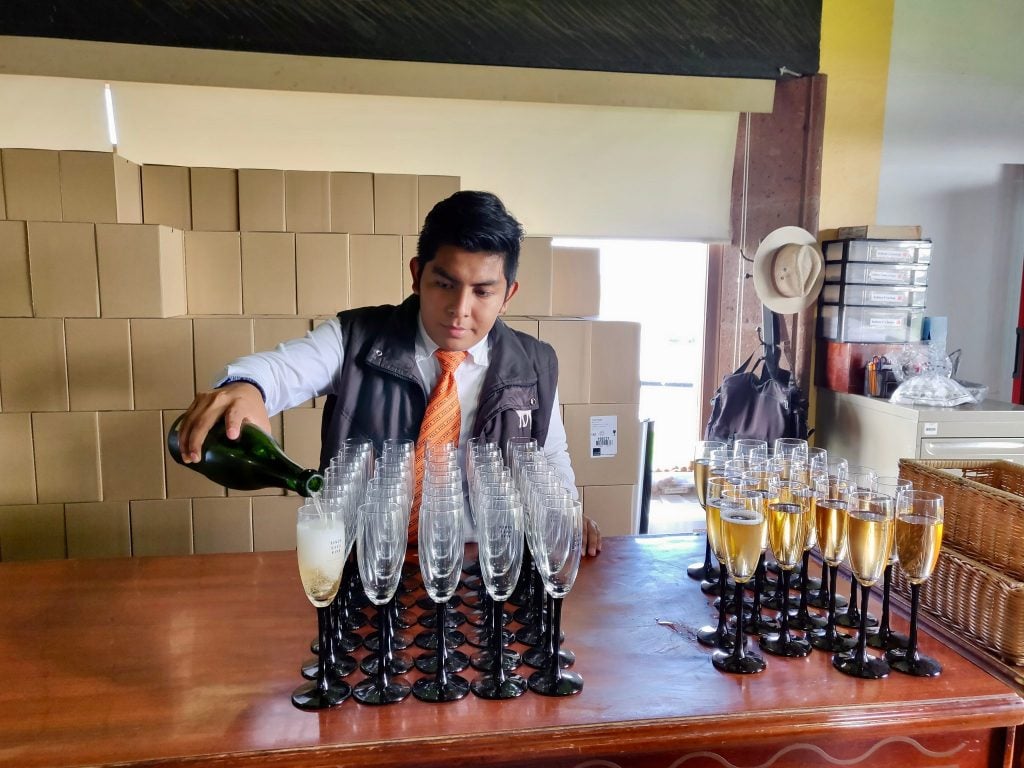
The most popular of Queretaro’s wineries is Finca Sala Vivé by Freixenet México . Freixenet is a well-known wine producer in Spain and was among the first to open facilities here in Central Mexico, back in the late 70’s. Now there are over 25 vineyards around Queretaro, all growing, squeezing, and fermenting locally grown grapes. There is even a dedicated wine and cheese route (ruta de vino y queso) in which you can spend a really delicious day touring around the vineyards and fincas (farms) surrounding the city of Queretaro.
Freixenet alone now produces 2 million bottles annually here! The majority of its sales are sparkling wines, which employs the same methods that are used in Champagne production. And we can vouch firsthand that this Mexican sparkling wine is quite tasty – salud!
We’re really impressed not only with the quality, but the entire experience of exploring this wine route. Touring the cellars, production facilities, and vineyards is all such great fun in Mexico! At Finca Sala Vive, English-speaking tours are conducted.

💵 Finca Sala Vive by Freixenet Tour Price : $110 pesos for the 45-minute Classic visit, includes tasting and glass. 🕒 Finca Sala Vive by Freixenet Hours : 11:00 am – 4:00 pm, tours hourly on weekdays (excluding 2:00) and every 30-minutes on weekends. 🚗 How to Get To Finca Sala Vive by Freixenet : If you have a driver, follow the directions here on Google Maps for the one-hour drive, passing by Bernal. 🚐 Finca Sala Vive by Freixenet Tour : Wine & Cheese Route tours depart daily from Queretaro at 9:00 am, returning at 6:30. Cost is $830 pesos per person for this all-day Queretaro tour. You can book at the tourism stand located here , next to the dancing conchero statue.
3) Go Museum-Hopping All Around Queretaro
There are so many museums packed in the historic centro that it makes us wonder if Queretaro may have the highest density of museums in all of Mexico. I’m not certain whether or not that holds true, but we counted nearly 20 museums all within a few square kilometers of Queretaro’s historic center.
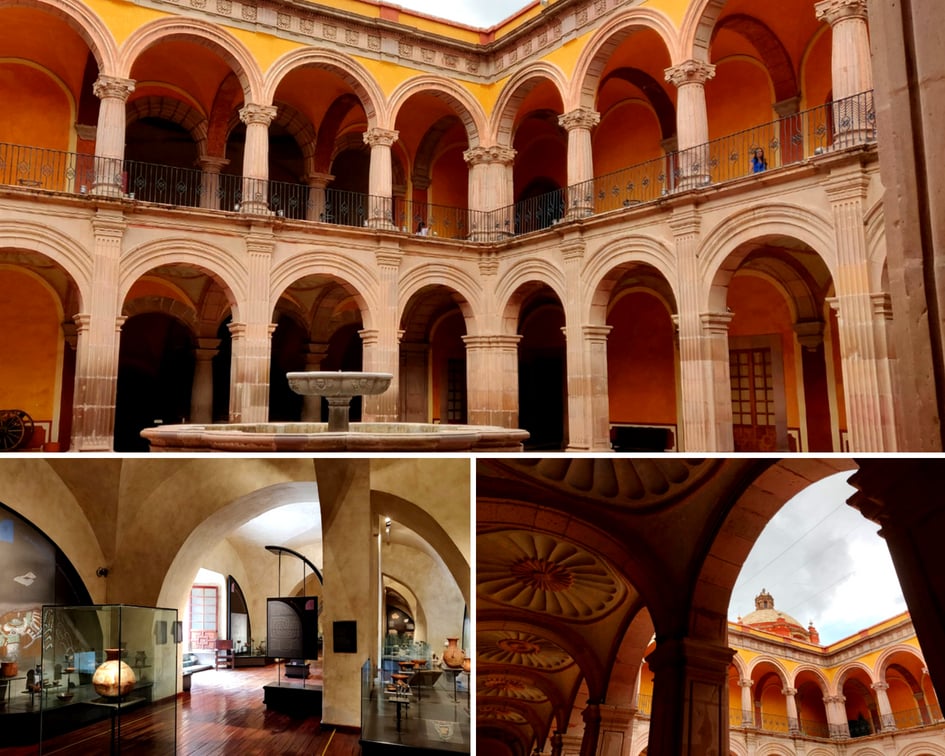
There are museums you would expect, such as art museums and history museums. And then there are peculiar museums you may not have anticipated, like the Vermin Museum or the Calendar Museum. The latter is actually much more interesting than it sounds!
While searching for things to do in Queretaro, you’d be hard-pressed not to stumble into a museum, many of which are free to enter. But which of Queretaro museums should you visit? Well, that depends on your interests.
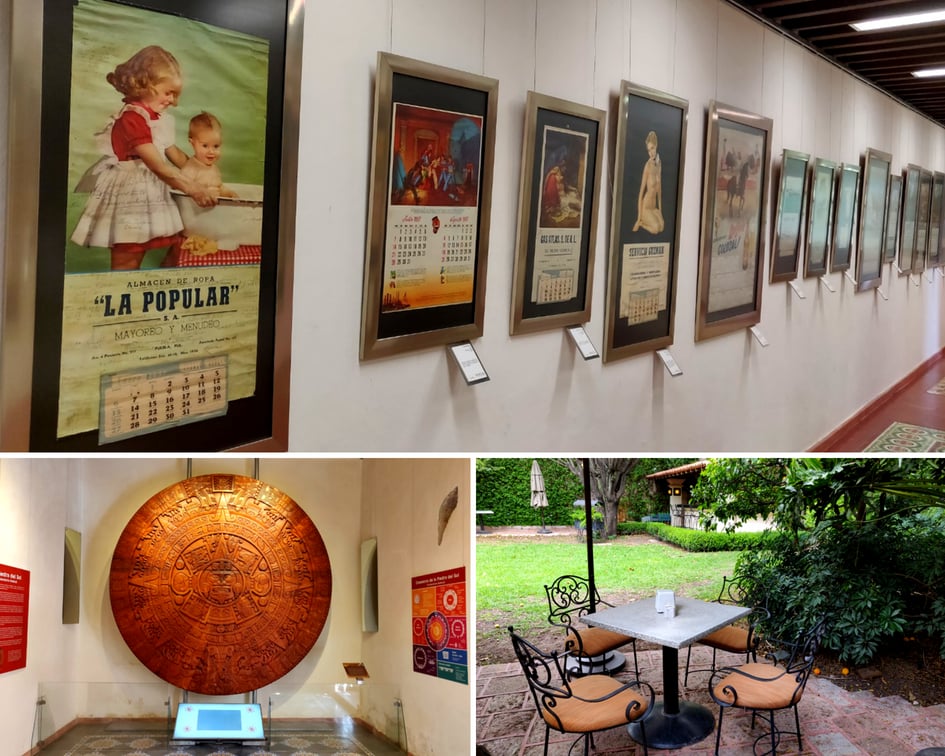
These are what we found to be some of the best museums in Queretaro and recommend:
🏛️ Mucal Calendar Museum – It’s about time. No really, that’s the topic this museum is dedicated to, with exhibits ranging from intricate ancient Aztec time-keeping devices to vintage calendars spanning the past few decades. There’s a nice cafe in the courtyard too. Cost: $30 pesos. Hours: 10-6. Closed Mondays. Official website: Mucal Museum .
🏛️ Museum of the City – The name of this museum is misleading. It’s not a museum about the city at all. Instead, the exhibits are composed of interesting, edgy, and humorous contemporary artwork spread throughout a baroque mansion. Cost: Free. Hours: 11-7. Closed Mondays.
🏛️ Art Museum of Queretaro – Queretaro’s art museum is worth the modest entry fee simply to stroll around this very ornate former monastery. Art buffs will likely further appreciate the many paintings within the chambers. Cost: $30 pesos. Hours: 10-6. Closed Mondays.
🏛️ Queretaro Regional Museum – Housed in another atmospheric monastery, this history museum contains many artifacts with significance to Queretaro’s past, spanning centuries from its indigenous roots to independence and on through the modern era. Cost: $60 pesos. Hours: 9-6. Closed Mondays.
🏛️ Museo de la Casa Zacatecana – This mansion displays period furnishings showing what wealthy life was like in 19 th -century Queretaro. The journey through this mansion reveals a tale of murder. Check out the mirador (viewpoint) too. Cost: $60 pesos. Hours: 9-6. Closed Mondays. Official website: Casa Zacatecana .
4) Hike Up One of the World’s Largest Monoliths: Peña de Bernal
Venturing out to Bernal is one the best things to do in Queretaro for a day trip. It only takes about an hour to reach the small colonial town of Bernal, where a massive rock seemingly sprouts right up from the ground.
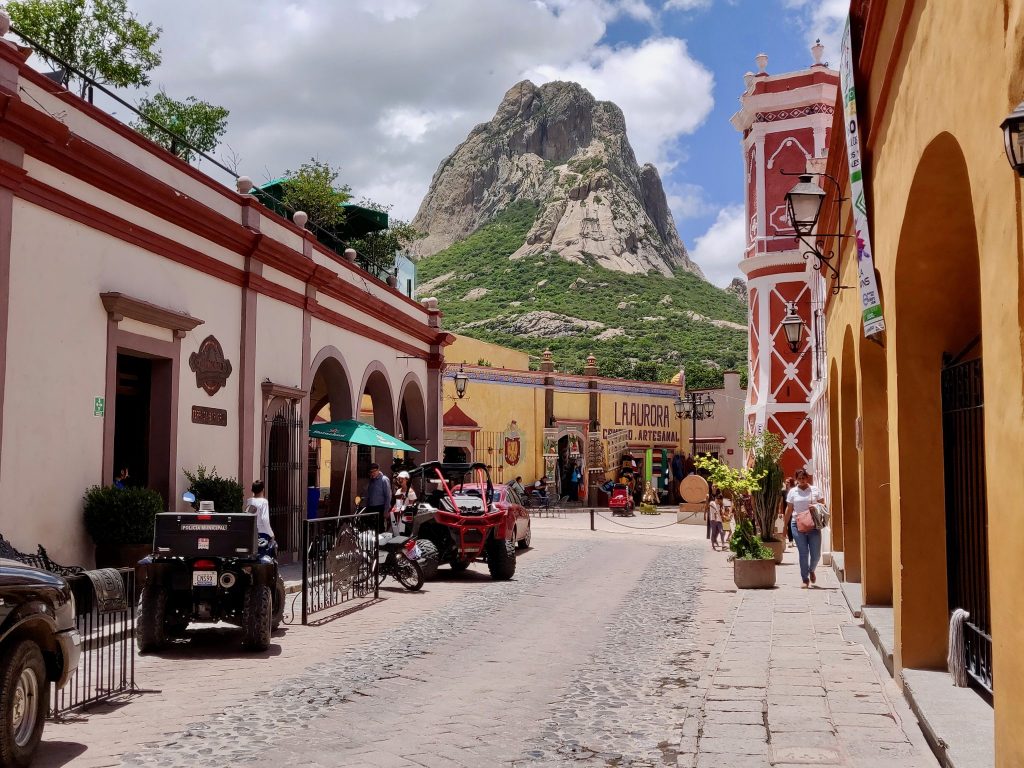
This behemoth of a rock, known as Peña de Bernal, is among the largest of its kind. The towering wonder comes just behind other famous monoliths like Australia’s Ayers Rock and the Rock of Gibraltar. Peña de Bernal is a spectacular sight to see shooting up above the scenic puebla. Yet to really experience Peña de Bernal, we strongly recommend anyone whose fit to hike up it!
You do need proper rock climbing gear to reach the very top. There are adventure outfitters who can assist with gear, but that needs to be arranged in advance. You can do that by booking a Bernal rock climbing tour from Queretaro like this one on Viator . Yet without climbing gear, you can still trek about 80% of the way toward the top of the monolith. You’re then rewarded with sweeping views of the town, surrounding mountains, and the countryside down below. Plan to spend up to two hours or so for the steep roundtrip hike up Peña de Bernal.
The gigantic rock certainly is an attention-grabber. But it’s the historic pueblo magico (magic town), which sits in the monolith’s shadow, that makes for a most charming base to set out from. This domestic tourism hotspot gets busy on the weekends. So a weekday visit will give you more space on the trails and a tranquil atmosphere. Meanwhile, the weekends are more festive, yet crowded.
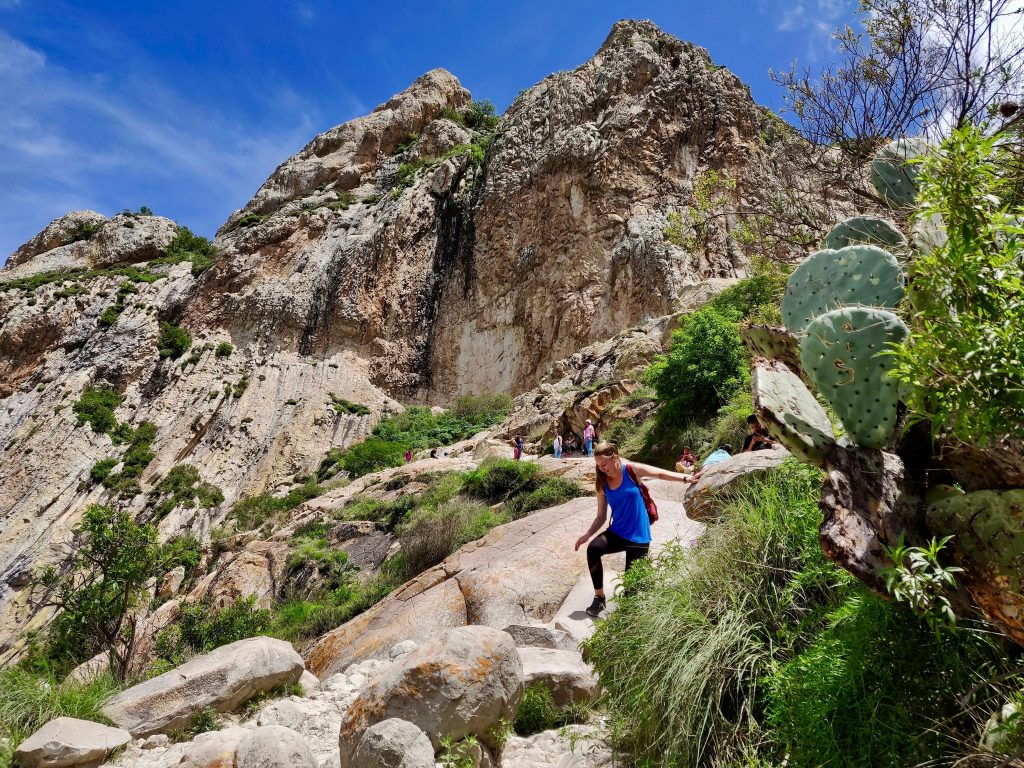
Between hiking, eating Bernal’s local specialty (gorditas), exploring the town, and perhaps a post-hike michelada or two, you could easily spend a half to full day roaming around Bernal.
💵 Peña de Bernal Entrance : Free 🕒 Peña de Bernal Hours: No proper hours. Pursue during daylight. 🚌 Queretaro to Bernal Bus : Flecha Azul ($57-pesos) and Flecha Amarilla (AKA Coordinado) ($46-pesos) have buses with regular departures from Terminal de Autobus Quaretaro (TAQ), terminal B. Departure times (as of July 2018) are on the :35 of every hour beginning at 6:35 am. 🚐 Bernal Tour from Queretaro : For a Peña de Bernal climbing tour, you can book online here . There are additional non-climbing tours of Bernal from Queretaro that you can book at from the tourism kiosk in the center of town.
5) Go to Church
There are dozens of churches, convents, and other religious sites scattered all throughout Centro. So it’s only natural that visiting these ornate and historic cathedrals is on your list of things to do in Queretaro.

If you were to visit only one church in Queretaro, we suggest Templo de Santa Rosa de Viterbo . This 18th-century baroque church is perhaps the most visually interesting and elaborate of them all. It’s also where you can easily find the city’s colorful sign to snap a pic.
Meanwhile, the interior of Templo de Santa Clara is almost dripping with gold from floor to ceiling, making for an interesting sight.
Even if you’re starting to get a little churched-out in Mexico, you may still find it worth visiting the impressive, Templo y ex-convento de la Santa Cruz . To see this grand convent, you must take a short 20-minute guided tour (in Spanish). Yet it’s the storied “tree of the cross,” and the cross-shaped thorns it grows, that further captures much fascination.

6) Explore an Ancient Pyramid in Queretaro: El Cerrito
Ancient pyramids aren’t just in Egypt. You can find one right here in Queretaro! Take a short jaunt through Queretaro’s suburbs and to reach this impressive archeological site. This pyramid dates back to around 700-900 AD and was used as a place of worship among Mesoamerican civilizations spanning an entire millennium.
This rugged, partially excavated pyramid rises up from the platform, nearly 10 stories high (30 meters). Exploring the site makes for one of the more interesting things to do in Queretaro. You can admire centuries worth of history and what is said to be one of the most important sites of the Toltec world!

The pyramid itself is a remarkable sight. Yet the well-manicured desert garden landscaping is also quite admirable, while wandering the paths leading to the ruins. There’s also a recently renovated onsite museum to learn learn more about this archeological site.
Although El Cerrito is a bit out of the way from Centro, we find it well worth venturing out to. Definitely add this fascinating site to your list of things to do in Queretaro!
💵 El Cerrito Entrance Fee: Free 🕒 El Cerrito Hours: 8:00 am – 2:50 pm. 🚕 Getting to Cerrito: It’s a 20-minute drive from Queretaro centro, approximately $80-peso Uber fare. ⌚ Time Spent: About 45-minutes, maybe longer if lingering at the museum.
7) Hang Out in the Many Plazas and Gardens of Queretaro
There are so many beautiful plazas throughout Queretaro’s historic center. Early city planners must have had a beautiful vision in mind, as the gardens and park spaces in Queretaro add greatly to the city’s charm. On weekends these plazas tend to be filled with families and friends. The festive environment makes for fantastic people watching.

Perhaps most lively and scenic is the Zenea Garden in front of the San Francisco Church. Plaza de Armas is another popular gathering spot.
Yet it’s the largest garden of them all that often gets overlooked, perhaps due to its location just on the outskirts of centro. We find the tree-filled Community Garden (Alameda Hidalgo) to be well worth a 5-minute walk to have a sense of nature from right within the city.

8) Learn the Sordid History of Cerro de las Campanas National Park
Cerro de las Campanas is a Mexico National Park located right within Queretaro. While the grounds of this National Park are scenic, the importance of the park is actually more for its historical significance than its natural beauty. Even if you’re not aware of the history this site holds, taking a stroll around the park still makes for a very worthwhile thing to do in Queretaro.
We’ll help briefly get you up-to-speed now about the history of Cerro de las Campanas. This National Park is on this hillside where the Mexican Emperor Maximilian I surrendered and also later executed in the same spot. It was these events in 1867 that signified the end of the French Intervention and the fall of the Second Mexican Empire . Today you can visit the Austrian-built chapel on this hillside that now honors Maximilian I.
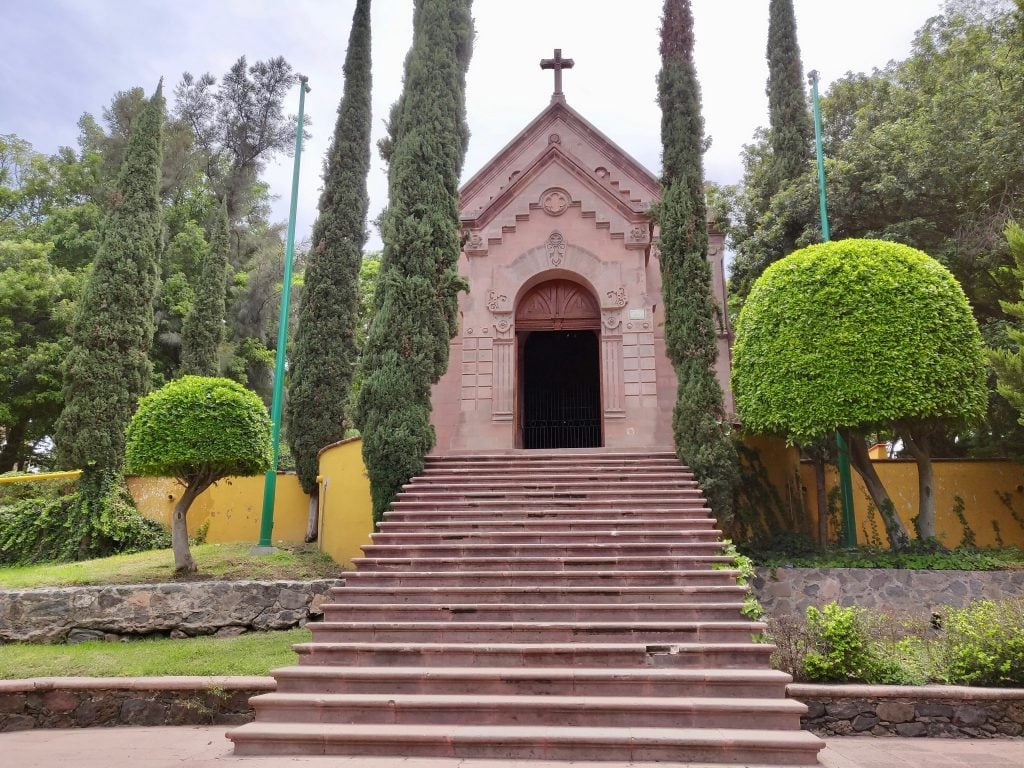
Interestingly, further above this chapel is a huge statue of Benito Juarez, who maintained he was President during Maximilian’s reign and was ultimately the one who ordered Maximilian’s execution. Strolling a bit further into the National Park, you’ll come across a museum that explains some of this history in addition to other notable events in Queretaro, spanning many centuries.
So what about the bells? The name of this park translates to “Hill of the Bells” because it contains strange rocks that make a ringing sound when struck together.
💵 Cerro de las Campanas Entrance Fee: $5 pesos 💵 Museum Entrance Fee Entrance Fee: $15 pesos (buy the museum ticket at the park entrance, not museum) 🕒 El Cerrito Hours: 6:00 am – 6:00 pm. 🚶 Getting to Cerrito: 20-30 minute walk from Centro, or 5 minutes by car (~$40-peso Uber) ⌚ Time Spent : About an hour or so.
9) Wander through Queretaro’s Lively Market: Mercado La Cruz
Exploring the local market is a quintessential experience in any Mexican city to get a feel for the local vibe. And Queretaro’s Mercado La Cruz is no exception. Whether you’re in search of produce, a new pair of shoes, or a piñata, you’ll find it all here at Mercado La Cruz.

Yet it’s the many taco stands that kept us returning to this vibrant open-air market. Find a stall that looks to have garnered many satisfied customers and pull up a stool. It’s the perfect thing to do in Queretaro to soak in the charmingly local atmosphere.
10) Discover Queretaro’s Fascinating Public Buildings
In addition to all the churches and museums, there are a number of public buildings scattered throughout Queretaro with historical significance. You could easily walk right past them if you didn’t know what they were. Yet it’s worth knowing their location and significance so you can take a quick stop in to look around.
The Teatro de la Republica is where the Mexican Constitution was signed, where Emperor Maximilian I was sentenced to execution, and where the Mexican National Anthem was first sung. Lots of Mexican history here! Completed in 1852, it still functions as a theatre today and it’s free to visit between 9:00 am and 5:00 pm.

Stroll into the Palacio de Gobierno (Government Palace) located right next to the Plaza de Armas. There are three impressive murals depicting scenes from Mexico’s history from within this building where the country’s independence was planned. Today it still operates as a government office and is open to the public on weekdays 8:00 am – 6:00 pm. Cost: free.
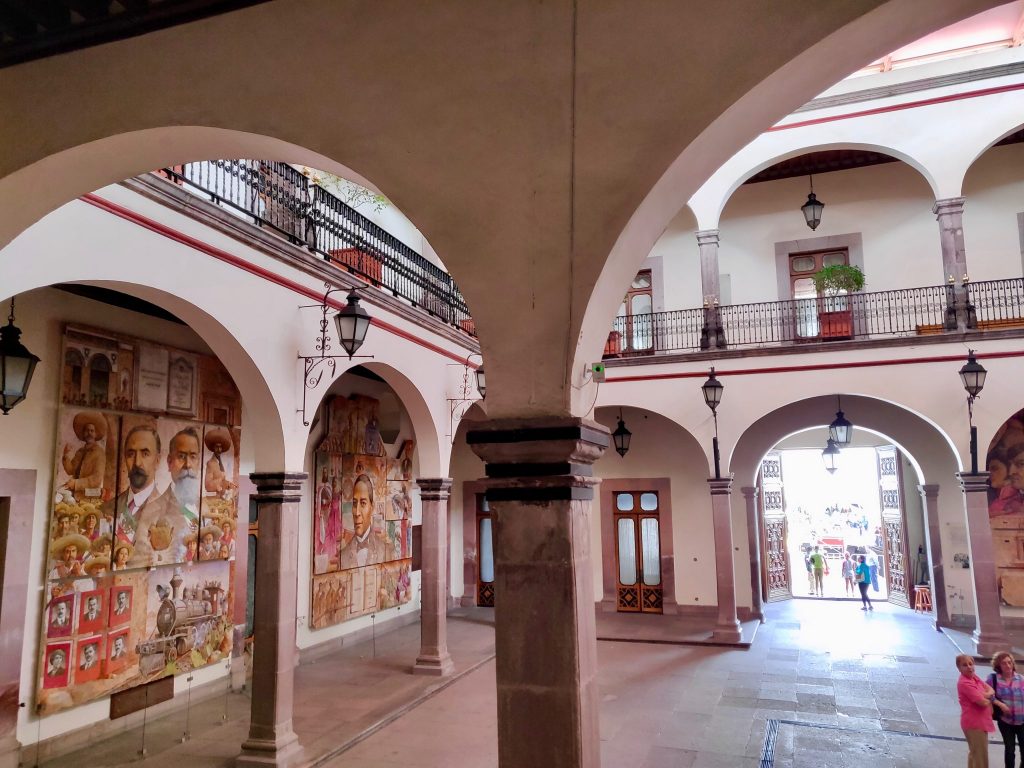
11) Drink Craft Beer in Queretaro
While Queretaro is renown in Mexico for its vineyards, we also find that the local cerveza artesanal (craft beer) to have a strong presence throughout the city. There are few different breweries and taprooms you can find while strolling around Queretaro Centro. So visiting breweries and sampling the local cervezas definitely makes for a fun thing to do in Queretaro!
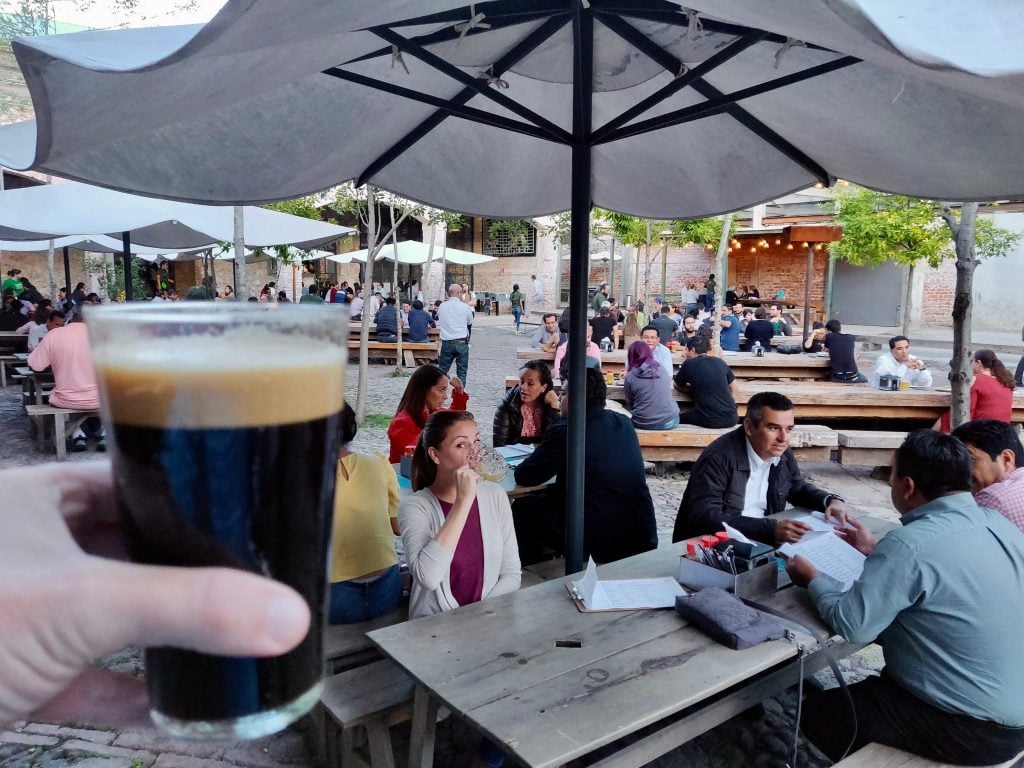
For example, Brewer Gastropub has six tasty taps, three of which were their own brews, ranging from $65-$75 pesos for a beer. A nice food menu compliments the beers. Meanwhile, Tap Room 27 , a new brewpub in Queretaro, offers their own beer on a promotion of two-for-$130 pesos at the cozy & friendly corner bar.
But it is Cerveza Hercules that impressed us the most. You can find their beers at some of the better bars, cantinas, and pubs throughout Queretaro. But if you like beer, then we highly recommend making the extra effort to visit their brewery and beer garden, located about 15-20 minutes by Uber/taxi from Queretaro centro.
It’s a beautiful outdoor setting, with communal tables in a big open-air courtyard with mountains as a backdrop. Yet Cerveza Hercules has some well-produced brews to match this cool atmosphere. International styles served at this brewery will take your taste buds on a trip around the world, with proper English brown ales, Czech pilsners, German schwarzbier, Belgian old bruins, American west-coast style IPAs, and many more. There are a total of 15 taps here and prices range depending on style and glass size, with pints averaging around $75-$85 pesos. There’s good food here too, ranging from ceviche to pizza.
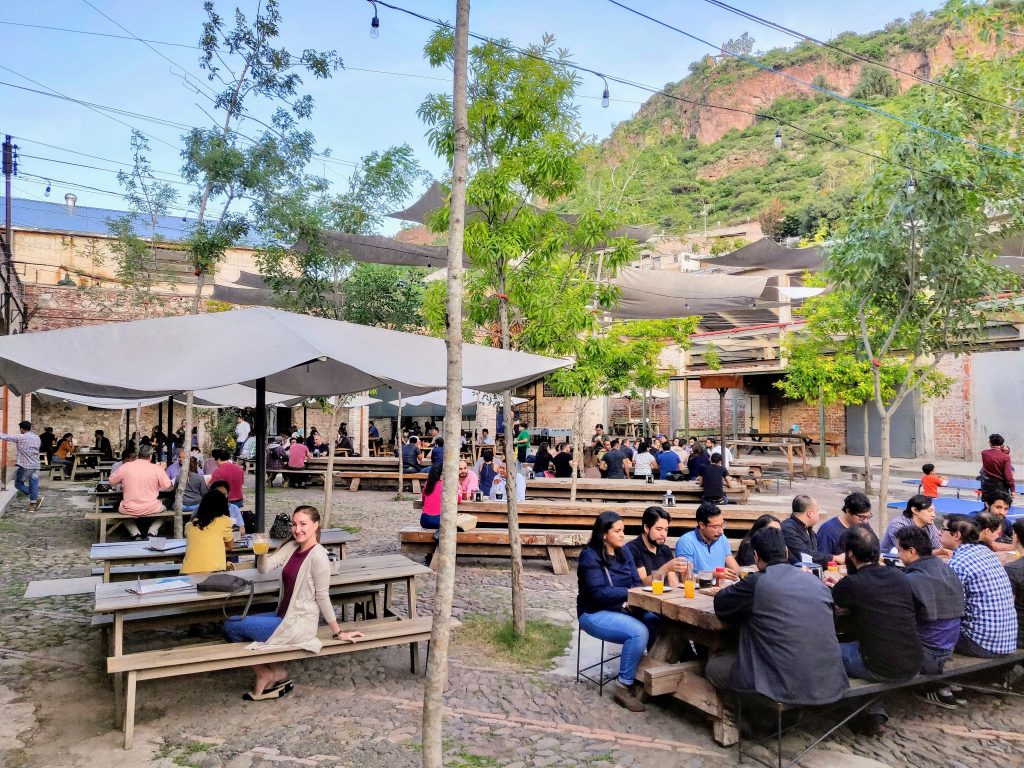
12) Go Shopping for Indigenous Crafts in Queretaro
Shopping isn’t something we usually recommend in our travel guides, as we personally are not ones to buy many souvenirs during our travels. Yet we’d be doing you and the Queretaro’s street vendors a disservice by not mentioning the many handicrafts you can purchase from indigenous communities surrounding Queretaro.
Sure, you can find tourist trinkets like keychains and t-shirts. But there are some beautiful and unique crafts, jewelry, and traditional wares that you can buy from stands set up right from within Queretaro’s pedestrian streets. Much of it is handmade. (We’ve gotten pretty good at spotting the fake cheap Chinese-made souvenirs and we didn’t see such items being sold here.) Local artisans come in from the communities surrounding Queretaro to sell their wares in the city.
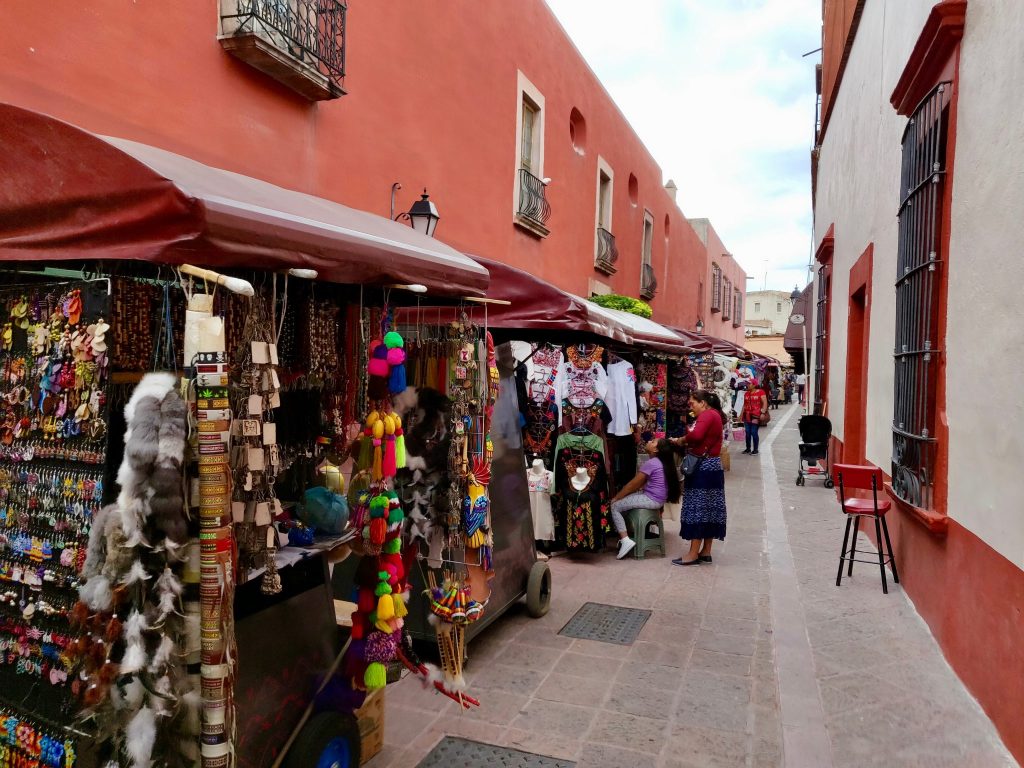
13) Attend an Event or Fiesta in Queretaro
There seems to always be events happening throughout Queretaro. Whether it’s Semana Santa festivities in the Spring, Dia de los Muertos in the Fall, or the many annual fiestas that occur nearly every week to celebrate something, there are constantly events popping up in Queretaro.
Independence Day celebrations are particularly strong here, given Queretaro’s strong ties to Mexican independence. Usually, it’s a weeklong celebration of happenings in Queretaro, rather than the single day of September 16. Expect to hear many cohetes (loud Mexican fireworks) that week!
Outside of major holidays in Queretaro, you can still find many concerts, art shows, children’s activities, dance performances, and other special events. When we were last in Queretaro (July), a big international Jazz Festival was taking place throughout the city. Shortly after that is when Queretaro’s famous vendimia (grape harvest) celebrations began. Then the annual water fiesta is held, during which visitors may get wet! There’s always something going on in Queretaro!
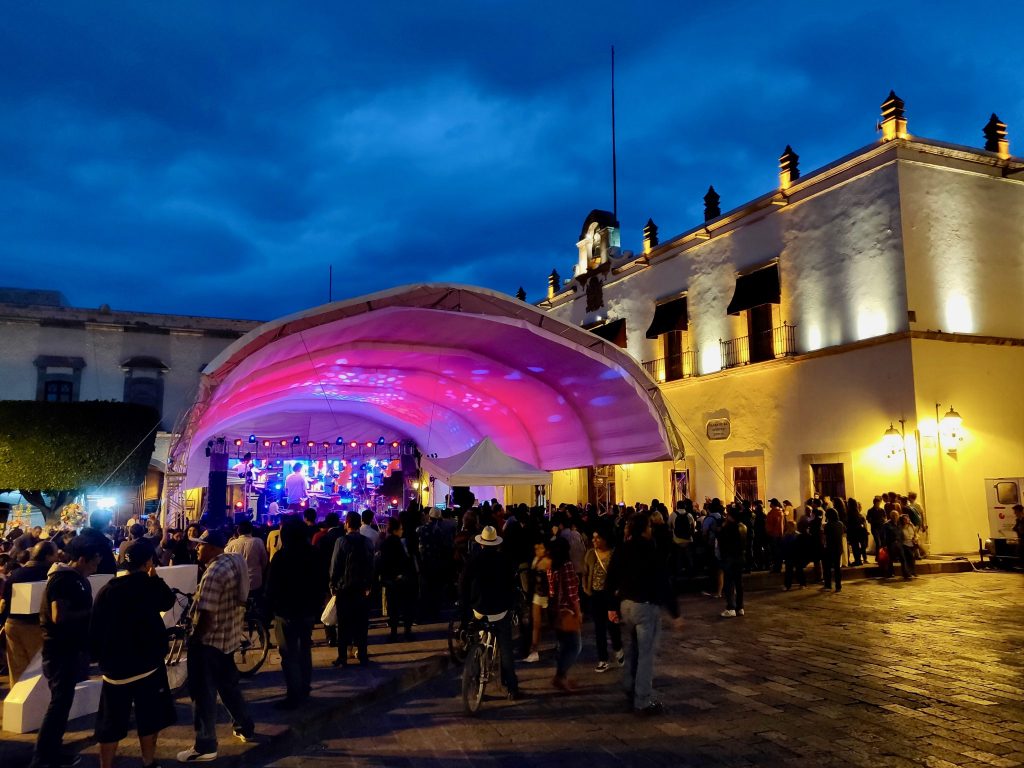
When arriving in Queretaro, we suggest picking up a free copy of the Cultura QRO magazine to see what’s going on. Find it at either the Secretary of Tourism office or the City Museum, among other places.
Or check the city’s website with recommended events and calendar for your travel dates. Just beware that this calendar doesn’t tend to be updated until the dates get closer. So it may falsely appear empty if you’re looking at events in Queretaro far in advance from now.
14) Unwind at an Outdoor Patio Bar or Cafe
Since we’ve been talking about both drinking wine and beer as great things to do in Queretaro, perhaps this is a good place to mention the fantastic outdoor cafes and patio restaurants sprinkled all throughout Queretaro’s historic centro. These establishments line the pedestrian streets and surround the plazas. It would be wrong traveling to Queretaro without stopping into one for a refreshment.
While ambling amongst all those monuments, churches and museums, these patio cafes are here to tempt you when happy hour rolls around. Hanks and Cantina Comalli both have daily drink specials with tables overlooking the wide Plaza Constitucion and its big fountain.
Yet we found that arguably the best brew-with-a-view in Queretaro to be at Corregidora . Go early to snag one of only four tables on the second-floor balcony which overlooks Jardin Zenea down below. To help motivate your early arrival, they even promote $45-peso liters of beer Wednesday to Saturday until 6:00 pm. ¡Salud! 🍻
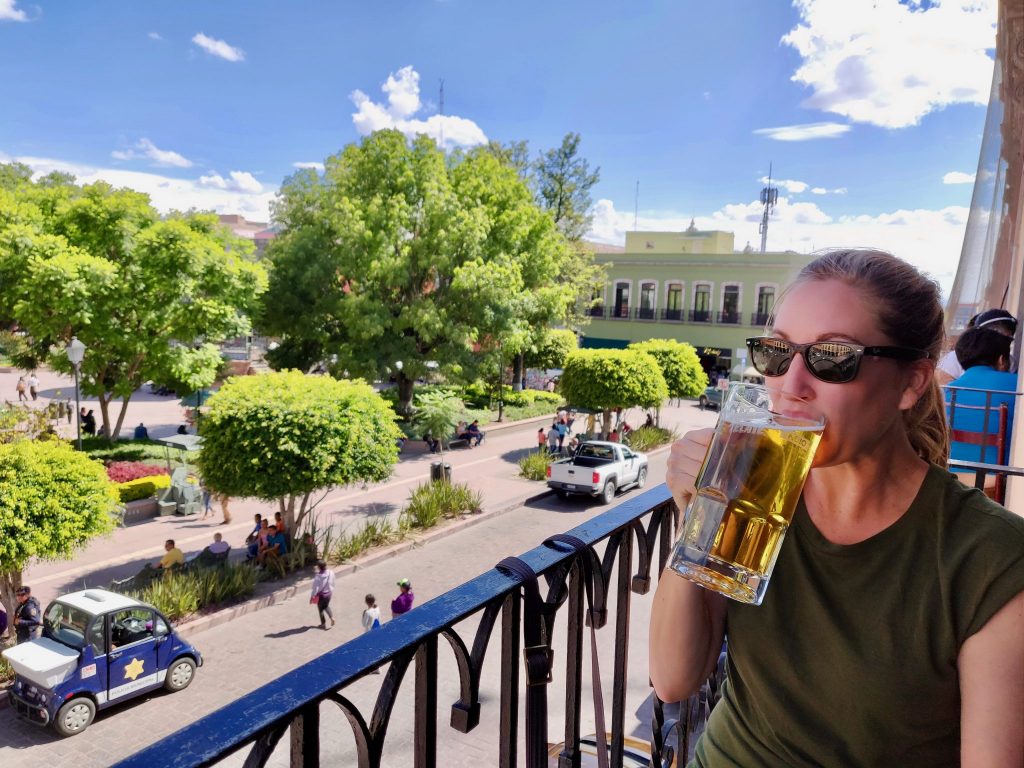
Not into drinking? Then grab a coffee at an outdoor café. Better yet, get some ice cream . There’s no shortage of ice cream shops, which carry flavors local to Queretaro, such as montecado ice cream.
The point here is not necessarily about drinking. Rather, it’s finding a perfect spot to chill out in Queretaro Centro’s remarkable surroundings.
15) Check Out Queretaro’s Roman-Style Aqueduct
Is that really a Roman-style aqueduct running through streets of this sprawling Mexican city? Yup, it sure is!
This nearly 2-kilometer long aqueduct was built way back in the early 1700’s. It remains one of the few colonial aqueducts left in Mexico today.
Looming 100 feet (30 meters) high, the 75 arches have been delivering water from the surrounding mountains into the city center for centuries.

The aqueduct slices right through the city over one of Queretaro’s roadways. It’s easy to get up close to the aqueduct by taking a stroll down to Calzada de los Arcos. Yet the best panoramic views of Queretaro’s famous aqueduct are from the lookout point on the eastern edge of centro: Mirador de Los Arcos .
Are You Packed And Ready To Experience the Best of Queretaro?
Before you depart on your trip to Queretaro, here are a few final preparations to consider:
- If you travel there between June and October, be sure to pack some rain gear as there tend to be showers that briefly come about in the late afternoons. ☔
- To ensure you haven’t forgotten anything important, you can check out our Ultimate Packing Checklist which is full of packing tips and recommendations. 💼
- Have You Purchased Your Travel Insurance Yet? You never know what could go wrong during a trip to Mexico. Possibilities include getting sick, a flight gets canceled, natural disasters (thankfully, Queretaro is mostly outside the active tectonic area), lost baggage, your phone goes missing, etc. Travel insurance will have you covered. We never roam around Mexico without travel insurance. We use and have been happy with World Nomads , with what we’ve found to have the best price and coverage combination. Enter the dates for your trip to get a quick estimate. ⚠️
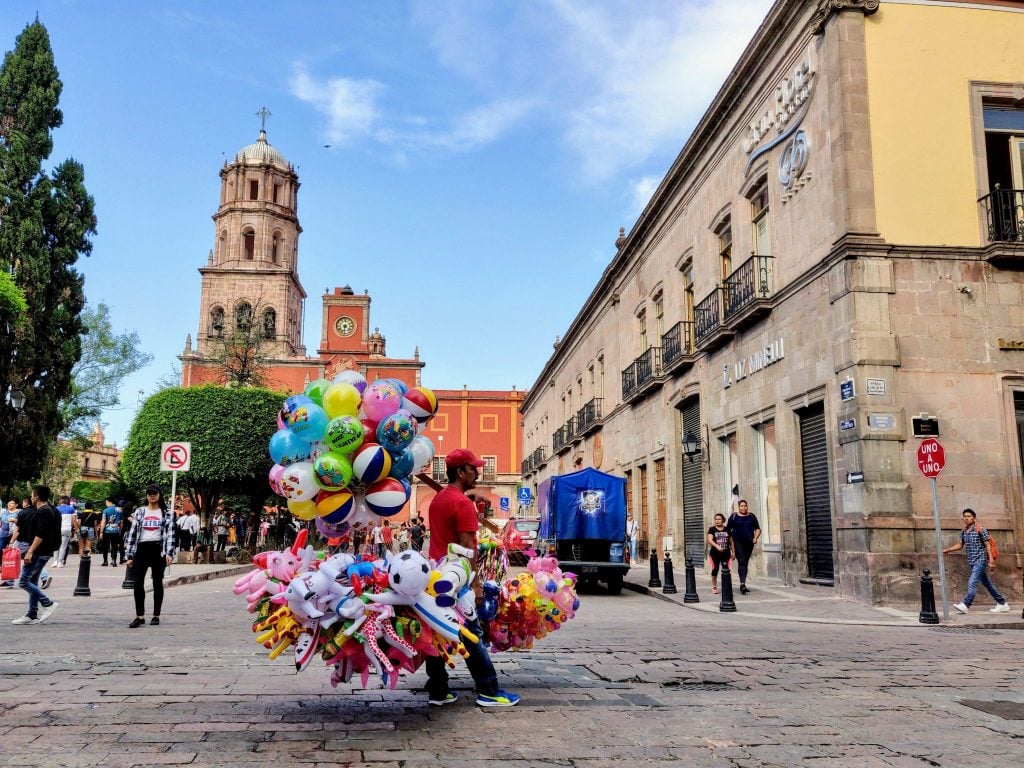
- 75+ Best Mexico Travel Tips to Know Before Your Trip in 2022
- Best Things To Do In Guanajuato Mexico
- Best Things To Do In Oaxaca Mexico
- Best Things To Do in San Cristobal de las Casas
- Best Things To Do in Merida Mexico
Best Things to Do in Queretaro?
So those are what we’ve found are the best things to do in Queretaro. Have you been? What are some of your favorite activities to do in Queretaro? Let us know in the comments below.

Most of all, have a wonderful trip to Queretaro, Mexico!
Also if you found this post helpful, let’s stay connected! If you enjoy travel, you may like our Facebook Page ,👍 where we dish out travel inspiration and travel tips from wherever in the world we may be roaming around.
If you want to save this post for later, be sure to bookmark this page. Or pin the image to the right to your travel Pinterest boards.
Related Posts
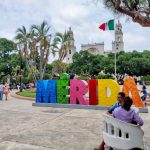
March 24, 2023 at 8:01 AM
I read it all in one breath. It is a wonderful travel and culture article.
November 3, 2022 at 11:39 AM
Our daughter married Roberto, who lived here, in the Eugene, OR area when we met him and after 2 years, they moved to Queretaro where his family lives. 6 days later we visited for 2 weeks. So we all did the tourist thing together. Also, one of my High School classmates lives there in a very nice gated community, half the year to be near a married daughter and grandkids. She took me to lunch in a restaurant in the Centro area. I asked my son-in-law if he had ever gone to that place and he said no, that it was for the rich people! I was told it is the small city outside Mexico City that is only 3 million instead of 25 million people! So to me, Queretaro is still a huge city! We did a lot of shopping with them and three of our other grown kids. In the big market in a warehouse which may be the one mentioned here, I actually found my Mother-of-the Bride dress for our next daughter’s wedding! To try it on, they arranged the mannequins to create a sort of screen! We also tried lots of restaurants. I was always grateful because the restaurants had bathrooms! I have not seen anyone mention that you need to carry 5 peso coins to spend for the bathrooms. Most places have no seat on the toilets, just to warn you! In case you don’t live in the country with a well and have learned to flush toilets with a bucket of water when the power goes out, you will find that set up in various places from a church, gas stations and even the parking lot at the Basilica of Our Lady of Guadalupe in Mexico City. Also, you have to throw your toilet paper away in the waste basket because the concrete pipes for sewage can snag the paper and plug up the municipal plumbing! You are given a good amount of toilet paper when you pay but I carried my own on subsequent trips! If you are used to camping without an RV, it will be fine but we know family that would not be able to handle some of the “roughing it”. I also learned there are no rest areas, so on a couple of our 4 hour drives, they would stop by the roadside where there were bushes, say for our grandsons! Fortunately that was never an issue. I became very aware of planning around the locations of the bathrooms, or finding one before you needed it. CostCo has PVC plumbing and you can flush your TP there! We did go to Bernal and loved it. It was by far cleaner than any place else we went. We learned it is funded by the government as a tourist destination and our son-in-law had some disdain about the inequity of it all, when we traveled down there again. (He boycotts Cancun as well…whole story behind that) While dining in Bernal, on top of a 3 story building, a whole parade of about 100 dressed up horses and riders came down one of the side streets, along with a brass band on a trailer. They were headed to the Square by St. Sebastian Church. (all the main squares in the towns are by the churches) It must have been quite the sensation because all the waiters were leaning over the wall to watch, along with us! They gathered roughly in a circle and took turns showing off their horse’s dancing and style, one at a time, kinda like when folks dance in a circle with one after another taking their turn in the center to “show their stuff”! I don’t know how you would find out when something like that is going to happen, but it was well worth the special experience. There is a place nearby, like an hour and a half drive, called the Geyser. It is hidden away gem and you really have to know how to get there. Roberto’s dad plays in a Huapongo Band, mostly in Texas but locally as well, and he loves to go soak in the hot, sulfur smelling water to get a health rejuvenation after a long road trip! There is also a kiddie pool with lots of slides and fountains. A zip line is up the hill for adults. We have gone several times and it is quite the resort for Mexicans. The equivalent of $7 American gets you in for 24 hours. There is hotel but we just went for the day. Some pitch a small tent. There are many temperatures of hot pools and tables to picnic at with thatched roofs (bring your own chairs). You can buy food and drink but we mostly brought our own. The most sought after part is where the steam blasts out clouds and people stand in them breathing in the therapeutic benefits! Really hot up close and cooler farther back. They have fashioned concrete caves with benches to hang out in, enjoying the steam. It is also a very clean spot with awesome bathrooms! WooHoo! My youngest son who has rented a car there and even driven in Mexico City, says to make sure you do not get a gutless car with no power. You need to to able to react quickly and move fast to keep up with the traffic pace there. Queretaro was much calmer traffic-wise than Mexico City. Yes, lots of buses are available and Roberto’s family rides the bus a lot, everywhere. His mom even rode 19 hours to Manzanillo, to pick up items we sent down for our daughter, when our son was vacationing there with the band he plays in. We were there during the Feast of Our Lady of Guadalupe, Dec. 12th, and did visit the Basilica in Mexico City, 2 days before that. A lot was already going on with groups of school children all dressed alike, farmers bringing huge produce offerings, bands and pilgrims. Masses in different languages were being celebrated one after another in the new church where the Tilma is on display and in the old church with the uneven floor. Christmastime is a huge deal here and this feast day is majorly celebrated everywhere. So while having ice cream one night, a whole parade of dancers, machete wielding “natives” and folks bearing huge bags of onions, potatoes, etc. all processed through the street accompanied by fire works and processed into the church across the street. And after the feast day, they have Las Posadas in the interim until Christmas. For one night, Roberto’s family joins several blocks of homes and businesses, blocking the streets, sharing food and music outside and always a piñata! The same happens all over the city and anyone is welcome. It was a lovely experience. We have been 4 times so far and can’t wait to go back! We do always fly into Queretaro now. Once landing in Mexico City was enough! I would be glad to share pictures if there is a way!
July 1, 2023 at 10:50 PM
I loved reading your detailed review and I want to go even more now! It sounds absolutely amazing and hope to take my children to experience all of this one day soon.
October 3, 2021 at 7:22 PM
Thank you for all of this good information regarding this amazing city. I am wondering about costs. When you say something costs $30 pesos does the $30 mean the item costs $30 American money?
October 7, 2021 at 3:39 PM
Glad to hear this was helpful. When listing the prices in pesos, we are referring to the local Mexican currency. So for example, $30 pesos is $1.45 USD, using today’s exchange rate. You can check xe.com for up-to-date currency conversions. You will need to use pesos locally, as American money is generally not accepted.
December 15, 2021 at 2:06 PM
$20 pesos (mxn) is 1 USD so no not in US dollars.
February 18, 2020 at 12:04 AM
Hello! I will be visiting for only 3 days. I am staying in aloft Querétaro hotel but no idea what to do. I will have one day free and a half free. Can you please suggest a one day itineary? This is a work trip and I’m leaving by the end of this month! All suggestions and detailed advice is appreciated. BTW I live your blog!
Thank you!!
February 20, 2020 at 12:31 PM
With one day free, I’d suggest staying in Querétaro centro and trying to pack in all that you can within a day.
Many of the recommended things to do throughout this guide are walkable and within close proximity to each other, so it can be easy to hit up many places all within one day. In a single day, focus on Querétaro’s historic center and don’t wander out to the wineries or Bernal. Instead, visit Querétaro’s churches, wander around Querétaro’s monuments and plazas, see the aqueduct, and go to a museum or two that is of interest to you. Along they way, go to the local market, have a good lunch somewhere, take a glance at public buildings like the government place and theatre. Use the map in this guide to form a practical walking route, connecting the places of interest. Also know that many of the buildings/churches/aqueduct are just interesting places to walk by and simply have a quick look or pop-in that don’t take much time. Hence, they can be easy to cover in a day.
In addition to the main churches, buildings, monuments, and plazas within Querétaro centro, you may also have time to squeeze in the El Cerrito ruins or Cerro de las Campanas National Park. Personally, we find El Cerrito ruins to be more impressive (just our two-cents). But Cerro de las Campanas is closer, way more convenient, longer hours, and hence may be more practical. The history there is quite interesting too.
Hope that helps! 🙂
December 23, 2019 at 8:32 PM
Hello, and thank you for the many tips you gave in your post! We want to retire early in Mexico in a couple of years and we visited (besides Cancun resorts :)) the city of Merida and Mexico City. The latter is too busy and crazy for us, and Merida is too hot + we saw a snake and countless blizzards while there. I am ok with lizzards, but cannot see snakes or scorpions. They are the fear of my life… So Merida is out. I was looking for safe cities, cultural, and the size of Merida, and that’s when I found Queretaro. My question is – if I get a place with a bit of garden, will I have to fear at all the snakes? I see the temps are very temperate, so I don’t think it is like in the Yucatan, but do you know anything more on this topic from visiting, living there for a while, talking to people there? If no issue, then we would love to visit Queretaro and even move there in 2 years! Thank you so much!
December 29, 2019 at 2:13 PM
There are snakes species that can be found in Queretaro (and all throughout Mexico). But I don’t believe snakes are particularly common within the city of Queretaro. We’ve spent a few years worth of time in the central highlands of Mexico, in Queretaro and neighboring/nearby states that share a similar climate and geography. During that time, I can only recall seeing snakes on two different occasions. Both instances while hiking in the mountains. (Meanwhile, we’ve seen several snakes throughout the Yucatan.) I can’t guarantee that you’d never ever encounter a snake in Queretaro if living there. But I certainly wouldn’t let it prevent you from taking a scouting visit to get a better feel for it and find out more. Hope that may help. 🙂
December 29, 2019 at 2:30 PM
Yes, thank you, this helps a lot! It is hard to get this information unless I specifically ask – in youtube videos nobody mentions it… The best intel I get from people like you that live there. I needed to find this out before planning a visit, which is costly. Thanks again and happy new year! 🙂 Mihaela
November 8, 2019 at 11:55 AM
We have been spending time in Mexico for well over 20 years had attempted to get to QRO for about 10 years but time, scheduling and other things kept us around but never in the area.
About 5 years ago we stayed for a couple of weeks. We are now in the club that puts Querétaro on the top of our inland favourites we’ve been going back for extended stays almost every year since.
We’ve made friends there, one will be joining in Valladolid in a couple of weeks.
Your stated preference for QRO over San Miguel de Allende matches our own choice. Each trip to the area we give San Miguel another opportunity but it just doesn’t work for us.
Thanks for these best of summaries.
June 15, 2019 at 6:07 PM
I have heard that Queretaro is known for Fire Opals If this is true would you have any information on where to purchase them while visiting?
June 19, 2019 at 7:50 PM
Opals are indeed found throughout the mines of Queretaro state. It’s even possible to tour the opal mines near San Juan del Rio and Tequisquiapan from the small pueblo of La Trinidad, about an hour’s drive from Queretaro City. It’s there in La Trinidad that you can also find vendors selling opals that I’d presume likely include the fire opals you’re looking for. You may also be able to find them in jewlery stores in Queretaro city itself, or they can at least help to steer you in the right direction of where to find them in the city if you can’t venture out to the mines themselves. Hope that helps! 🙂
June 13, 2019 at 8:17 PM
We love Quéretaro! Going back this summer with our two kiddos. We went a few years ago, and to Bernal, which was unbelievably beautiful! In Qtro, my kids were mesmerized by the shoe-shiners in the plaza for a good 45 minutes. I had to PEEL my 6-year-old daughter away!! Mexico is such a kid-friendly country, we so enjoy traveling around every summer (my husband is from Gto)
June 19, 2019 at 8:02 PM
Right on! 🙂 I bet Quéretaro can be a lot of fun for the kiddos. Funny to hear it’s the shoeshiners that they were impressed by. I’d imagine they’d gravitate towards the balloons or the big inflatable pencil-shaped things that bounce into the air that we often see the niños playing with in Queretaro’s plazas. Hope you and your family have yet another great summer exploring Mexico!
July 15, 2019 at 6:09 PM
Hey, we’re in Queretaro now with our two kids, ages 4 and 5. What could we do I’m Bernal with them? Thanks
July 26, 2019 at 1:52 PM
Not sure if this reply has reached you in time, but there are a few things to do with kiddos in Bernal in addition to simply enjoying the small town. It may be best to avoid hiking up Peña de Bernal, as it may not be suitable for young kids. There are some steep drop-offs too. Even so, it’s still well worth going to the base of the rock to check it out and photo ops. There are local dulce (candy) shops in Bernal that kids would likely appreciate. There’s also a trolley ride that goes around town that could be fun for them while making it easy for parents see the town on a short guided tour. If you’ve already gone Bernal with your children, please do let us how it went from the kids perspective. Happy travels!
March 13, 2019 at 4:36 PM
I met the love of my life there in 2010, got married there in 2013, and we had our kids baptized there in 2015 and 2018 (all at Parroquia de San Sebastian, btw, where my wife’s grandmother was baptized in the 1930s and then her mom in the 50s!)!! So yeah, I’m kind of partial to Queretaro! You guys nailed it with the list of what to do in the city, so I’m going to add a couple of excursions to this–you mentioned Bernal which is fantastic. I would add Amealco to the list–small town about 30 minutes away, very indigenous, you’ll hear lots of Otomi spoken here. Home of the little “Maria” dolls. Tequisquiapan is gorgeous, especially around Christmas. Lots of gourmet cheeses and wine. Cadereyta is another beautiful town to explore. San Joaquin sits at the foothills of the Sierra Gorda, beautiful little hilly mining town, apple trees and products everywhere, with some excellent ruins sites and waterfalls nearby. North of San Joaquin you’ll find all the mountain towns–Pinal de Amoles, Jalpan, Penamiller, etc, and the Franciscan Mission churches of Junipero Serra. And, don’t forget that Queretaro is only about 45 minutes from San Miguel de Allende and other beautiful historic cities and towns in Guanajuato. Honestly I could go on and on, I’m blessed to have family there that we adventure and party with whenever we’re there. So, I was so happy to find this blog today–I’m happy to see people that love this city as much as I do. Que les vaya muy bien amigos.
March 18, 2019 at 2:51 PM
So awesome to hear your personal history with Queretaro and your mutual love for this special place in Mexico! Thank you so much for all of these fantastic excursion suggestions! We’re actually heading back to central Mexico for another extended stay this summer, so perhaps we’ll make it back to QRO to check them out. We’ve been yearning to venture out to the Sierra Gorda area. Yet all those other towns you’ve suggested sound so intriguing! We may just need to rent a car for a few days, hit the road, and have a look around all of these recommendations. Muchas gracias! 🙂
March 25, 2019 at 2:39 PM
Saludos Larry, We are thinking of visiting Queretaro end of May for my husbands 75th birthday. We’ve been to San Miguel and Guadalajara – one too small to consider living there and one too large, but Queretaro sounds perfect. Any suggestions about good areas to live where it would be one level? Also any really good Mexican hotel suggestions? We never stay in American or large hotels. In Guadalajara we had one for $52 a night just off the main square. They were fantastic and had a driver for long explores. I do speak Spanish quite well and my husband is learning. Thanks for any suggestions. Best regards, Lynda
April 19, 2019 at 7:05 PM
Saludos Lynda, I’m not so familiar with specific neighborhoods that might have what you’re looking for, but it seems like the neighborhood around the acueducto has homes like what you describe. The only downtown, historic, colonial hotel I have personally seen is Casa del Atrio, my friends stayed there last summer for a few days when we were down there. It was beautiful, and they loved it—google it. It was more like $100 per night though, if I remember right. I hope you and your husband love Querétaro!
April 15, 2019 at 12:31 PM
I am planning to take a trip to San Miguel de Allende, but also would like to explore other areas close by.. You mentioned Waterfalls, and that is what my group is looking for aside from side seeing. What do you recommend, visit San Miguel de Allende first and or Queretaro first? Also, since you are so familiar with the area, where should most of our stay be spent (SMA or Queretaro). It almost sounds as if there is a lot more to do around Q. You suggestions will be greatly appreciated. Oh, also, is it worth renting a car?
April 18, 2019 at 5:04 PM
The logistics of where to go first would depend greatly on where you’re coming from and/or where you’re flying in & out of. Deciding where to spend the most time would depend on interests and personal preferences. Most people absolutely love and adore San Miguel de Allende. It’s absolutely beautiful and we like it too. But truth be told, we prefer Queretaro. Yet that’s just our preference. Really, there’s lots to do in and around both cities. Maybe split the time? As for a rental car, it could prove convenient for a group. But every place mentioned in this guide can be accessed by public transport or tour.
April 19, 2019 at 6:55 PM
Norma, i agree with John, it just depends on your preferences. I think to really do all the things they mention in their article, you need a good 3 days to explore Querétaro, the city. From there you can check maps and go visit some of those other towns I mention. I’m not sure about waterfalls around San Miguel—you’ll start to find waterfalls in the mountainous areas of Querétaro state, like Cadereyta and San Joaquin and north of there. As for San Miguel de Allende, it’s great too, I just have never spent a lot of time there. There also lots of other beautiful towns and things to explore around San Miguel too, like Dolores Hidalgo, santuario de Atotonilco, Mineral de Pozos, doctor mora, to name a few. If that’s what you’re interested in, “puebleando” like they say, I’d probably get a car. Whatever you decide to do, you’ll love it.
March 6, 2019 at 4:42 PM
Great article… I visited QRO last summer for work and fell in love with the city, the people and the culture. Looking to go back and take my family. Uber and taxis are totally safe. I wandered the centre for hours by myself as a woman and never once felt out of place or unsafe… of course, don’t be foolish. I do recommend Dona Urraca as a fabulous hotel. Puts you in the center of most of the pictures above. Next time I will get more pesos to benefit form the pop-up food festivals and fun. I wouldn’t spend a week here… but 2-3 days and maybe a bus ride to Mexico City (as my co-worker did). However, I will say, I could retire to Queretaro! Would be fabulous.
March 8, 2019 at 8:00 AM
So glad to hear from another QRO-lover! 🙂 Such a great city in Mexico! I’d agree that spending 2-3 days feels about right for the city itself. Although perhaps an extra day or two if pursuing lots of day trips from the city. I think there are some people that definitely share your sentiment about wanting to retire in Queretaro, as we noticed some expat retirees beginning to trickle in. Heck, we’d retire there in a heartbeat ourselves. Love QRO!
January 9, 2019 at 11:34 AM
What a great article! I am traveling to Querétaro for a few days in February for my friend’s wedding. I am looking forward to exploring during my free time, it looks like a beautiful city. I am a bit nervous about traveling from the airport to the city center by myself. Are taxis and Uber considered safe modes of transport?
January 15, 2019 at 9:24 AM
Glad it helped and hope you have a great visit to Querétaro in February! You’ll be totally fine traveling from the airport to the city. We’ve never flown into Querétaro personally, but at most airports in Mexico, there is a taxi kiosk where you purchase your taxi fare from, which makes things easy. We found both taxi and Uber to be quite safe and reliable throughout Querétaro. We tend to prefer Uber to get around, for a few reasons. You input the destination, so no need to explain directions in Spanish to a taxi driver. Your route and everything is all tracked through the Uber system, so that adds a layer of security. And no need to negotiate fares. All of our Uber drivers in Querétaro were not only excellent and safe but also tended to be quite friendly.
March 2, 2019 at 9:56 PM
Great article John. I’ve traveled to Queretaro multiple times for work. And as a non spanish speaking American womay, I do find going about the city very safe. Because don’t speak the language I will add that most people in Queretaro don’t speak English. For example, 1 out of 20 uber drivers I’d be lucky to get English. I am luckier at restaurants. Wondering John if you found great restaurants to share.
March 3, 2019 at 12:12 PM
Yes, Queretaro is definitely a very Spanish-speaking city. We also found little English spoken and that knowing some Spanish basics can prove so helpful while going about this city. Regarding restaurants, there are lots of great ones throughout QRO! During our time there, we stayed in an apartment outside the city center, so often ate at little local joints in our neighborhood and took advantage of our kitchen by cooking up the fun ingredients we found at the market. As a result, we didn’t get a chance to explore Queretaro’s dining scene with the depth we normally would. That said, Hacienda La Laborcilla, is widely regarded as one of the best restaurants in town and sports a beautiful setting. The Brewer Gastro Pub may be known for beer, but they’re dishing out some incredible food too. We further really enjoyed the Oaxacan fare at Maria y Su Bici. So perhaps that may give you just a few leads. 🙂
January 3, 2019 at 5:28 PM
You should also know that Querétaro is one of the most important idnustrial cities of Mexico. Largely peopled by middle and upper middle class, who live in the sourrounding neighbourhoods. It is not a little town. It has everything you expect from a big north american city, including large shopping centers, and of course traffic problems in the Streets. It is strategically situated: from it you can reach many small towns in the same state, of historical and turistic interest. You could rent an appartment and take Querétaro as your hubb to visit the sourroundings. Queretaro state, even small as it isl, has wonderfull places tio visit, and the weather is also really nice, not hot, nor cold. Strongly reccomended.
January 5, 2019 at 2:40 PM
Sí, sí, sí, All very true and many of the aspects that have helped us to enjoy Querétaro so much! 🙂
December 31, 2018 at 7:07 PM
Great article. Expect to visit in May 2019.
January 5, 2019 at 2:46 PM
Hope you enjoy Querétaro as much as we have. Buen viaje! 🙂
September 12, 2018 at 10:33 PM
Excellent post. Thank-you! We are going to Queretaro in few weeks and definitely we will follow your suggestions – and your FB page 🙂
I was wondering if anyone knows about any Spa/Retreat/wellness centre in Queretaro that can recommend. We are looking into taking a day to relax and reset in one of those places.
September 13, 2018 at 2:29 PM
Glad it was helpful! 🙂 We don’t have any first-hand experience with spas or retreats in the area, so will leave this comment up to see if any other readers may be able to chime in. There are some spa hotels in Queretaro city and even Bernal has some too. Check out La Tortuga Xaha Hotel-Spa ( http://latortugavillastemascal.com/ ). Maybe something like that? It sure sounds nice and relaxing. Also, just outside of San Miguel de Allende there is La Gruta Spa, which we’ve been to and enjoyed our day there very much. It’s about 90 minutes from Queretaro. Have a great trip!
August 29, 2018 at 2:34 AM
Mexico has been on my bucket list for quite a while. It has so much to offer I can’t even begin to image a town with a 1000 monuments in it. It would keep me busy for days! I also had no idea that there were so many UNESCO sites. Thanks for a great post1
August 30, 2018 at 3:43 PM
Right? We almost couldn’t believe that there was so many. We probably saw at least a good hundred or so of the monuments. So many fountains, statues, and buildings all over centro! It’s a beautiful thing.
August 28, 2018 at 10:06 PM
I absolutely love this part of Mexico, but haven’t made it to Queretaro yet. I had no idea there was a wine region in this area! The aqueduct reminds me of Morelia, which I think is kind of a similar city in a lot of ways. Adding to the list!
August 30, 2018 at 3:02 PM
Yeah, we didn’t know there was a wine region here either until we arrived. What a pleasant surprise that was to find! The aqueduct is definitely reminiscent of Morelia, as that was actually our next stop after Queretaro. But I will say that the Queretaro aqueduct is much much taller than the one in Morelia. Both great cities though! Hope you do make it to Queretaro! 🙂
August 28, 2018 at 10:12 AM
Oh, a Mexican region I haven’t seen – how nice! My favorite would be the Cerrito – I’ve never seen such a big, overgrown pyramid – amazing! The street scenes bring back wonderful memories of all the Mexican places I’ve seen. It’s a place I’d definitely visit when going back to Mexico – escpecially since it’s not too far from DF and buses in Mexico are pretty comfy.
August 30, 2018 at 3:41 PM
Yeah, it’s only a few hours from DF and they may even build a high-speed rail to connect it in the not-so-distant future. The Cerrito pyramid is pretty impressive! It’s crazy to come across it in the midst of Queretaro’s suburban sprawl. Hope you do get a chance to experience this beautiful city! 🙂
August 28, 2018 at 12:20 AM
Mexico has so many wonderful places and this certainly looks like one which is going on my itinerary. The historic centre is so well-maintained and as you describe it…squeaky-clean. I’m glad i came upon this post.
August 27, 2018 at 6:10 PM
I have to go. Everything looked and sounded picture post-card perfect as I’m a great fan of Mexico and its culture already. Thank you for focusing on this gem and I hope more people do visit (although it sounds pretty popular already.)
August 27, 2018 at 7:14 PM
It is a post-card perfect type of place. But it’s actually not very popular at all, at least not on a global scale anyway. Queretaro does receive some domestic tourism, but we felt like it was a very underappreciated place in Mexico. Hope you do get a chance to make it there! 🙂
August 27, 2018 at 3:15 PM
Wow you think you know a country. I have never heard of Queretaro – it is so beautiful, and it does seem quaint despite having a million people. There is no shortage of things to do – ancient pyramids, nature, wineries! What is the internet situation like there? A place that someone could stay for a while and work on line?
August 27, 2018 at 7:20 PM
We had barely heard about it either before venturing over there and was pleasantly surprised at what an awesome find it was in Mexico. Internet speeds are good. We were clocking in about 10-15 mbps at the Airbnb we stayed at, but there is higher speed available. It’s definitely somewhere you could stay and work online for a while. That’s exactly what we were doing there actually.
August 27, 2018 at 11:32 AM
Gosh I’ve never heard of Querétaro and I certainly didn’t realise Mexico had so many UNESCO sites. So many fascinating things in the area too – I’d love to visit the Ancient Pyramid at El Cerrito
August 26, 2018 at 6:34 AM
wow very detailed information on what to do. What love to visit mexico sometime and i think it should be on everyone’s bucket list of place to go to.
August 25, 2018 at 6:46 PM
University towns are so much fun to visit. 1400 monuments is a crazy amount to discover! Love the image of Peña de Bernal above the city. And I would like to check out the Pyramid at El Cerrito
August 25, 2018 at 2:28 PM
Queretaro looks like a fantastic place to visit and would love to check it out. I love the brick arches as seen on the photo and the size of the beers, I am there! How many of those large beers did you have that day? 😉 I think I had about six like that in Germany once in an evening and I was on the floor. Oppsie. Still planning a trip to Mexico soon so I hope I can visit this part of the country.
August 22, 2018 at 1:42 AM
Nothing here on how to get there. How far from nearest Airport ect.
August 22, 2018 at 10:29 AM
Querétaro Intercontinental Airport is located 22 kms east of the city. A taxi from the airport to Centro takes about 30 minutes or so. The Queretaro airport has connections to many domestic destinations all across Mexico in addition to Atlanta, Detroit, Dallas / Ft Worth, Houston, and Chicago. You can also easily reach Queretaro by bus, after flying into Mexico City. Buses from Mexico City to Queretaro depart regularly and it takes a bit more than three hours. There has also been some discussion about the possibility of a high speed rail to Queretaro. But if that does come to fruition, it will be many years from now.
Leave a Reply Cancel reply
Your email address will not be published. Required fields are marked *
Don't subscribe All new comments Replies to my comments Notify me of followup comments via e-mail.

Unmissable 23 things to do in Queretaro, Mexico, and its Surroundings

Disclaimer: This page may contain affiliate links. If you make a purchase using one of those links, I may earn a commission at zero cost for you. Please see my disclaimer policy here, and my privacy policy here.
This is your complete guide to all the amazing things to do in Queretaro, Mexico, and the spectacular surrounding region.
Travel to the Pueblos Magicos of Tequisquiapan with its lush vineyards and Bernal with its unique monolith. Then get off the beaten path in places like the spectacular Sierra Gorda and much more!
I’d always heard about the quaint historic city of Santiago de Querétaro. When I finally made it there, I took an entire week to browse around the city, meet local people, visit the museums, and try the many different restaurants available.
I loved it so much that I went back 3 years later to visit Queretaro again, this time staying for an entire month. I cherished my time sitting in the many different restaurants and cafes while working from my computer, living like a local.
My time in this enchanting place taught me a lot, and I’m happy to share that with you here. In this article, I’ll discuss all the best things to do in Queretaro.
What is Queretaro known for?
The city of Queretaro is quite literally an open-air museum showcasing baroque architecture with its antique houses, majestic churches and monasteries, quaint plazas, and many art and history museums.
Queretaro is also surrounded by other charming towns, especially the aptly named Pueblos Magicos , which are close enough for a day trip.
Plus, the city is just a “stone’s throw” from the fascinating Sierra Gorda , which I visited on my way to the Huasteca Potosina .
Oh! And if you are looking for a place to stay, you can check out my guide to Queretaro hotels or my top Queretaro Airbnb suggestions if you prefer to stay in an apartment, as I do.
Okay, so let’s now talk about what to do in Queretaro in this comprehensive guide!
Things to do in Queretaro , Mexico
First and foremost, it should be noted that all museums are closed on Monday, so plan accordingly.

1. Wander around the artsy historical center
Get lost walking around the historical center, remembering to look up and check the old houses’ tiled rooftops, their decorated and multicolored walls, and antique doors. Check out the church’s architecture and the heavy Baroque-style interiors, too.

2. Temple de Santa Rosa de Viterbo
Visit the Temple de Santa Rosa de Viterbo, which besides exhibiting some of the most beautiful architecture you’ll find anywhere, also regularly hosts unique art expositions.

3. Temple and Church of Santa Cruz
Visit the Temple and Church of Santa Cruz and take a guided tour there. It’s only 20 pesos, and the young volunteer guides will tell you all the history as well as stories and legends about Santiago Queretaro, the monastery, and how it was founded.

4. Take a look at the old aqueduct from the Mirador
Visit the “mirador“ or lookout, just behind the Templo of Santa Cruz, where you can admire stunning views of Queretaro’s historical Aqueduct.
If you walk down the hill on the other side of the “mirador”, you will find yourself underneath the arches, a great spot for a night photo shoot.
Exploring this area in the early evening was one of my favorite things to do in Queretaro.

5. Have breakfast at La Biznaga
Among the most unique foodie spots in Queretaro, La Biznaga makes for quite a remarkable gastronomic experience.
The popular restaurant is characterized by multicolored and artistic decorations and great food.

6. Visit the popular Museum of Art of Queretaro
This excellent museum is definitely worth a visit. It’s full of temporary and permanent artworks in its multiple rooms.
For lovers of traditional art, this Queretaro landmark is a must-see.

7. Stroll around Plaza de Armas
Visit the Plaza de Armas, where you will see the “Casa of the Corregidora,” now a government office. La Corregidora was the wife of the city’s mayor, called a “Corregidor”.
Her name was Josefa Ortiz de Dominquez, and she is known for her undiscussed role in the Mexican Independence movement, for which Queretaro is considered to be one of the cradles.
In fact, the Mexican people first formally declared their independence from Spain, what is now the Theatre of Queretaro.

8. Take a tour around town on the tourist bus

I usually consider this to be the most touristy activity imaginable, and wouldn’t normally do it.
However, this time I thought I could learn a lot about Queretaro’s rich history, and that was exactly what happened.
It turned out to be one of the most fun things to do in Queretaro.
It’s a pleasant ride on the old tram with a local guide explaining all the funny stories and facts about the city. The whole package was only 130 pesos and totally worth it.
This is a great way to spend an hour or two, taking in the sights and learning about the interesting history of Santiago de Queretaro.
Now when friends ask me what to do in Queretaro, I always recommend this tour.
9. Visit Casa de la Ecala
Visit the Casa de la Ecala, one of the most beautiful examples of the baroque style in Santiago de Queretaro.
It was built in the XVIII century as the residency of the Governor of the city, Don Tomás López de Ecala.
It’s especially well-known for its facade, with a gorgeous arcade on the ground floor and balconies on the upper building with beautifully made iron handrails. It’s located in front of the Plaza de Armas.
10. Walk around the university district up to Cerro de las Campanas
Cerro de las Campanas is a lovely well-kept park where you will find a small chapel and a monument dedicated to Maximiliano de Hamburg, who was killed here so that Benito Juarez was restored back in power

11. Visit the Casa de La Marquesa
Nowadays, it’s one of the most beautiful boutique hotels in Queretaro. You will hear the funny story behind it if you take the Queretaro city tourist bus tour.
But to give you a teaser, this famous Queretaro landmark came about as the result of a forbidden love between a “Duke” and a nun.
It’s an interesting local anecdote, legendary in Queretaro history.
12. Visit the Museum of Contemporary Art

The Museum of Contemporary Art, also known as MACQ, is a recent addition to the already vast array of Museums available in Queretaro.
It opened its doors in 2018 and hosts artworks from different Mexican and international artists.
The exhibitions are temporary and change every 3 months. It’s located right by Plaza Fundadores.

13. Visit the MUCAL museum
Among all the activities in Queretaro, checking out the local museums was one of my favorite things to do.
If you don’t have much time, MUCAL would be at the top of my list- assuming you like contemporary art, of course.
Hosted in an old “Casona”, an old colonial family home, this particular museum shows the history of the Calendar in different civilizations and exhibits the most popular Calendar styles in Mexico throughout the years.

Take an interesting walk back in time.
On the patios, you can admire flowery decorations in the garden surrounding and enjoy a coffee or snack in the museum’s coffee shop.

14. Get to know the city’s heritage
Visit the archaeological zone of El Cerrito, located about 5 km from the historical center.
It’s a small site, and you are not allowed to climb the pyramid, but it’s a beautiful, interesting setting and fun to visit.
The site was a regional capital with great significance for political and religious practices for the indigenous people of this area.
For history buffs, this is definitely one of the best things to do in Queretaro.
15. Enjoy fresh air in the city park
Visit the Cimatario National Park – if you wish to get away from city life, this is a great place to walk around in nature and exercise on the small hike on the hill inside the park.
They have a small lake as well as a bird nursery, where they care for hawks, owls, and other injured species that would not survive on their own.
On your way to the park, be sure to pay attention to the amazing views.
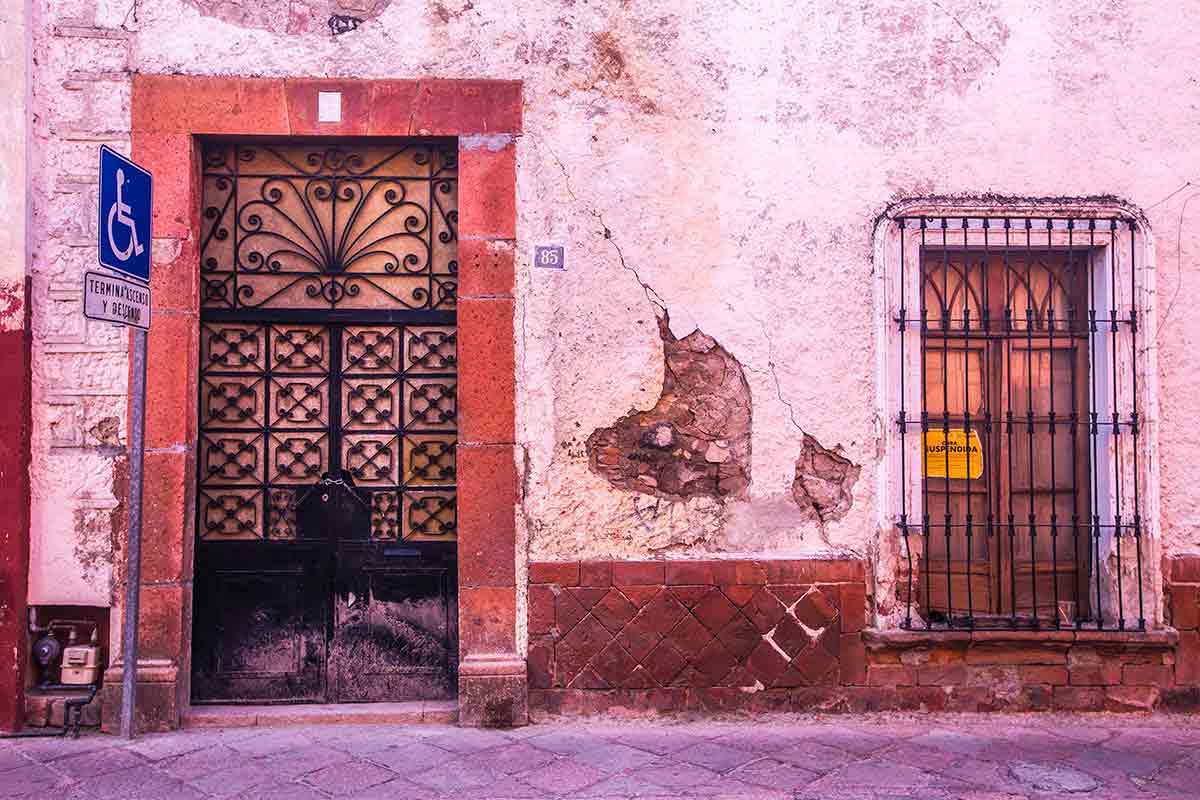
During my stay in Queretaro, I made a huge mistake as I opted to rent a private room on Airbnb without checking the exact location.
My place was far from the historical center, and I sacrificed convenience for the privacy of my own room.
While I was walking around the city, I noticed a couple of nice hostels that, for the same price as my private room, offer a very comfortable stay right in the heart of the city, where life happens.
You may also like
How to get from Cancun to Tulum The best Tulum Beach Club Is Puerto Vallarta Safe? Visit El Cuyo Yucatan How to visit Akumal Beach Valle de Bravo – A Travel Guide to the Mexican Hamptons Tulum Cenotes
Day trips from Queretaro
If you only have a week to see the city, you might want to plan another week to explore the entire region of Queretaro.
In reality, you could see the city in a couple of days unless you love to experience it like a local does or check out all the museums and restaurants, just like I did.
The state of Queretaro, although relatively small, hosts a couple of pretty cities that are considered Pueblos Magicos for their charm and historical importance.
I have seen almost all of them, and I will tell you briefly my thoughts here below.

16. Pueblo Magico of Tequisquiapan
It’s the closest Pueblo Magico to Queretaro at about a 30-minute bus ride. You can go in one day or stay there one night if you wish to explore more of the surroundings.
The Pueblo Magico of Tequisquiapan is popular for its vineyards and cheese. If you’re interested, the tourism board organizes one-hour tram tours that include samples.
If you are really into it, you could check with the tourist office and organize a full-day trip through the vineyards.
I found the city a little too touristic, but I was happy to have been able to check it out. The wine alone makes it all worth it.
17. Take a tour of La Trinidad to see the Opal Caves

This is a very interesting tour that sets off from Tequisquiapan and includes a beautiful hike to the opal caves.
Besides the beautiful landscape and cave formations, you can learn a lot about the Opal and the local economy around it.
The guide’s father is the owner of the cave you are going to visit, so you will hear all the stories directly from the source. Plus, if you find an opal stone, you can take it with you.

18. Pueblo Magico of Bernal and La peña de Bernal

Peña de Bernal is definitely one of the Mexican Pueblos Magicos that you must include on your bucket list. It’s a very small town, famous for the third-largest monolith in the world, towering over the cute, colorful buildings.
When you ask locals what to see in Queretaro, this natural wonder is always near the top of the list.
The city itself doesn’t have too much to offer, but the views of the surroundings are breathtaking, and a hike to the top of the Peña de Bernal is definitely worth doing.
I suggest you go early in the morning to avoid the crowds, especially on weekends or around a holiday. If you are a climber, this is a great spot to test your abilities.
The path to the top stops at a certain height, after which you need to be equipped with the right tools and an expert guide in order to go forward.
19. Visit Cadereyta
This is the only town I haven’t been to, unfortunately. It’s inside the Sierra Gorda , and it’s popular for its cactus greenhouse. I hope to have the chance to see it next time.
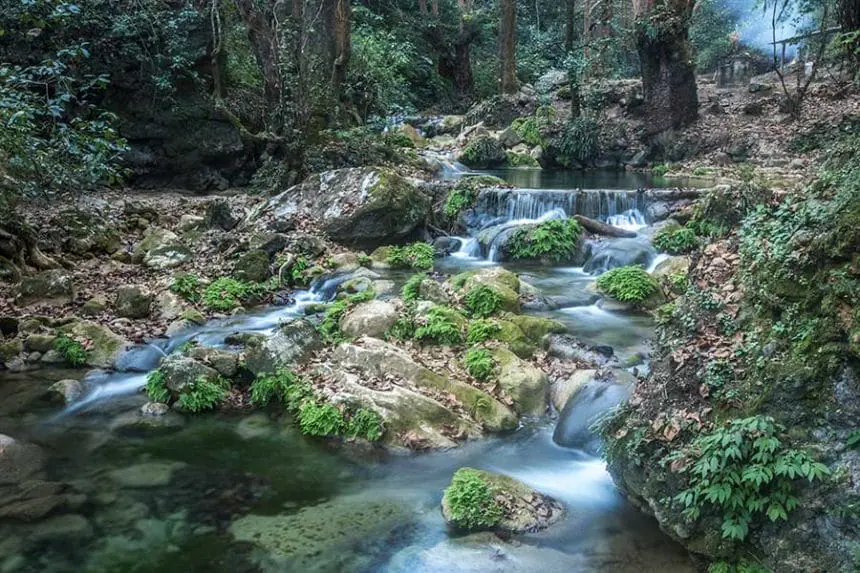
20. Visit Pinal de Amoles in the heart of the Sierra Gorda
This small town nestled among the hills and mountains of Sierra Gorda is your perfect base to organize all the excursions through the natural wonders of the region, rich in culture, various landscapes, and adventurous activities to do.

21. Jalpan
This is the last Pueblo Magico in the Sierra Gorda and in Queretaro State, close to the borders with San Luis Potosi and the Huasteca Potosina , which I have extensively written about in this small guide .
22. San Miguel de Allende

One of the most visited and talked about cities in Mexico, San Miguel de Allende, has been proclaimed a UNESCO World Heritage site.
These days it’s become home to many retired Americans and Canadians who have decided to live in Mexico. The city has plenty of fancy restaurants, shops, art galleries, and cultural events.
Oh. And coffee shops, too. My obsession!
It’s a real gem that you should visit for at least a couple of days. You can read more on San Miguel de Allende in this exhaustive article in Travel and Leisure Magazine .
Please note that San Miguel de Allende is not in the state of Queretaro, Mexico, but in Guanajuato. However, it is just a two-hour bus ride from the city, so I thought I should include it.
23. Visit Guanajuato

Guanajuato, the capital city of the state bearing the same name, is another gem you won’t want to miss.
It’s a beautiful small city rich in history and traditions.
It’s also home to one of the most prestigious and historic universities in Mexico. That’s why it’s full of students and interesting cultural events, including the Festival Cervantino.
I talk about it extensively in this thorough guide to Guanajuato to help you find your way around the city and track down the best hotels and restaurants.
Map Of Queretaro

Where to stay in Queretaro
Queretaro offers different accommodation options for all budgets and styles. I have stayed in an Airbnb and in hotels. Both were enjoyable.
Whatever you choose, I’d recommend staying in the historical center so that you can walk to all the most important attractions.
You can head over to my linked post, where I suggest the top hotels and Airbnb spots, or you can check them out in this convenient map below.
Things to do in Queretaro: Frequently Asked Questions
Is queretaro worth visiting.
If you ask me, Yes! Queretaro is definitely worth visiting. It’s a beautiful colonial city with lots of history, spectacular architecture, museums, great food, and thriving natural wonders nearby. It’s also a very safe area to travel around.
What is Queretaro Mexico known for?
Queretaro is mainly known for the important role it played in the Mexican war for Independence from Spain.
But also it’s a renowned area for its vineyards and the spectacular Sierra Gorda, the mountain areas with incredibly diverse ecosystems.
Plus, the architecture in Queretaro represents the quintessential colonial-era Mexico vibe with baroque stylings everywhere.
How many days do you need in Queretaro?
If you consider only the city, a couple of days may be enough, unless you want to check out all the museums and the surrounding area, in which case, consider a week to ten days.
Is Queretaro a nice city?
Queretaro is a spectacular city, an open-air museum in and of itself. You will find beautiful historical buildings everywhere and an interesting history, not to mention delicious restaurants serving local cuisine.
Is Querétaro walkable?
The historical center of Queretaro is very walkable and relatively safe
Do they speak English in Querétaro?
Because it’s a very touristic city, many people speak English in Queretaro.
Do you need a car in Queretaro?
To visit the city, you don’t need a car, but if you want to explore the surrounding towns, you will either need a car or to join locally organized tours.
How far is Queretaro from Mexico City?
The city of Santiago de Querétaro is approximately 217 km northwest of Mexico City.
You can drive this route in about 2.5 hours or take a bus which may take closer to 3 hours.
Direct buses from Mexico City to Santiago de Querétaro are available at all major bus stations in the capital.
Does it get cold in Querétaro, Mexico?
The temperature is usually quite warm throughout the year, ranging from 42°F to 85°F, never dropping lower than 36°F or rising higher than 91°F.
Things to do in Queretaro, Mexico: Final Thoughts
As you can see, there is a lot to do in Queretaro. I had to go back several times to be able to do everything, and I still haven’t finished yet.
If you love nature, make sure you save a few days to get to the Sierra Gorda and explore the spectacular waterfalls and woods. That was my favorite part of Queretaro.
Isabella is traveler and animal lover, a former tourism professional with an multinational background that lead her to Mexico, that she can proudly call home. After seven years in Cancun where she's still a resident, she took a bold leap, leaving her fancy job to embrace a nomadic lifestyle. She traveled all over Mexico, from Baja California to Ciudad Juarez, Oaxaca, Chiapas Hidalgo exploring and living like a local. Isabella founded Let's Travel to Mexico to help travelers plan their own trip on and off the beaten path in this beautiful land that she loves so dearly.

The Perfect 4-Day Itinerary for Exploring Queretaro
Queretaro’s Centro incorporates more than 204 blocks of history, politics, conspiracies, and even a love story, yet it is usually overlooked for its more famous neighbor San Miguel de Allende. There’s so much to see and do that skipping out on this UNESCO World Heritage Site would be a sad mistake. We recommend spending at least a minimum of 3 days in Centro and adding a fourth day for nearby pueblos magicos. Queretaro’s Centro is large so exploring different sections each day will help you see more and save your feet from too much walking.
Follow us on this itinerary to see the most, and best, of Queretaro.
Disclosure: Some links may be affiliate links where we receive a super-small commission at no additional cost to you if you click through and make a purchase. We call this our Chocolate & Churro Fund.
Fly to Queretaro
Flying into Queretaro is easy since it has its own International Airport ( QRO ). There are daily connections from Houston, Dallas, and Mexico City, and a handful of other cities fly in a few times a week. The airport is small with only 3 gates. Getting through customs and picking up your bag is a breeze. A taxi counter is located just outside the main doors to the left. The taxis have a flat rate to take you to Centro.
Another option is to use your Uber app. The cost will be around $15. (Cost of Uber and taxis go up after 6 pm). The drive from the airport into Centro isn’t very pretty, but don’t let this influence your first impressions of Queretaro.
Drive to Queretaro
Highways and toll roads connect to Queretaro from many cities across Mexico. If you don’t feel comfortable driving, private cars and luxury buses are also available.
Take the bus from Mexico City airport to Queretaro. Read our post: Bus Travel in Mexico is Easier Than Flying .
Where to Stay in Queretaro
Several boutique hotels that were once haciendas are located in Queretaro Centro. Many have gorgeous courtyards, and you will be amazed at how far back they go. When looking for a hotel, use Jardin Zenea as a central point and stay near or between Plaza de Armas and Jardin Guerrero. The areas between these two plazas are walkable with minimal traffic. This is the main Centro and you will find a lot to see, explore, and eat within this area.
Some boutique hotels we recommend are Casa de la Marquesa , Patio Santiago , or Hotel Aspeytia with its rooftop bar overlooking Centro.
Find a hotel on Booking.com
Check into your hotel, freshen up a bit, put on your walking shoes, and explore the vibrant city of Queretaro!
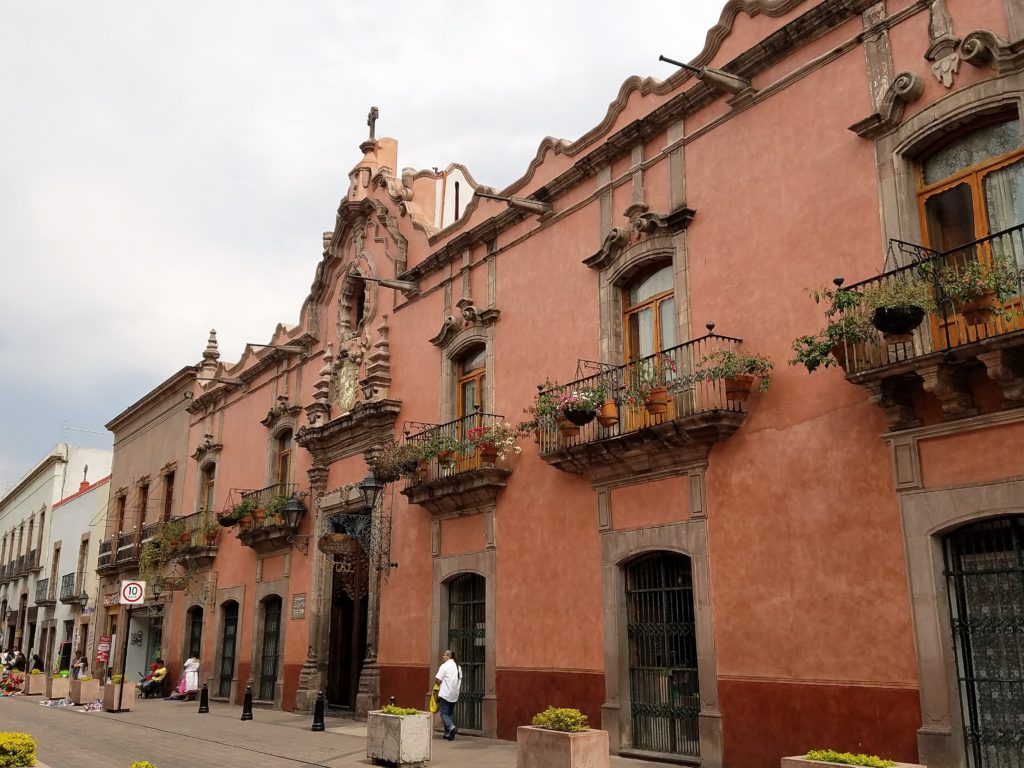
First Day in Queretaro (East Side)
For your first full day in Queretaro, explore from Jardin Zenea to Templo de la Santa Cruz.
Jardin Zenea
Jardin Zenea is a good central starting point for everything in Centro. Churches, restaurants, and walking streets all radiate from this park. Queretaro’s Centro is labeled as a UNESCO World Heritage Site Monumental Zone for its 1400 Monuments, street plan, and baroque architecture. You won’t be able to see all 1400 Monuments on this itinerary, but we hit the highlights that are within easy walking distance. Jardin Zenea was once the gardens of Templo de San Francisco de Asis. Today it’s the focal point for Queretano life full of vendors, music, dancing, ice cream eating, and holiday decorations.
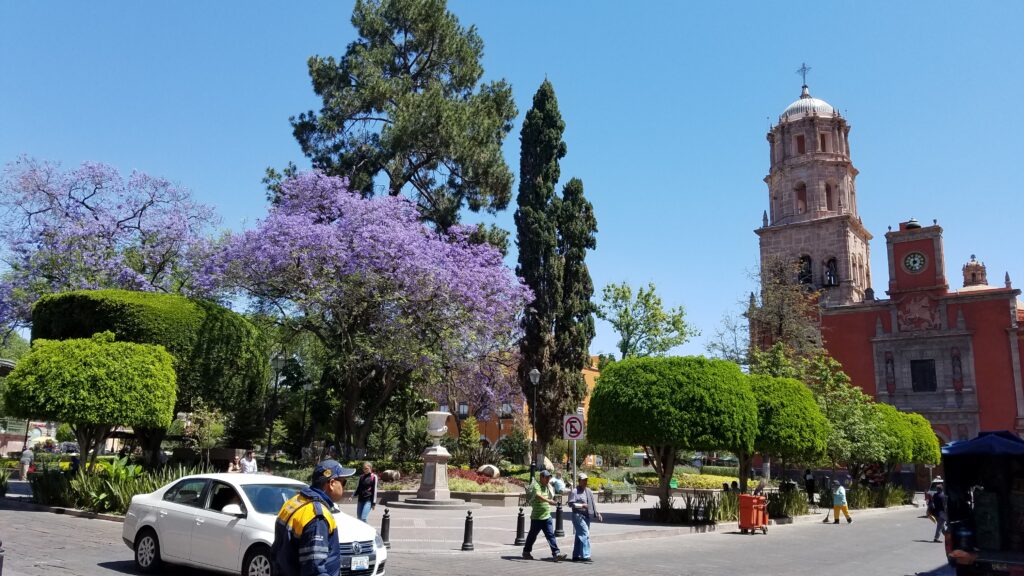
Templo de San Francisco de Asis
Templo de San Francisco de Asis with its red exterior and clock tower is hard to miss. It’s also one of the most beautiful churches in Queretaro. The Queretaro Regional Museum where you can see how civilizations of the past shaped this region now occupies the old convent beside the church.
Start your walk up Andador 5 de Mayo with the Dancing Chichimeca statue beside the Templo de San Francisco de Asis. This walking street has many attractions along the way. Surrounded by Spanish Baroque architecture, you’ll pass many cute souvenir shops, a street vendor side detour at the fountain, and many eateries.
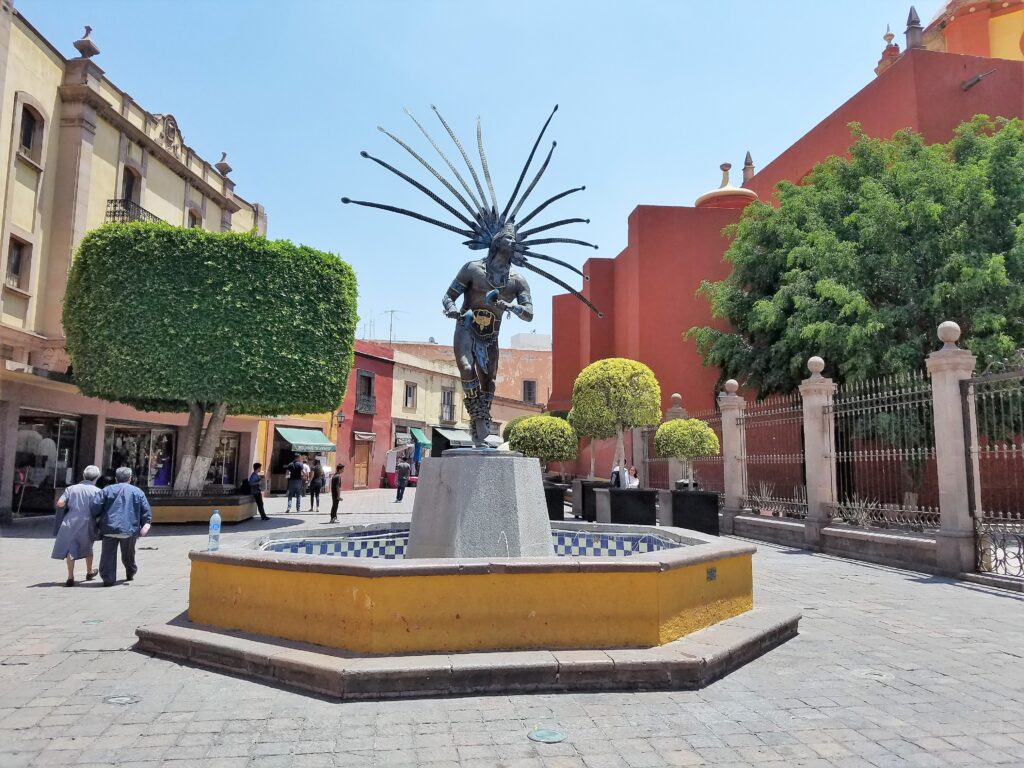
Museo de Conspiradoros
Museo de Conspiradoros is a free museum on Andador 5 de Mayo. The walls of this converted hacienda are decorated with murals detailing the conspirator’s conspiracy to rebel against the Spanish. Explanations are all in Spanish, but my dad and I understood it pretty well.
Next door to the Museo de Conspiradoros is La Fabrica de Chocolate . Stop in for a late breakfast or chocolate and churro snack. Don’t be surprised if you visit this place more than once. My favorite is the tabasco-paraiso, chocolate with hints of chilis. So good!
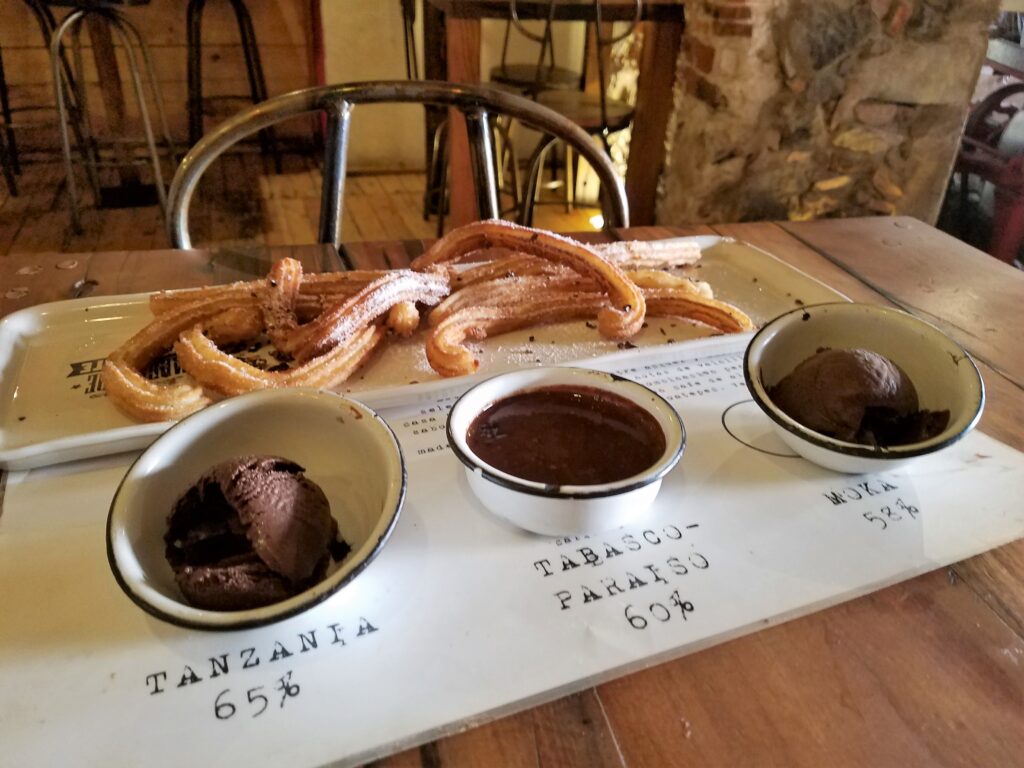
Plaza de Armas
The first plaza you will reach is Plaza de Armas. Casa de Corregidora , the former home of the mayor (Corregidor) and the Corregidora, is the Government Palace today. Wander inside to gaze at the murals. If you visit during the holidays, you might see something special in the central courtyard. For the Day of the Dead, altars are constructed for prominent people in the community, and during Christmas, you can find a beautifully decorated 2-story Christmas tree.
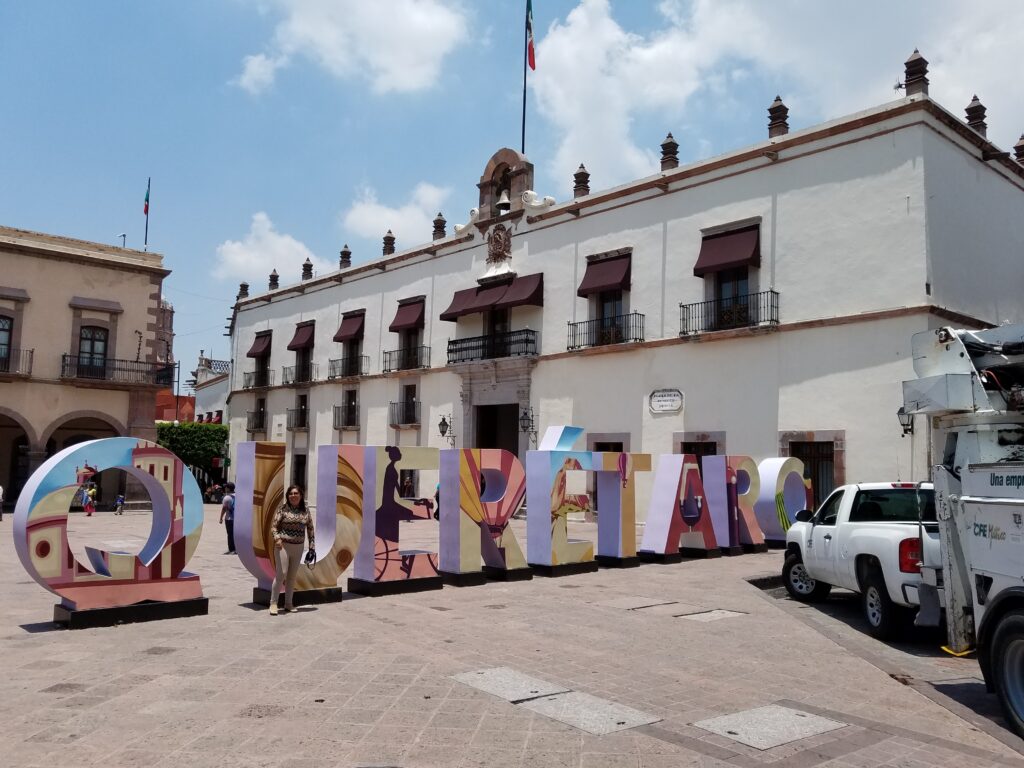
Moving counterclockwise around Plaza de Armas, marvel at the arches and stonework of Casa de Ecala which also houses government offices. Colonial-style hotels and fancy restaurants such as Restaurant 1810 occupy the other buildings surrounding a beautiful fountain in the center.
Where to Eat and Drink on Calle 5 de Mayo
Andador 5 de Mayo turns into Calle 5 de Mayo where cars can slink their way down the narrow street. Continue walking up Calle 5 de Mayo and explore the different restaurants and shops along the way. Alquimia is a tiny bar perfect for a creative cocktail break. And if pulque and chapulines are on your list of “must-try” Mexican cuisine, there’s no better place than Maria y su Bici . You’ll have plenty of choices for restaurants offering international cuisine and charming courtyard bars.
Plaza de los Fundadores and Templo y Convento de la Santa Cruz
Plaza de Los Fundadores (Founders Square), a small plaza with a handful of statues will be your next monument sighting. From this small plaza, you have a fantastic view of the Templo y Convento de la Santa Cruz.
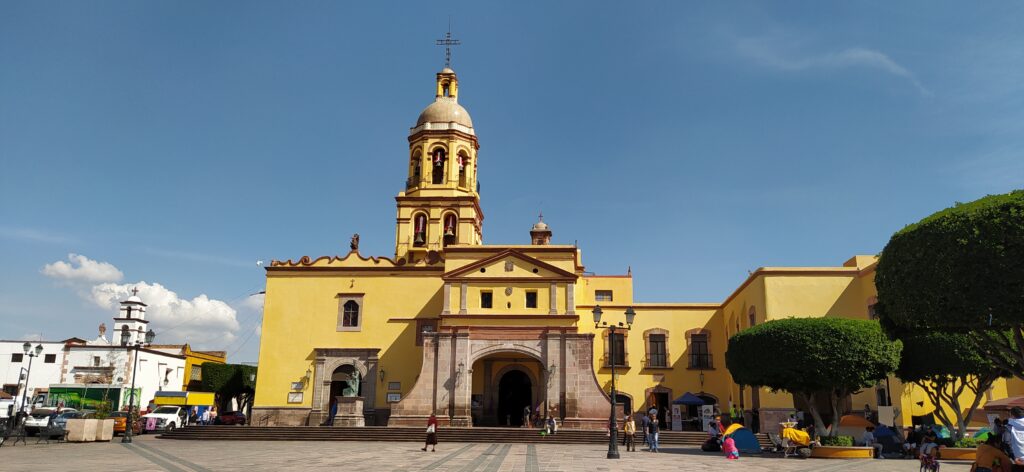
The Battle that Established the City of Queretaro
Templo y Convento de la Santa Cruz is the beginning of the city of Queretaro. In the early 1500s, the Otomis of the Queretaro region aligned themselves with the Spaniards to get rid of the Aztecs and the ever-pressing northern Chichimecas. A great battle was fought on a hill called Sangremal. The Spaniards and Otomis were losing until a solar eclipse darkened the sky. A friar who recounted the battle wrote that St. James rode across the sky on a white horse carrying a blazing cross. Believing that the foreigners’ god was there to protect them, the Aztecs and Chichimecas laid down their weapons and surrendered. The Templo y Convento de la Santa Cruz was erected on Sangremal, and the city of Santiago de Queretaro (named after St. James) was officially established in 1531.
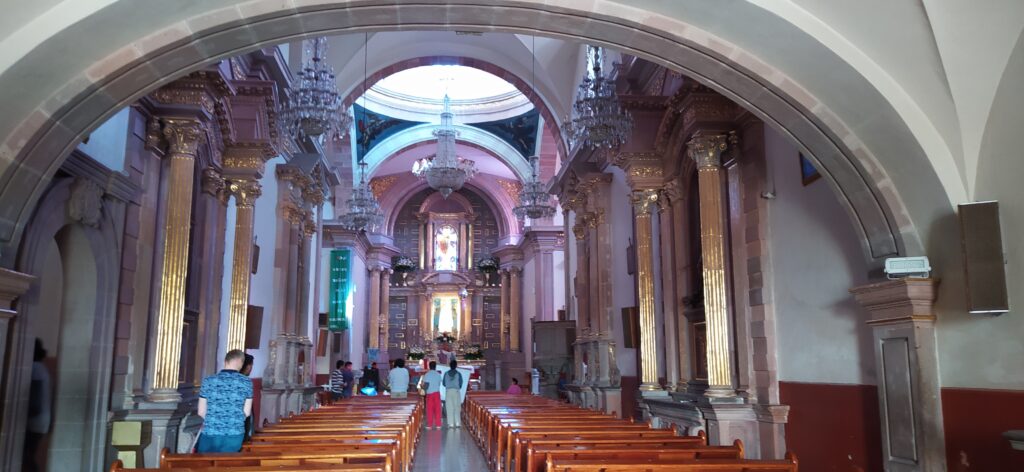
Aqueduct View
Follow the street that runs alongside the church back to the viewpoint of the aqueduct, El Mirador. The aqueduct is Queretaro’s most famous landmark. This is the upper view of the aqueduct as it spans across the city. For an even better view from underneath the aqueduct, continue walking down the street and turn left at the busy highway. Take your first left again and there is a fountain where you can get a fabulous picture of the aqueduct.
Read about the unusual one-sided love story behind the building of the aqueduct and Casa de la Marquesa .
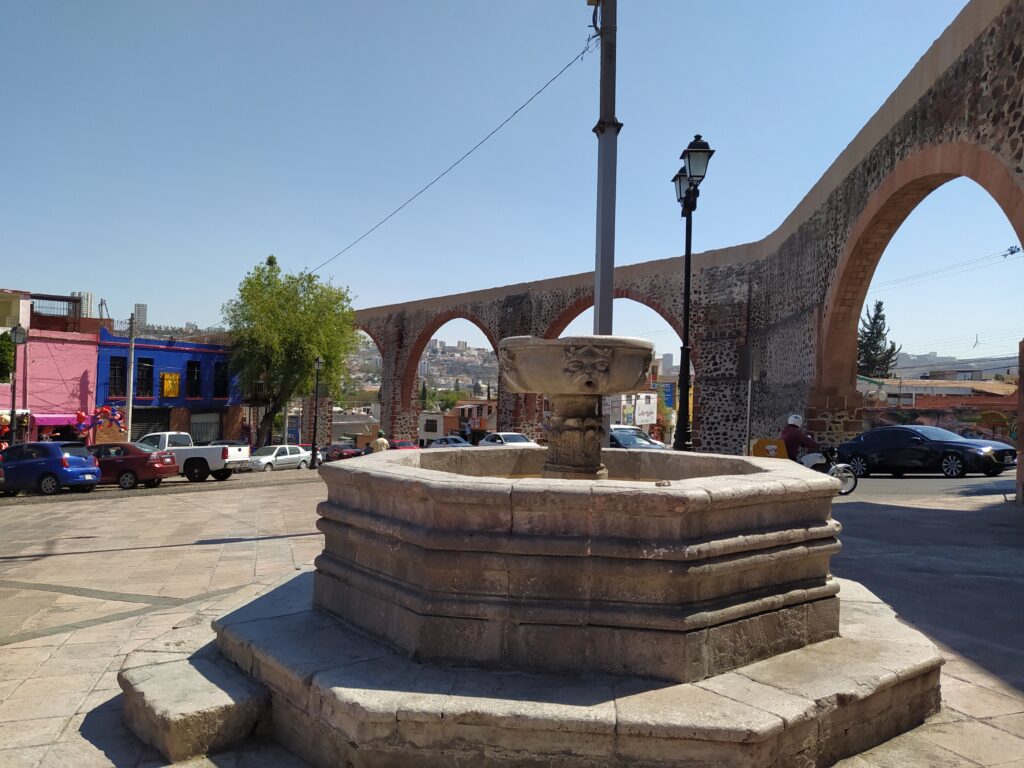
Real de Tierra Adentro
While the view of the aqueduct is the main feature, be sure to check out the plaque commemorating the Real de Tierra Adentro. This was the major trade route from Mexico City to San Juan Pueblo, New Mexico from 1598-1882. On the Mexican side, it’s recognized on the UNESCO World Heritage List. On the United States side, it’s recognized by the National Historical Trail System. Though it’s not used today, parts of it are being restored as tourist attractions.
Corregidora Mausoleum
Across from El Mirador is the Corregidora Mausoleum, the final resting place of Queretaro’s most famous resident. Josefa Ortiz de Dominguez was the wife of the mayor, the Corregidor. Together they were part of a conspiracy group to overthrow the ruling Spaniards from Mexico. The Spaniards discovered the conspiracy and began arresting people and raiding homes for weapons. Locked away by her husband (for her protection), the Corregidora still managed to get a message sent to Father Hidalgo, another conspirator. The Mexican War of Independence began on September 16 th , 1810 with El Grito de Dolores (the cry of Dolores).
Josefa continued to send money and information throughout the 11-year war and is regarded as a local and national heroine. Her mausoleum has many pictures and letters from that era. Other prominent people are memorialized as statues around the mausoleum grounds.
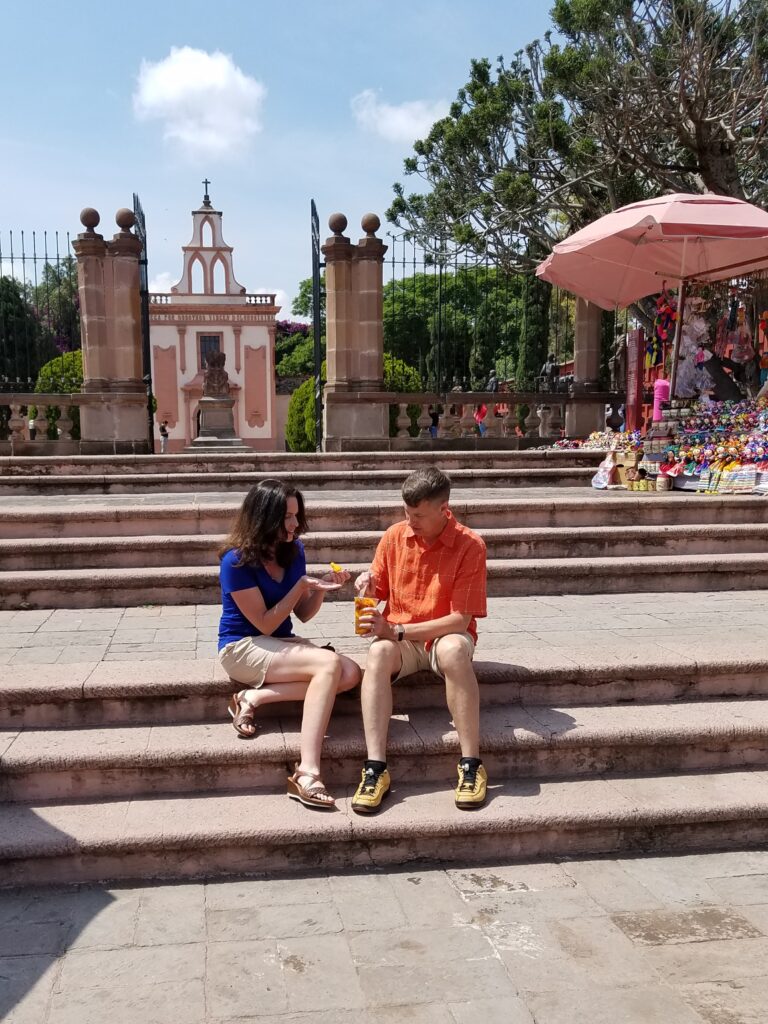
Explore up and down the streets and see what other hidden treasures you can find in the antique shops. The Queretaro is a very safe place and there’s a lot of unique things to see on every street. A few blocks north of the Founder’s Plaza is Mercado “La Cruz” where you can grab a bite to eat or local produce.
Read our post: Picture tour of Mercado la Cruz
Day 2 jardin zenea to jardin guerrero (west side), casa de la marquesa.
South of the Jardin Zenea on Calle Francisco I. Madero is the semi-walking street that leads you past Casa de la Marquesa. We stayed at this beautiful Baroque and Moorish hotel on our first visit to Queretaro. If you choose to do the Night Tour in Queretaro , they will take you into the lobby of the Casa de la Marquesa and recite the cunning love story between the Marques and a nun.
NOTE : The night tour can be booked every day in front of Templo de San Francisco.
Around Neptune’s Fountain
Just past the hotel is Neptune’s Fountain next to Templo de Santuario de Vida . Parroquia del Sagrado Corazón de Jesús “Templo de Santa Clara” located just behind it has a stunning Baroque interior. Across the street from Neptune’s Fountain is the Museo de Arte Sacro de Queretaro which was once the Royal Hospital of La Purísima Concepción.
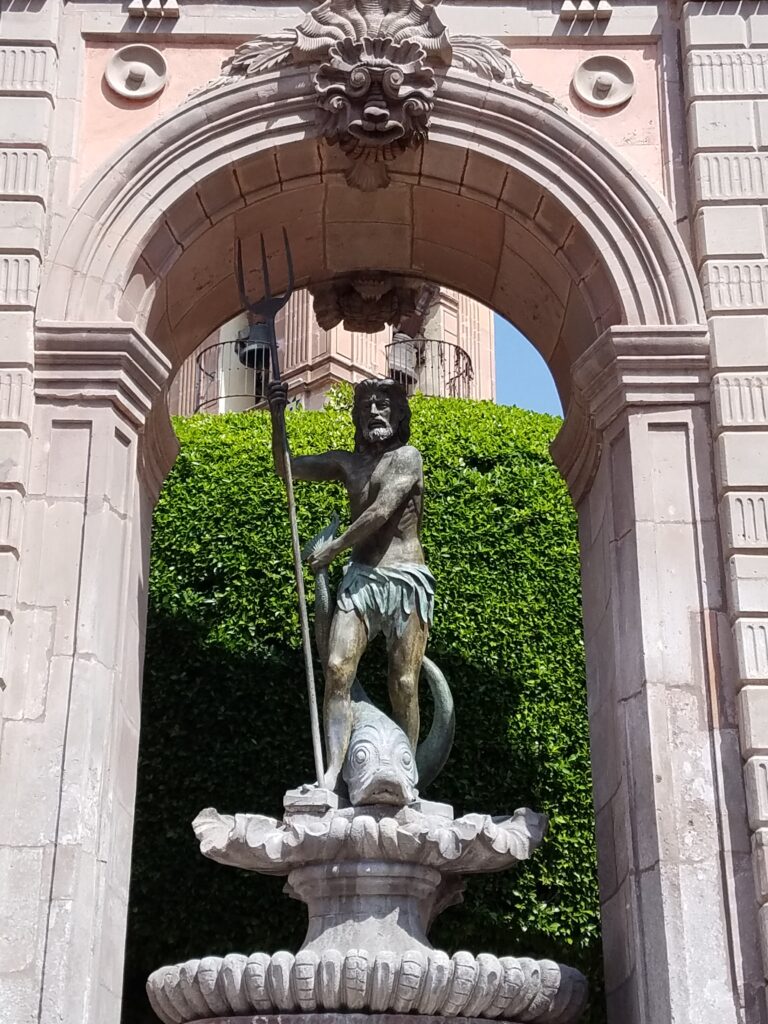
Jardin Guerrero
Passing a handful of coffee shops and small restaurants, you will arrive in Jardin Guerrero. This plaza is home to an exquisite fountain and is surrounded by several hotels and restaurants. During the Day of the Dead celebrations and Christmas holidays, you can find a small market selling all kinds of toys and candies.
Queretaro is a college town and if you want to relive those poor college days with drink specials head to Diktatur. This restaurant has an open-roof courtyard where you can watch night fall above the strings of books seemingly floating overhead. To get your money’s worth, skip the pizza (which is more like cracker flatbread) and get a burger with a cool mixed drink.
Read our post: Restaurants in Queretaro Centro- Where to Eat For Every Budget
Calendar museum.
The Calendar Museum just past the Jardin Guerrero is a fascinating place to spend a few hours. This museum is in an old hacienda with a few beautiful courtyards, a rooftop view, and a cafe. Compare calendars from different civilizations and marvel at the political and commercial messages in the 20th-century calendar art.
Crossing Highway 200 to Alameda Hidalgo
From Jardin Guerrero to Highway 200 to your left are 3 blocks. Wander up and down these streets for more churches and local shops and eateries on your way back to Jardin Zenea. When you reach Calle Corregidora, grab an ice cream and head across the highway to Alameda Hidalgo. Traffic noise disappears in this huge tree-shaded park on the outskirts of Centro. Calle Corregidora will take you back to Jardin Zenea, your starting point in Centro.
Day 3- Pueblos Magicos and Wineries
Tour the countryside and enjoy a more laid-back pace of life. Arrive early to hike Peña de Bernal before it gets hot in the afternoon. A good time to start is around 9 am as most things don’t open in town until after 10 am. The hike will take about an hour and a half. Afterward, fill up on your second breakfast with gorditas at the base of the monolith or in town. The town itself is really cute and offers some of the best prices for handmade garments and spirit stones. You can easily spend half a day here wandering the alleys, visiting the Mask Museum and the Casa Museo del Dulce . There are plenty of rooftop restaurants to enjoy the view of the monolith if you stay for lunch, dinner, or overnight.
Read our Travel Guide to Hiking Peña de Bernal
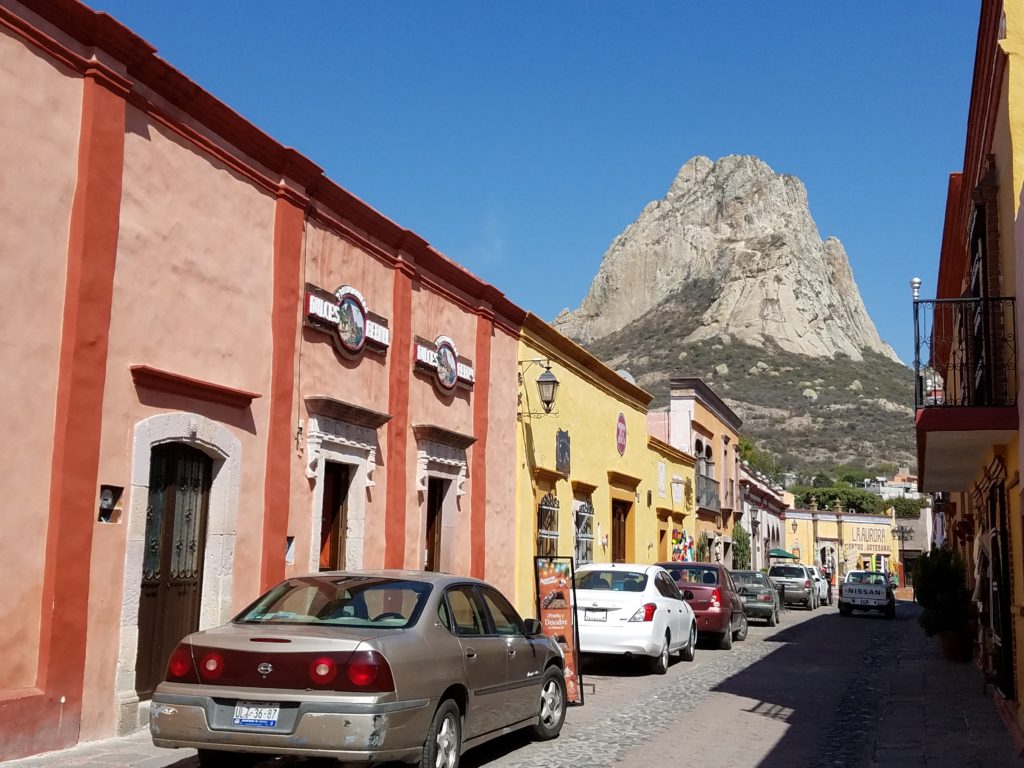
Head out of town and stop at a few wineries along the way to Tequisquiapan. You do need a reservation for each, and you should plan to spend over an hour if you are just wine tasting, and 2.5 hours if you are doing a tour and tasting. Some of the wineries have fantastic restaurants if you feel you want to splurge on food and wine with a view.
Explore the Wine Region of Queretaro
I saved Tequisquiapan for last because as cute as it is, there really isn’t that much to do. You can wander the streets, watch the kids take a ride on the train around the plaza, and drink at the wine bars. Shopping is more expensive here, and nothing gets going until the afternoon. It’s fun to see families enjoying the day out in the plaza while sipping on a Brut Natur Cava from the Freixenet Bar or eating by candlelight al fresco at one of the restaurants surrounding the plaza. You can casually wander through the town in less than 2 hours or choose to stay overnight to experience the relaxing nightlife of Tequis.
Tequisquiapan gets hopping during its wine festivals . Join us on one of our day tours to the wineries and pueblos magicos to experience more of the Queretaro region through our tour company Heart of Mexico Wine Tours !

Day 4- Trolley to Cerro de las Campanas and Mexican life
Your fourth day may be your last, or you may have decided that Queretaro deserves a few extra days. For today, we recommend just taking it easy and soaking up the Mexican life. Start with a trolley ride from Monumento a la Corregidora (yet another statue dedicated to Mrs. Josefa) to Cerro de las Campanas where Maximillian I (the only foreign emperor to rule Mexico) was executed. Translated, Cerro de las Campanas means Hill of the Bells. The rocks have a high amount of iron and when knocked together, make a bell-like sound. The superstitious stories are very entertaining. This tour lasts an hour.
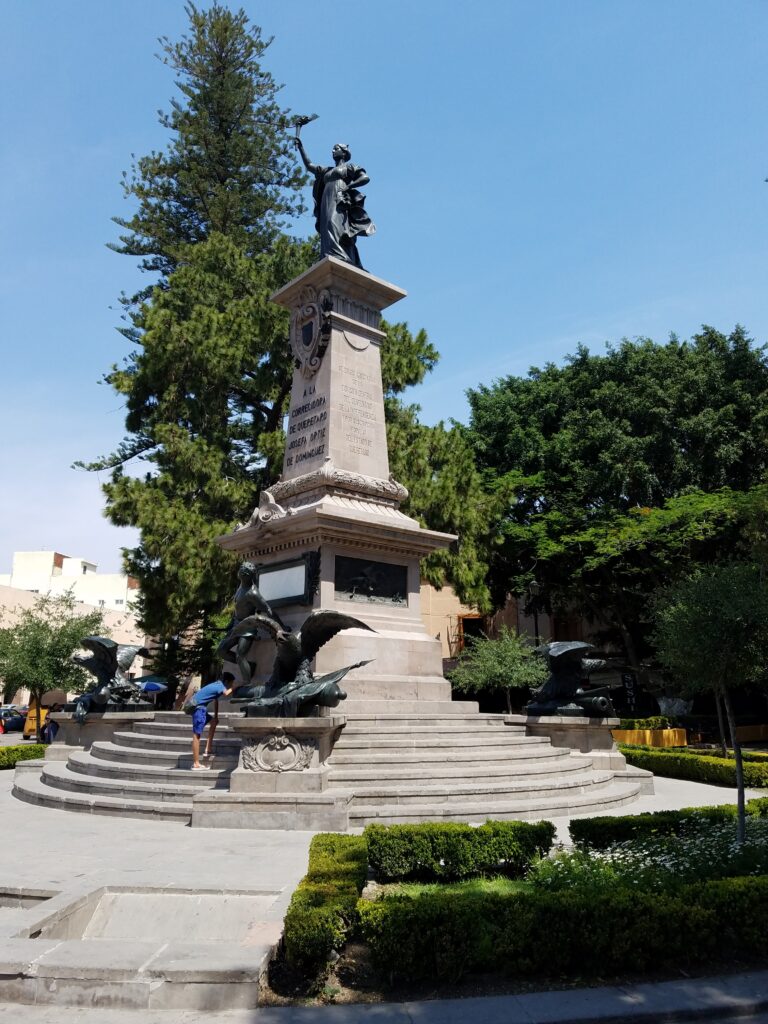
Returning to Monumento a la Corregidora, wander up the walking street Calle 16 de Septiembre with its shops and fancy Basque restaurant Alioli. It will end in a small plaza across from the Sanctuario de la Congregacion de Santa Maria de Guadalupe with its bells and steeples painted in the colors of the Mexican flag.
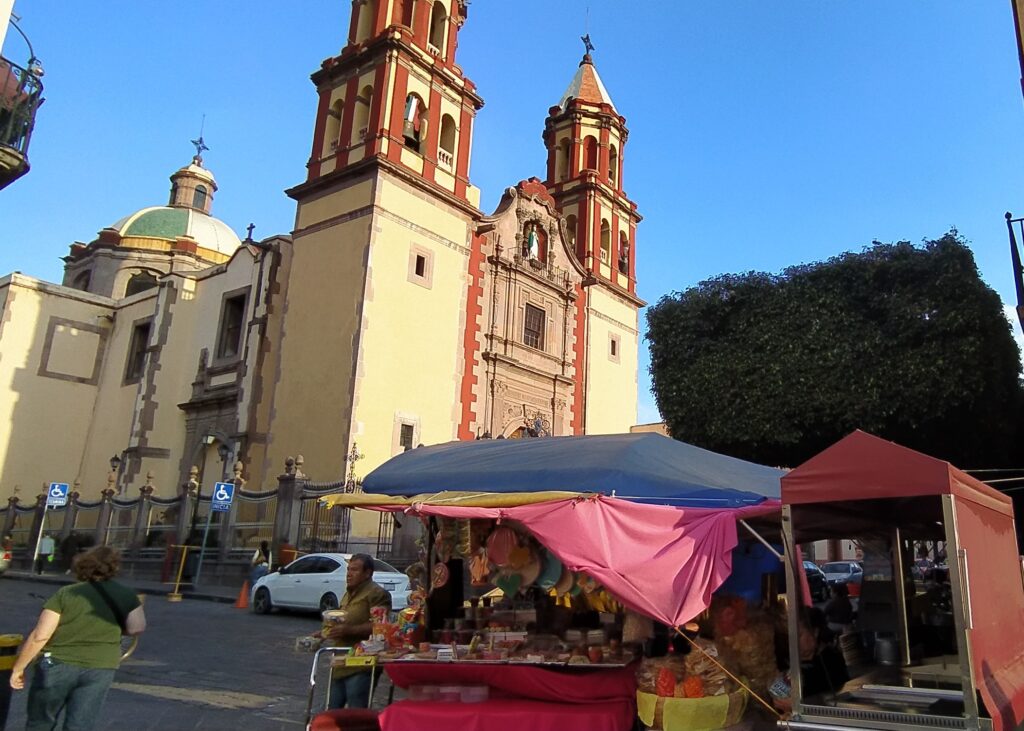
Other Landmarks in Queretaro
This is also a good day to explore north of Jardin Zenea if your feet are up to it. Several churches, small businesses, and boutique hotels are located on this side as well, and keep your eye out for little details and open courtyards.
Walk a few blocks to the Teatro de la República , a beautiful theater that also had a cameo appearance in the movie Once Upon a Time in Mexico. Templo de San Antonia de Padua is one of the oldest churches in Queretaro.
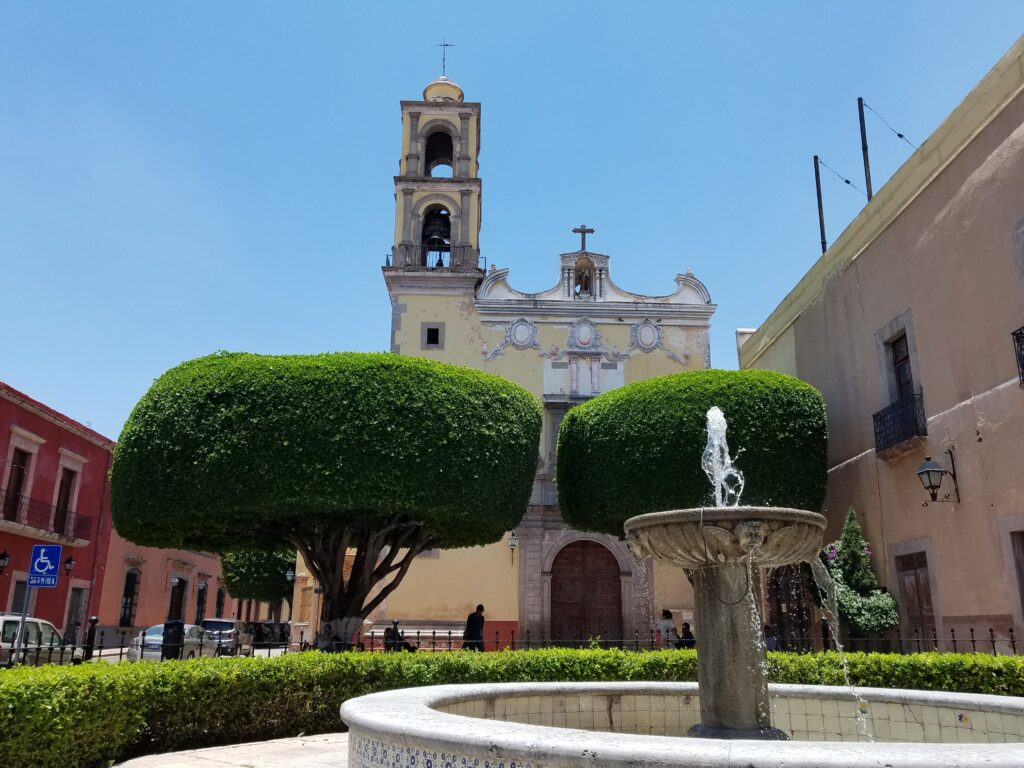
The architecture changes once again from wrought-iron Spanish balconies to one-story Otomi houses between Jardin Zenea and Blvd Universadad which runs along the Rio Queretaro. There are lots of interesting local places to eat along these streets.
Don’t miss the Fuente de Ignacio Pérez (Fountain of Ignacio Pérez) at the crossroad roundabout of Calle Corregidora and Universidad. Perez was the Paul Revere of Queretaro carrying the message from the Corregidora to Father Hidalgo that started the Mexican War of Independence against Spain in 1810.
Where to get a Rooftop View of Queretaro
For your last night, eat at a favorite restaurant ( they will probably remember you and greet you like family), try some place new, or hang out at Hank’s Oyster Bar for drink specials and occasional live music. Before you call it a night, make sure to stop by Hotel Aspeytia for a drink at their rooftop bar.
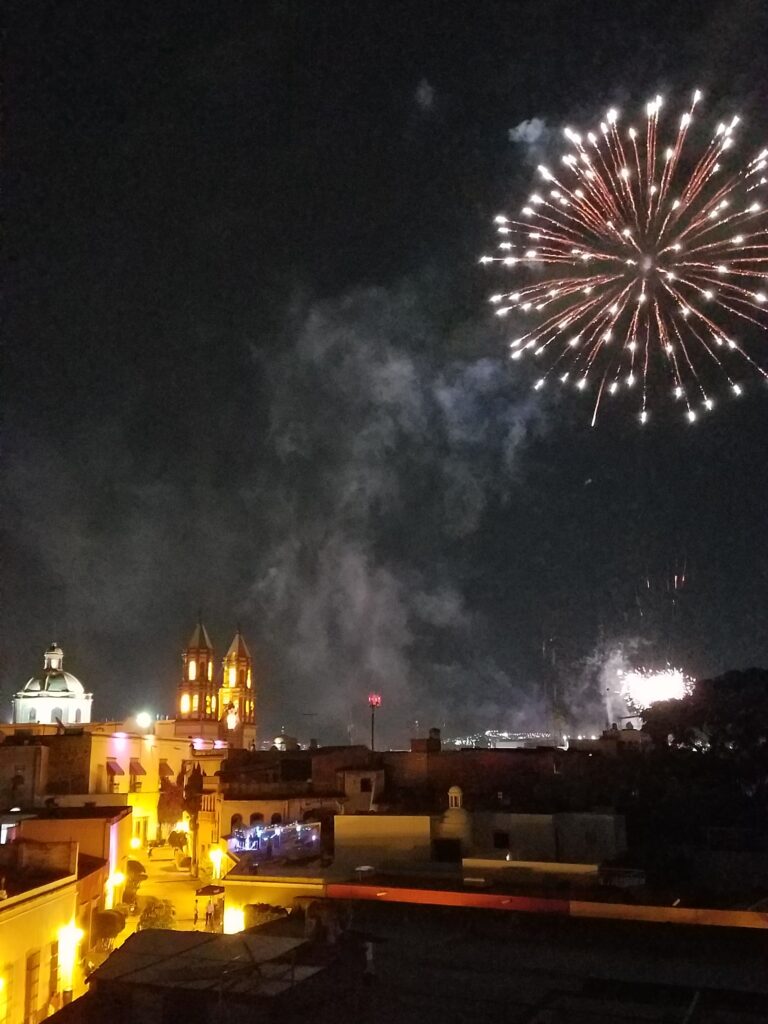
Fall in Love with Queretaro
We’ve packed a lot into four days in Queretaro, but each day is at your speed. No need to hurry. Enjoy the people-watching while eating ice cream, walking through history, and a day of wine tasting. You may even fall in love with Queretaro like we did and think about retiring here. Many people do. If you have more time, there are other places close by to visit as well such as San Miguel de Allende and hiking in the Sierra Gorda.
Don’t forget, we also offer wine tours in Queretaro and San Miguel de Allende !
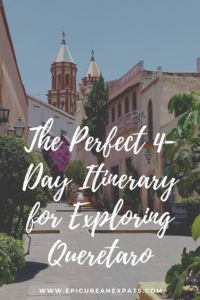
Similar Posts
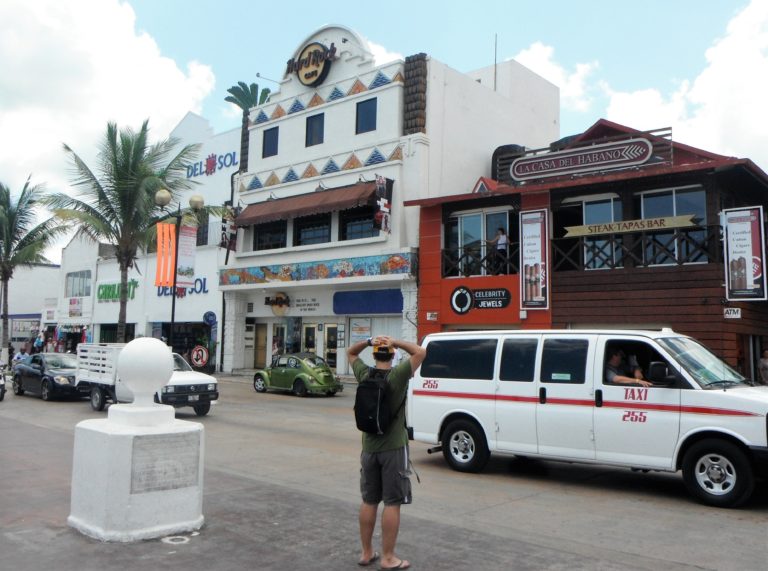
Road Trip Around Cozumel
Road trips are a fun way to explore a new, or even old, destination. And a road trip around Cozumel off the coast of Mexico is a great way to see more than just its famous beaches. With a town bustling with tourist traps, Mayan ruins, a lighthouse on the southern tip, and an eastern…
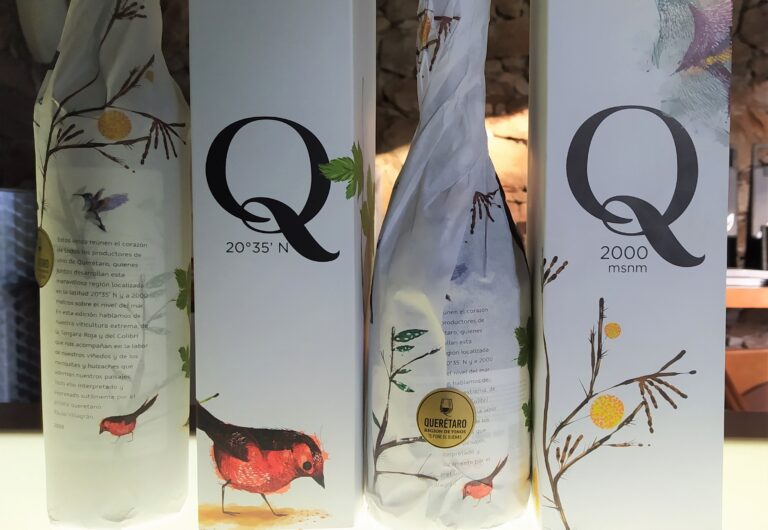
Explore the Wine Region of Queretaro, Mexico
Queretaro’s landscape and climate might not seem like ideal growing conditions with its summer hail storms, but if you look around the world, some of the best wines come from semi-arid climates and high elevations. Queretaro wineries plant their vineyards between 6200-7000 ft elevation which leads to hot days and cool nights. This drastic swing…
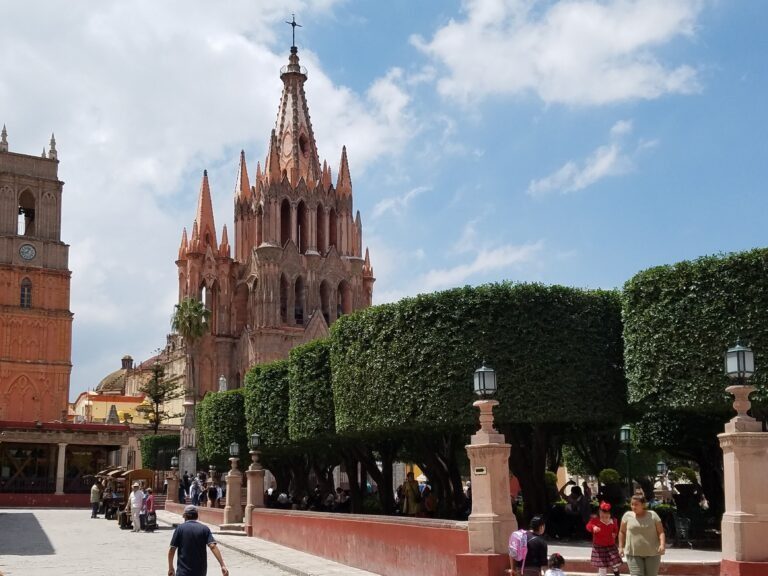
The Best Day Trips and Tours in San Miguel de Allende by a Local
San Miguel de Allende is known for its cobblestoned streets, colorful architecture, and many galleries, but there is so much more to experience in and around this UNESCO World Heritage Site. From farms and wineries to adrenaline adventures and unique home and garden tours, there is something for everyone. You may get overwhelmed by the…
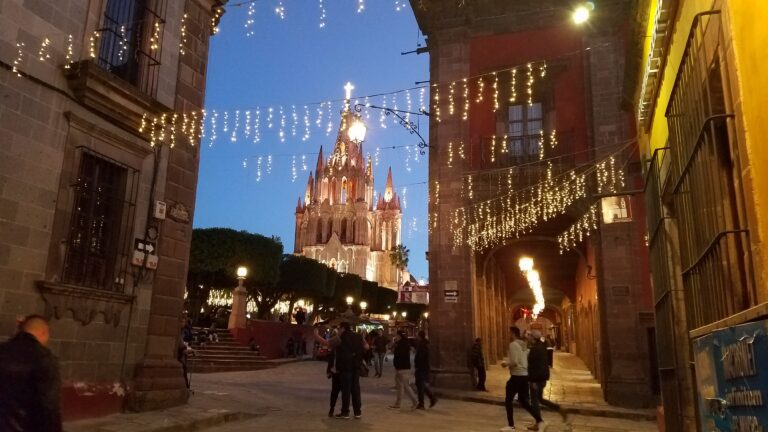
Christmas in San Miguel de Allende
Christmas in Mexico is a festive and joyous occasion. Celebrations typically combine religious traditions with family gatherings, cultural customs, and a lot of noise. Though department stores start selling Christmas decorations as early as September, most towns will not start decorating in earnest until the second week of December. With mild temperatures, colorful architecture, and…
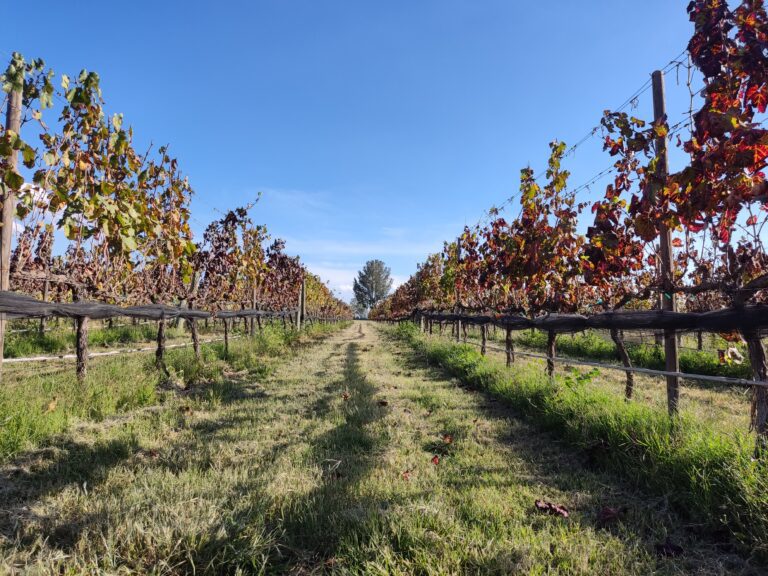
San Miguel Wine Tours With Wine Experts
San Miguel de Allende has been charming visitors for decades with its colorful streets, art, and mercados. Conde Nast Traveler readers have named San Miguel de Allende the Best Small City in the World in 2017, 2018, 2020, and 2021, and 2022. And now there’s another reason to visit this compact artisan community… wineries! Our…
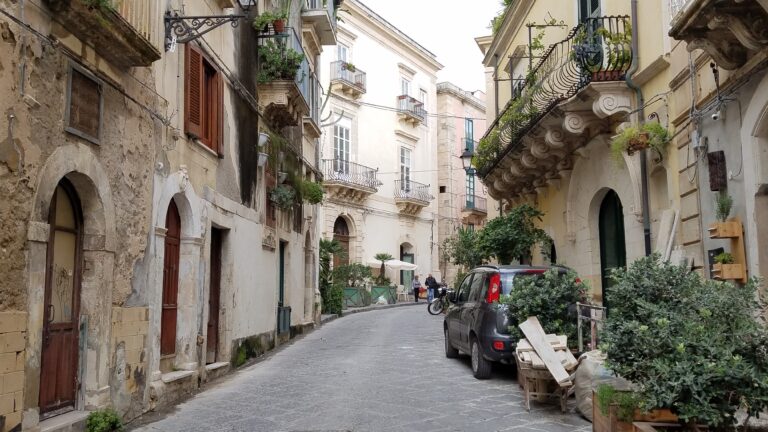
The Best Books on Travel and Living Abroad
We don’t regret moving to a new country, but living abroad isn’t all rainbows and butterflies every day. In the beginning, we struggled with the language, setting up internet and cable, getting lost countless times with Google Maps, and experiencing a car accident three days after buying a car. Most of the stories you hear…
14 Comments
This looks like an amazing destination! I love chili chocolate too, so a visit to la Fabrica de Chocolate would be right up my alley!
You will love the place and the chocolate! When my dad came to visit we went there twice!
You totally got me hooked. I love the statues around the city – the Dancing Chichimeca especially. So unique! Mexico is so magical honestly … I can’t wait to visit Queretaro.
And yes! Chocolate with a little bit of chili. Divine!!! 🙂
I’m hooked on the chili chocolate, too all year round now! There’s so many statues and fountains to see in Queretaro! I have yet to see all 1400!
I have a mini love affair with all things Mexico! Queretaro is wonderful! I’d most want to see the Museo de Conspiradoras, for the collection, as well as to try those tasty churros nearby! It’s great to read about a lesser known place in Mexico, I hope I can return one day.
I hope you can return one day, too!
Queretaro looks like a wonderful place to visit with all of its beautiful churches and squares. It seems very tranquil and relaxing too. I would love eating churros and fresh mangos and of course enjoying a drink on a rooftop bar! Queretaro seems magical indeed! 😁
I’m a huge fan of Mexico (been there 27x in 30 years) and now have a new place to visit! I’ve heard of the famous neighbor, but not Queretaro…must visit! And this sounds like the perfect itinerary…and love that it has its own int’l airport.
What a detailed itinerary. I’ve pinned for later as I’d love to visit Queretaro one day. Mexico is on my list and I hope to now include here. I want to taste the churros and mangoes and visit Museo de Conspiradoras.
Mexico has so many wonderful places! I know you’d enjoy the nature and waterfalls of the Sierra Gorda plus the amazing food we have here!
You really are educating me on Mexico. Another place that would be an awesome visit. For that churros dessert alone. #TravelBlogTuesday.
Queretaro is an amazing place! I’m positive you would enjoy many things about this city (and the churros)!
Muchas gracias por sus comentarios, me voy allá en una semana por mi primera vez!
¡Pásalo bien!
Leave a Reply Cancel reply
Your email address will not be published. Required fields are marked *
Sign me up for your mailing list.
- Privacy Policy
- 12 Posts to Plan Your Trip to Mexico
- Guadalajara
- Mexico City
- Pueblos Magicos
- San Miguel de Allende
- Quintana Roo
- Mexican Cuisine
- Lima Restaurants
- USA & Canada
- Tom’s Cooking
- Latin America’s 50 Best Restaurants
- World’s 100 Best Restaurants

Robert Harding
Wandering through the delightful colonial heart of Querétaro with its shady squares, grand fountains and historic mansions, you'd never guess that this is one of the fastest-growing cities in the northern hemisphere thanks to a booming aerospace and technologies industry. Except perhaps you can, as in order to reach the colonial heart of Querétaro, you'll have to first pass through some fairly striking examples of urban sprawl and contend with the powerhouse city's legendary bad traffic. However, it's well worth the effort to do that, as Querétaro's star is clearly in the ascendent, with an optimistic and mercantile population rising to the challenges of life in modern Mexico. The town's historic heart is characterized by charming andadores (pedestrian streets), gorgeous plazas and historic churches. The sophisticated restaurants serve up quality cuisine and the many museums reflect Querétaro's important role in Mexican history.
Leave the planning to a local expert
Experience the real Querétaro. Let a local expert handle the planning for you.
Attractions
Must-see attractions.

While a museum of calendars might not sound riveting, this extraordinary museum is unexpectedly interesting. It takes a wide angle view of calendars and…

Templo y Convento de la Santa Cruz
One of the city's most interesting sights, this convent was built between 1654 and about 1815 on the site of a battle in which a miraculous appearance of…

Museo de Arte de Querétaro
Querétaro's art museum, adjacent to the Templo de San Agustín, occupies a splendid baroque monastery built between 1731 and 1748. It's worth visiting to…

Templo de Santa Rosa de Viterbo
The 18th-century Templo de Santa Rosa de Viterbo is Querétaro's most splendid baroque church, with its pagoda-like bell tower, unusual exterior paintwork,…

Museo Regional de Querétaro
The ground floor of this museum holds interesting exhibits on pre-Hispanic Mexico, archaeological sites, the Spanish occupation and the state's various…

Teatro de la República
This lovely old functioning theater, complete with impressive chandeliers, was where a tribunal met in 1867 to decide the fate of Emperor Maximilian…

Museo de la Ciudad
Inside the ex-convent and old prison that held the deposed Emperor Maximilian, the 11-room Museo de la Ciudad has some good alternating contemporary art…

Casa de la Zacatecana
This is a finely restored 17th-century home with an impressive collection of 18th- and 19th-century furniture and decorations, which veer between the…
Plan with a local
Experience the real Mexico
Let a local expert craft your dream trip.
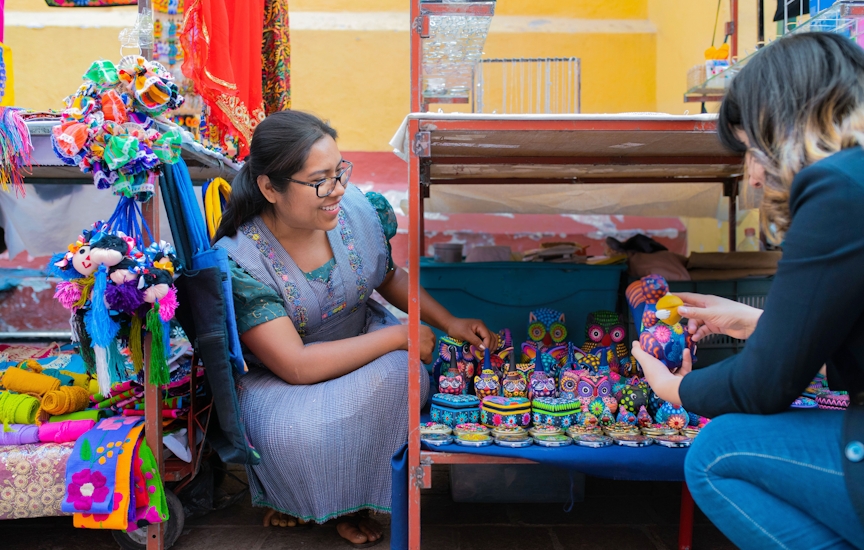
Purchase our award-winning guidebooks
Get to the heart of Querétaro with one of our in-depth, award-winning guidebooks, covering maps, itineraries, and expert guidance.
- Skip to primary navigation
- Skip to main content
- Skip to primary sidebar
Backpacking Brunette
Because life is not meant to be lived in one place
19 Best Things to Do in Querétaro, Mexico (Ultimate Travel Guide)
April 7, 2023 by Alex | Backpacking Brunette 13 Comments
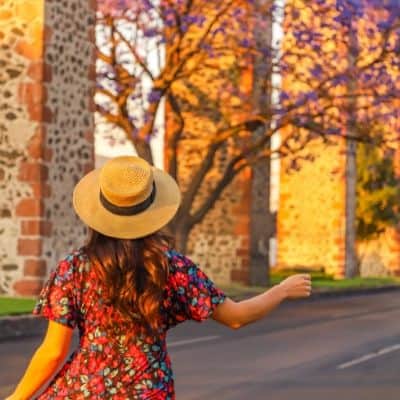
Wondering how to spend 2 days in Querétaro (or more)? Check out the best things to do in Querétaro!
Congratulations! If you’re reading this post, you’ve uncovered one of Mexico’s hidden gems: Querétaro.
For years, nearby towns like San Miguel de Allende and Guanajuato have overshadowed Querétaro. But, international travelers looking to experience authentic Mexico are quickly catching on that this colonial city is the place to be.
After reading this post, you will know the best things to do in Querétaro including:
- Most visited museums in Querétaro
- Where to drink craft beer
- How to visit a secret pyramid
- Best day trips from Querétaro
- & more!
Is Querétaro worth visiting? Keep reading for everything you need to plan the perfect 2 days in Querétaro!
Whether you decide to visit as a day trip, spend two days in Querétaro or begin a life as an expat here , following this comprehensive list of the best things to do in Querétaro will give you an experience you won’t soon forget.
Disclosure: This post may contain affiliate links, meaning I earn a small commission if you decide to make a purchase through my links (at not extra cost to you). Please read my disclosure policy for more info.
How to Get From Mexico City Airport to Querétaro
Located in central Mexico, Querétaro is easily accessible. Its UNESCO-listed historic center is worth the small effort it takes to get here.
The Primera Plus bus leaves directly from both terminal 1 & 2 of the Mexico City airport. You can purchase your tickets ahead of time online or directly at the counter.
The journey takes approximately 3 hours and costs $505 MXN (approx. $28 US).
An even more convenient option is flying into Querétaro’s small but well-connected airport. From there, it’s about a 30-minute Uber ride to the city center which costs approximately $15 USD.

How to Get From San Miguel de Allende to Querétaro
If you’re staying in San Miguel de Allende, you can make a day trip to Querétaro. Buses run every 20 minutes or so from 6 a.m. – 10 p.m.
There’s no need to book ahead. Just buy your ticket at the bus station from either Herradura de Plata or Flecha Amarilla.
From Querétaro’s Central de Autobuses, you can take an authorized taxi to the city center. The journey takes around 15 minutes and costs around $4 US.
When is the best time to visit Querétaro?
The best time to visit Querétaro is from October to March. This part of the year is the dry season, so clear skies & sunny days are likely.
It’s ideal to visit Querétaro from October to March because the temperatures are less extreme. You can expect highs around 78 degrees Fahrenheit (26 C) and lows around 50 degrees Fahrenheit (10 C).
Because Querétaro is a semi-desert, it gets cold at night and stays chilly through the early morning so be sure to bring a jacket or coat if visiting in December or January.
The hottest months of the year in Querétaro are April and May. Temperatures in the upper 80s F (30 C) are quite draining for tourist unaccustomed to the heat and intense sun.
The rainy season in Querétaro starts in June and runs through October. It’s normal to see daily rainfall during this time of year.
Perhaps the best time to visit Querétaro is December. Not only is it a good time of year weather-wise (just be sure to bring a jacket for cold nights), but the city is decorated beautifully with lights and poinsettias for the Christmas season.
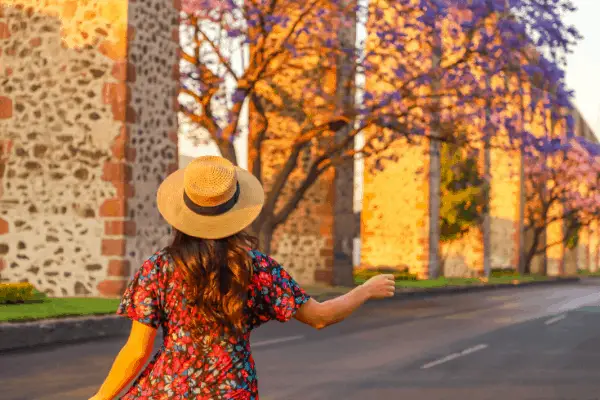
Is Querétaro, Mexico, safe for travel?
Before you dive into this list of things to do in Querétaro, let me take a quick second to discuss safety. I understand it’s a concern of many travelers visiting Mexico.
While I would never suggest completely throwing caution to the wind (awareness is key wherever you are in the world), you can take comfort in the knowledge that Querétaro is one of the safest cities in Mexico.
In fact, according to Wikipedia , multiple sources have ranked Querétaro as “one of the safest cities to live in with the highest quality of life in Mexico.”
I called Querétaro home for five years (from 2017-2022), and in all that time, I’ve never once felt in danger or, even, uncomfortable.
I feel confident recommending Querétaro as a safe destination for all travelers including solo female travelers.
For more about how to stay safe while traveling, check out this post with 35 do’s and don’ts for your first time in Mexico .
How do you get around Querétaro?
Querétaro’s city center is very walkable, so it’s easy to explore most of the city’s top attractions on foot.
For longer trips, you can utilize a ride share app like DiDi or Uber (just use it the same way you do in your home country).
Another budget-friendly option is Querétaro’s public bus system which runs all over the city. The route is often listed on the front windshield.
Where to Stay in Querétaro
If you’re planning your first visit to Querétaro, I highly recommend staying in the historic city center so you’re close to the top attractions and can experience the best the city has to offer.
One of the best hotels in Querétaro city center is El Serafin Hotel Boutique . Breakfast is included and the friendly staff brings it right to your door.
#1: Wander the Historic Center (an UNESCO World Heritage Site!)
From antique doors and colorful buildings to funky fountains and flower-covered houses, Querétaro’s centro histórico is the destination your Instagram grid has been waiting for.
In addition to being incredibly picturesque, Querétaro’s historic center is very clean. The city’s motto is “ Orgullo de Mexico ,” and based on the constant presence of street sweepers and lack of litter, Querétaro takes great pride in being the “Pride of Mexico.”
It’s no wonder the historic center of Querétaro is an an UNESCO World Heritage Site.
Many of my favorite streets in the city center are pedestrian-only. In fact, the calle I call home is actually an andador. Querétaro’s historic center is a walker’s paradise, and here are a few places you’ll want to stroll:
- Andador Libertad
- Andador Matamoros
- Calle Franciso I. Madero
- Calle Cinco de Mayo
- Calle José Maria Pino Suarez

#2 Take a Guided Tour in a Classic Model T
This has got to be one of the coolest ways to see Santiago de Querétaro: Cruising the city center in a Classic Model T.
During the one-hour guided tour, you’ll learn about the rich history and legends of Querétaro plus see many of the city’s top attractions like temples, churches & the 18th-century aqueduct.
This tour is available in English. You can book your tour here .
If you’re looking for a more traditional walking guided tour, you can finding daily tours leaving from in front of the government palace (Palacio de Gobierno). Most of these tour guides only speak Spanish.
#3 People watch in Jardin Guerrero
As you’re wandering the city, stop for a michelada and some casual people watching at one of the cafes that line Jardin Guerrero or one of these other beautiful plazas:
- Plaza Fundadores
- Plaza de Armas
- Jardín Zenea
The beautiful plazas of Querétaro give the city a charming European vibe. It’s lovely to see families gathered and enjoying the public spaces.
Just on the other side of Zaragoza from the city center, you can visit Alameda Hidalgo. During the pandemic, this park underwent major renovations & it’s the perfect place for a stroll.
#4: Have a Scavenger Hunt for the Most Notable Querétaro Monuments
The historic city center of Querétaro is very walkable (although, you should watch out for uneven cobblestones and random holes in the sidewalk).
Santiago de Querétaro is home to more that 1,400 monuments & one of the best things to do while visiting Querétaro is to make a game out of finding the most important ones.
These are some of the most notable Querétaro monuments in the historic center of the city:
- Dog lovers won’t want to miss this fun fountain in Plaza de Armas.
- A feminist icon, Josefa Ortiz was one of the heroes of the Mexican fight for independence from Spain.
- Switch your iPhone camera to the wide angle lens to get the impressive church in the background.
- Another picturesque spot, this monument is right next to Templo de San Franciso which also houses the Querétaro Regional Museum.
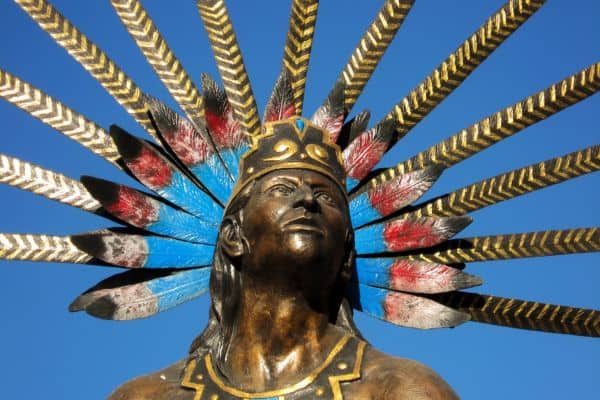
#5: Drink Wine and Eat Cheese
Chances are you’re visiting Mexico for the cerveza, tequila and mezcal. But, did you know that Querétaro produces some pretty good wine?
When you’re the country’s second-biggest wine region (right after Baja), it only makes sense to have a dedicated Wine & Cheese Route.
This guided tour is the best option for exploring the Wine & Cheese Route if you don’t have your own vehicle. In addition to roundtrip transportation from Querétaro, the tour includes wine tastings at Vino del Marques and Haciende Atongo plus time spent in Tequisquiapan and San Sebastián de Bernal.
Click here to learn more about the highly-rated Haciendas, Wineries and Magical Towns tour .
If someone is willing to be the designated driver, you can follow the Wine & Cheese Route on your own.
Check out Finca Sala Vivé by Freixnet is one of Querétaro’s most popular wineries & offers English-speaking tours. Their specialty is sparkling wine.
Bodegas de Cote is another fabulous winery to add to your Querétaro itinerary, and Cava de Queseos Bocanegra is a cheese cave. Both offer tours.
#6: Seek Shade in One of Querétaro’s Most Visited Museums
Looking to get out of the hot Mexican sun for an hour or two? Pop into one of Querétaro’s many museums.
While this list is by no means exhaustive, here are a few of my favorites:
Museo del Calendario – MUCAL Calendar Museum
Perhaps one of the most unique museums in Querétaro, the calendar museum is a lot more interesting than it sounds. Arrive early and have breakfast in the lovely garden cafe as part of your visit.
- Calle Franciso I. Madero 91
- Open Tuesday – Sunday; 10 a.m. – 6 p.m.
- Closed Monday
- Cost: $30 pesos
- Official website
Museo de Arte de Querétaro – Art Museum of Querétaro
Housed in a former monastery, the Museum of Art is one of the most impressive buildings in Querétaro. The carved archways are reason enough to visit.
- Calle Ignacio Allende Sur 14
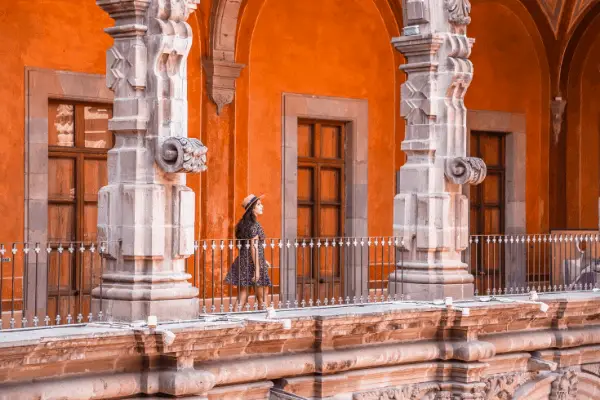
Museo Regional de Querétaro – INAH Querétaro Regional Museum
Once Querétaro’s cathedral, this building is now home to the state’s regional museum. While most of the text in the museum is in Spanish, you can still enjoy the collection of pre-Columbian ceramics and sculptures.
- Coregidora s/n
- Open Tuesday – Sunday; 9 a.m. – 6 p.m.
- Cost: $60 pesos
Museo de Arte Contemporáneo – Museum of Contemporary Art
One of the newer museums in Querétaro, the contemporary art museum opened in Nov. 2018. The building, which houses works from local and national artists as well as international exhibitions, was formerly a convent.
- Manuel Acuna s/n
Museo de la Casa Zacatecana
See how the wealthy lived during the 19th-century in Querétaro. If period furnishings don’t intrigue you, perhaps this mansion’s tale of murder will.
- Calle Independencia 59
#7: Spend a Quiet Moment in One of Querétaro’s Churches
If you’re feeling museumed-out (it happens to the best of us) & want a quiet place to escape the sign, one of Querétaro’s many churches will provide the perfect refuge.
Santiago de Querétaro is home to dozens of churches, temples and convents. Even for Mexico, Querétaro has quite the collection of religious sites.
- Step inside to marvel at the 18th-century baroque architecture.
- At nighttime on the weekend, the fountain out front is all lit up.
- Snap a photo with el Danzante Conchero or get a wide-angle shot from Jardin Zenea just across the street.
- With its floor to ceiling gold interior, this temple’s interior is certainly something to see.
- See the famous “tree of the cross” with thorns that grow in the shape of crosses.
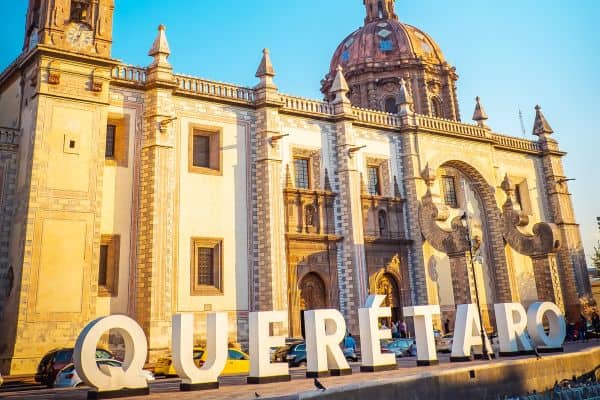
#8: Eat Enchiladas Queretanas at One of the Best Restaurants in Querétaro
With all this sightseeing, you’re sure to work up an appetite. One of the best things to do in Querétaro is try enchiladas queretanas —the city’s own twist on this popular Mexican dish
Served with salsa verde, enchiladas queretarnas are filled with chicken, potatoes and carrots. If you’re lactose intolerant, be sure to ask for them sin crema (without sour cream).
One of the best places to try typical regional food as well as classic dishes from all over Mexico is Chucho El Roto.
This restaurant is located right in Plaza de Armas, and since it’s popular with tourists and locals alike, be sure to make a reservation.
#9: Marvel at an Ancient Pyramid in Querétaro
Teotihuacán and Chichén Itzá aren’t the only pyramids in Mexico (far from it, actually). Thanks to the Chichimecas, Querétaro has one of its own: El Cerrito .
You won’t be able to climb the pyramid, but you can admire it from multiple sides. There’s even a Spanish-language museum to learn about this long-buried pyramid which was once an important place of worship in Querétaro state.
El Cerrito is a 20-minute Uber ride from the city center. If you prefer public transportation, you can catch the bus from Avenida Zaragoza.
- Open Wednesday – Friday from 9 a.m. – 4:30 p.m.
- Closed Monday & Tuesday
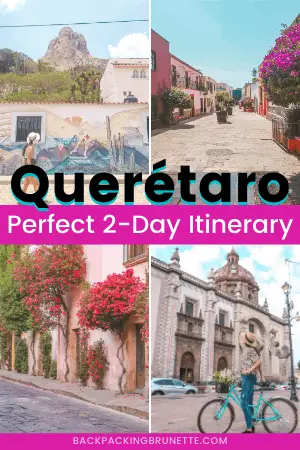
#10: Stand in the (Literal) Shadow of a Political Giant at Cerro de las Campanas
One of the most important historical sites in Querétaro, “The Hill of the Bells” is where Mexico officially took the country back from France. In 1867, Habsburg Emperor Maximilian was executed by firing squad.
It’s not the most cheerful bit of history, but the surrounding grounds are quite beautiful. Cerro de las Campanas is one of two national parks in Querétaro (scroll down to #11 for how to visit the other national park).
At the center of the park, you’ll find a gigantic statue of Benito Juárez , who was president of Mexico both before and after Habsburg rule.
Cerro de las Campanas is located on the eastern edge of the city center, so depending on where you’re staying it could be a bit of a trek. Personally, I enjoy the hour-long walk and think it’s a nice way to get to know Querétaro.
- Open Tuesday – Sunday; 9 a.m. to 5 p.m.
- Small entrance fee ($5 pesos or $15 pesos with museum entry)
#11: Take a Spooky Stroll & Hear Scary Stories
Get to know the spooky side of Querétaro with a nighttime walking tour around the city center.
During the guided tour, you’ll learn about the myths and legends associated with the city. Accompanied by live music, enthusiastic actors take you to historic buildings and retell scary stories.
The group tour ( learn more here ) is only available in Spanish, but private tours are sometimes available in English.
#12: Sip Craft Beer in an Old Textile Factory
If after visiting Querétaro’s traditional cantinas (La Selva Taurina is one of my favorites) you decide you want to grab a pinta somewhere with a more hipster vibe, hop in an Uber to Jardín de Cerveza Hércules .
Formerly a textile factory, this beer garden is undoubtedly one of the coolest places in the city. I recommend ordering a pint of the República or the Ráfaga, and you can’t go wrong with a pizza.
- Avenida Hércules Ote 1
- Open every day; 10 a.m. – 10 p.m. (midnight on the weekends)
If you’re looking for craft beer closer to Querétaro city center, check out Almacén Hércules (Avenida Universidad Oriente 156) which offers all the same beers as the main brewery. On the weekends, there are often interesting local events such as artisan markets.
#13: Experience Local Culture at Mercado La Cruz
One of the best things to do in Querétaro is visit Mercado La Cruz.
From the brightly colored piñatas hanging from the rafters and the whir of blenders mixing up fresh jugos (juices) to the slight softness of an almost ripe avocado and the delicious smells wafting from the food vendors, Mercado La Cruz is a delight for all your senses.
Keep the sensory stimulation going and join the locals to eat a meal in Mercado La Cruz.
One of the most popular places to eat is Gorditas El Güero y Lupita. The “mixta” comes with cheese and migajas (crumbled meat) as is topped with lettuce—don’t forget to top it with some salsa.
After gorging myself on gorditas, I like to grab a fresh juice. There are lots of different vendors, but I like depresión from La Güera which is made with beet, apple, spinach and carrot.
Mercado La Cruz is open daily from 7 a.m. to 7 p.m. To see the market at its busiest and best, plan your visit for Sunday.
Please be respectful about taking photos . Be sure you buy something from the vendor first.

#14: Admire the Impressive Querétaro Aqueduct
Erected in the early 1700s, Querétaro’s impressive 75-arched aqueduct is impossible to miss.
For the best view, stroll up to the Mirador de los Arcos just beyond Plaza Fundadores. At night, it’s especially spectacular as the arches are all lit up.
For the perfect Instagram snapshot of you in front of Los Arcos, you better wake up early. The road that runs parallel to the aqueduct is one of the busiest in Querétaro.
Position yourself near a streetlight and take advantage of stopped traffic to get your photo.
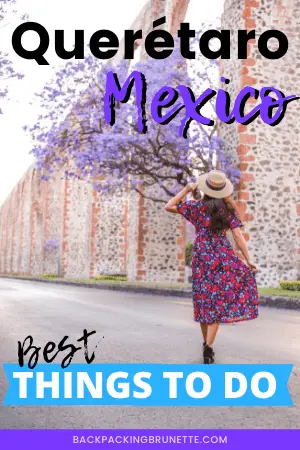
#15: Enjoy the Nature at El Cimatorio National Park
If you’re looking escape the city and relax in nature, Parque Cimatorio is one of the best things in Querétaro.
This national park is located a 10-minute drive from Querétaro city center. Don’t have your own set of wheels? You can get out there and back using Uber or a regular taxi.
My favorite time of day to visit El Cimatorio is during the morning. There’s not much shade out there (the majority of vegetation are cactuses), so it’s a good idea to plan your hike, run or mountain bike ride for before the hottest part of the day.
Be sure to pack your own water & a snack. You should wear a hat & plenty of sunscreen.
Hours of operation: Thursday-Sunday from 7 a.m. – 1:30 p.m. Closed Monday-Wednesday
#16: Hike Up Peña de Bernal (One of the World’s Largest Monoliths)
You can’t visit Querétaro and NOT make the trip out to see the world’s THIRD-LARGEST monolith.
Even if you’re not a geologist, I still highly recommend setting aside a half-day (at least) to check out Querétaro state’s most magical pueblo mágico . The small town of San Sebastián de Bernal and its giant rock won’t disappoint.
Get all the details about how to get there and what to expect for hiking up the Peña in this blog post about planning a Bernal day trip from Querétaro .
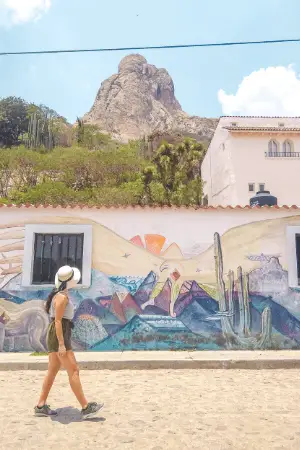
#17: Choose One of These Amazing Day Trips from Querétaro
Because I like hiking, Bernal is my favorite day trip from Querétaro. However, it’s not the only one.
Here are some more of the best day trips from Querétaro that would make great additions to your itinerary if you have the time:
Tequisquiapan
Don’t worry, you can just call it “Tequis” for short.
If your idea of the perfect day trip involves wine and cheese, this is the getaway for you. Check the local calendar to see if your visit coincides with one of the almost-monthly wine festivals.
Looking for the perfect souvenir to remember your time in Querétaro? Plan a day trip to Amealco to visit the birthplace of the Muñeca Queretana.
Indigenous women make and sell these beautiful dolls. The town even has an entire museum dedicated to the handicraft.
Dolores Hidalgo
Located in neighboring Guanajuato state, Dolores Hidalgo is known as the birthplace of Mexican Independence.
After soaking up the history, enjoy some of the town’s famous artisanal ice cream while browsing the shops filled with colorful Talavera ceramics.
#18: Shop for the Perfect Souvenir (Best Things to Buy in Querétaro)
Even if you’re not usually a souvenir person, the street vendors in Querétaro have some incredibly beautiful wares.
In additional to the typical magnets and t-shirts, you can shop gorgeous handicrafts. Local artisans from the indigenous communities surrounding Querétaro travel to the city center to sell their traditional crafts.
One of the best things to buy in Querétaro is the Muñeca Queretana. This handcrafted doll is named Lele, and she’s one of the symbols of the city—you can even find her likeness on the crosswalk lights.
#19: Escape to the Sierra Gorda Biosphere Reserve
After a few days in Querétaro, you might feel the urge to escape the city center and explore more of the state.
The Sierra Gorda Biosphere Reserve is the center of ecotourism in the state. It’s a popular place for camping, hiking, bird watching, mountain biking and other outdoor activities.
Buses leave daily from Querétaro, and it’s best to make either Pinal de Amoles or Jalpan de Serra your base for exploring the region.
Learn more about planning your own trip to the Sierra Gorda in this post.
How to Spend 2 Days in Querétaro
While many people opt to visit Querétaro as a day trip, I think it’s best enjoyed when you have at least one night to spend here.
With 2 days in Querétaro, you can start with breakfast in Plaza Fundadores. There are several cafes facing the plaza
After breakfast, make your way from one side of the city center to the other with a leisurely stroll over to Cerro de las Campanas. On the way, hit as many of the streets, plazas and churches I mentioned at the start of this post.
When you pass through Plaza de Armas, make a dinner reservation at Chucho El Roto. It’s on the pricier side, but the quality, ambiance and service is more than worth the extra pesos.
From Cerro de las Campanas, order an Uber to take you to Jardín de Cerveza Hércules for lunch. But, don’t indulge too much since you still have a pyramid to see.
Order another Uber to take you from Jardín de Cerveza Hércules to El Cerrito. Make sure you have your sunscreen!
You’ll likely have made an early dinner reservation in order to finish before the Leyendas y Mitos Tour.
If the myths and legends of Querétaro haven’t made you too afraid of the dark, finish your evening with a walk up to the Mirador de los Arcos to see the aqueduct in all its glory.
For a nightcap, I recommend grabbing a drink at either La Selva Taurina (a traditional cantina) or Dodo Cafe (a cocktail bar). Both are located on Calle Independencia as you follow it back from the Mirador toward the city center.
It would be wise to call it a somewhat early night since the next morning you have an early bus to catch to Bernal. Beat the crowds and hike up the Peña first thing.
Your reward for making it to the top (and back down) is Bernal’s famous gorditas.
With 2 days in Querétaro, you can get a taste for what the city has to offer. If you have more time, try to squeeze in the Wine & Cheese Route tour which takes you to both Bernal and Tequisquiapan.
More Posts About Things to Do in Querétaro
- Hiking in Querétaro’s Stunning Sierra Gorda
- How to Get to Guanajuato From Querétaro & Best Things to Do
- Self-Guided Day Trip From Querétaro to Bernal
Is Querétaro Worth Visiting?
Yes, Querétaro is absolutely worth visiting. Querétaro’s historic city center is a UNESCO World Heritage Site and one of the great hidden gems of Mexico.
While the suggestions in this post will help you figure out how to spend 2 days in Querétaro (or more), tours, historical sites and craft beer aren’t the only reasons to visit Querétaro .
If you’re the type of traveler who enjoys getting off the beaten path and is interested in experiencing the true essence of Mexico for yourself, you will love Querétaro. A visit here is an opportunity to immerse yourself in authentic Mexico.
Who knows, after you visit, you might even want to move here. Many foreigners, myself included, think living in Querétaro is one of the best places for expats in Mexico.
At the very least, you should plan a visit to Querétaro and see this underrated city for yourself. If you have any questions about things to do in Querétaro, leave a comment below.
Best Things to Do in Querétaro, Mexico
Reader interactions.
August 20, 2020 at 11:35 am
Today’s (useless) trivia fact: In the New World, wine has been grown the longest in Mexico (since the 16th century).
They did try going wine in the 13 Colonies (the present day US), but phylloxera would destroy the vines.
August 28, 2020 at 4:46 pm
Huh, you learn something new every day! I need to do more wine tasting in Mexico ? Thanks for the fun fact!
August 25, 2020 at 9:30 am
August 28, 2020 at 4:45 pm
Hi, Becky! Thanks for reading & taking the time to leave a comment. Any plans to visit Querétaro soon? All the best, Alex
October 8, 2020 at 8:06 am
I love your blog!! So happy I stumbled upon it. I’m planning a trip here with my boyfriend next week and was wondering how long you would recommend visiting? A week? Two? A month?
October 12, 2020 at 12:59 pm
Hi, Aurora! I’m so glad that you’re finding my blog helpful.
I suppose “how long” depends on how much time you & your boyfriend have. Queretaro is very well-situated in Mexico, so you could lengthen your trip & have no trouble finding lots to do. Guanajuato, San Miguel de Allende, la Husteca Potosina &, of course, Mexico City are just a few of the amazing places around Queretaro that you could add to a longer itinerary. For day trips, I highly recommend Bernal which is home to the third-largest monolith in the world!
I hope you enjoy your time in Mexico & thanks for reading!
October 14, 2020 at 6:28 am
Thanks!! I arrived a few days ago and was planning on staying for 2 weeks but will probably extend it because I’m already in love with this beautiful city hahaha
May 2, 2021 at 8:31 pm
Love your blog….very helpful! My husband and 3 adult sons are planning our first trip to Mexico in June. We are flying into Mexico City and then directly to Queretero for 4 nights before heading to San Miguel and then onto Guanajuato before heading back to Mexico City. We still haven’t planned our transportation from the airport nor from each city. What do you recommend? I see that you can get a bus from the airport to Queretero…is that fairly easy? For a family of 5 what do your suggest?
May 12, 2021 at 3:13 pm
I am wondering whether/how I can check out some wineries and cheese caves if my base is in Guanajuato/San Miguel de Allende? can you please help me?
September 7, 2022 at 9:15 pm
Heart of Mexico Wine Tours: https://heartofmexicowinetours.com/
January 24, 2022 at 8:27 am
Thank you for your suggestions. I am a runner and I am going to visit Queretaro in a couple of week. Is the area runner friendly? Any recommendations on where I could stay and run?
December 2, 2023 at 2:54 pm
Greetings. Does Queretaro close streets on Sundays for bike riding/walking/skateboarding?
December 8, 2023 at 2:05 pm
Hi, Stephen! Thanks for reading! Queretaro has a Bicivia Recreativa every Sunday from 8 a.m. to noon where the city closes streets to cars: https://www.diariodequeretaro.com.mx/deportes/regresa-la-bicivia-recreativa-a-la-capital-queretana-9964113.html#:~:text=La%20Biciv%C3%ADa%20Recreativa%202023%2C%20se,los%20talleres%20de%20ajedrez%2C%20manualidades .
Leave a Reply Cancel reply
Your email address will not be published. Required fields are marked *
Save my name, email, and website in this browser for the next time I comment.

Privacy Overview
Querétaro Travel Guide: 27 Things to Do and See
Welcome to this comprehensive Querétaro travel guide! This colonial city in central Mexico is a must-visit destination for travelers seeking history, culture, and natural beauty. With its well-preserved architecture, delicious local cuisine, and numerous attractions, Querétaro has something for everyone. In this Querétaro travel guide, I’ll take you through the top things to do in Querétaro, including exploring the historic center, visiting UNESCO World Heritage sites, and indulging in evening storytelling tours. Whether you’re a first-time visitor or a seasoned traveler, this travel guide will provide you with all the information you need to plan a memorable trip to Querétaro.
Located in central Mexico, Querétaro is a city steeped in history and cultural significance. Founded in the 16th century, it played an important role in the Mexican War of Independence and was the site where the country’s constitution was signed. The city is home to well-preserved colonial architecture, ancient churches and monasteries, and several UNESCO World Heritage sites, making it a popular destination for visitors seeking a glimpse into Mexico’s rich past.
If you’re looking for more info about Mexico, click here. Check out the Pueblo Mágicos near Querétaro: San Miguel de Allende , Bernal , and Tequis .
What can I see and do in Querétaro?
Querétaro travel guide: activities to do in querétaro, go shopping in the markets.
There are some fantastic shops and markets in Querétaro. There are markets lining the two cross streets where the “Escultura del Flautista” sits- Calle Vergara Sur and Libertad. You can also find a number of great shops along peatonal streets Calle 16 de Septiembre and Francisco Madero. Just keep in mind that Querétaro has some of the highest prices of souvenirs and market items I’ve seen anywhere in Mexico. If you plan on visiting other cities, don’t do your shopping here. I found Guadalajara and Mexico City to have the most reasonable prices. What is a Querétaro travel guide, really, without adding in some shopping.
Take a tramvia tour
Take a driving Querétaro travel guided tour on the tranvía around the city. It’s a great way to introduce yourself to Querétaro and learn about certain areas and buildings before venturing out on your own. The cost is 200 pesos, and it lasts about 75-90 minutes. You can sign up at the tourist kiosks around town.

Listen to legends and myths of Querétaro
This was one of the best things I did in Querétaro, and if there is one takeaway from this Querétaro travel guide, it’s- do this tour (if you speak Spanish)! The tour lasts about 90 minutes and takes you around the center of Querétaro telling story and legends of the city. But it’s not just storytelling. There is action, and drama, music, and sound effects. You can really learn a lot from the tour in a really fun way. There are 2 tours per day (7 pm, 9 pm) on Fridays, Saturdays, and Sundays. The cost is 200 pesos ($11 USD). You can sign up for the tour by calling 442-212-4565, or sign up on the street. Look for people in costume during the day near the Plaza de Armas.
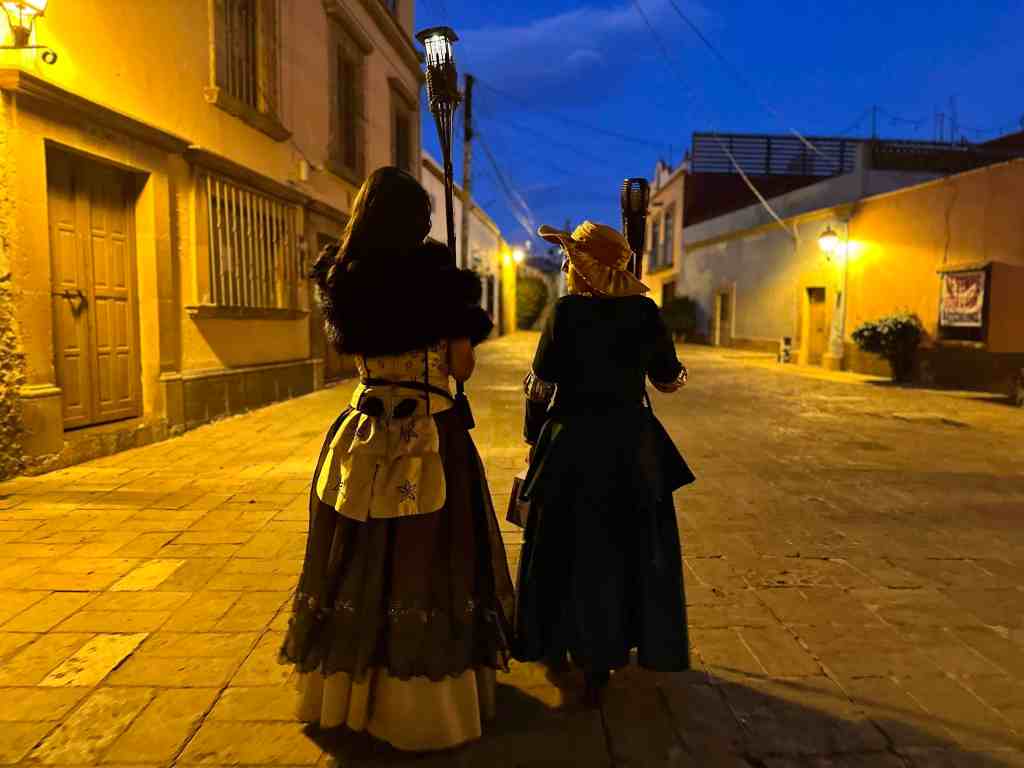
Take a Tour of the Wine & Cheese Region
The state of Querétaro is known in Mexico for its wine. Any Querétaro travel guide you find will suggest this in some form or another. In Santiago de Querétaro, as well as the several Pueblo Mágicos in the region, you can do a half day wine & cheese tour. You’ll be able to do tastings and samplings from the region. The tour costs 750 pesos, and you can sign up with any of the tourism kiosks in the city, or contact Gloria Martinez for reservations:
[email protected], +52 42 11 03 65 70
Querétaro Travel Guide: Statues of Querétaro
El danzante conchero chichimeca.
This is an interesting statue built just next to a colorful red church, San Francisco, right in the zona centro. This statue and fountain was supposedly constructed based on the myth of how the city of Querètaro was founded. The local tribe, Chichimeca, was in a battle with the Spaniards. Just when they were about to win, there was a Solar eclipse which frightened the local tribe. Another reason for the statue is to honor the Chichimeca dancers. Try to come in the evening to see it with the night lights if the city.

Monument of the Corregidora
This monument was built in honor of Doña Josefa Ortiz de Domínguez, a national heroine who played a key role in the Mexican War of Independence. The monument features a statue of Doña Josefa and is a popular spot for visitors. It’s right next to the shopping/restaurant/cafe street of 16 de septiembre, so you could even get a drink and admire it a while.
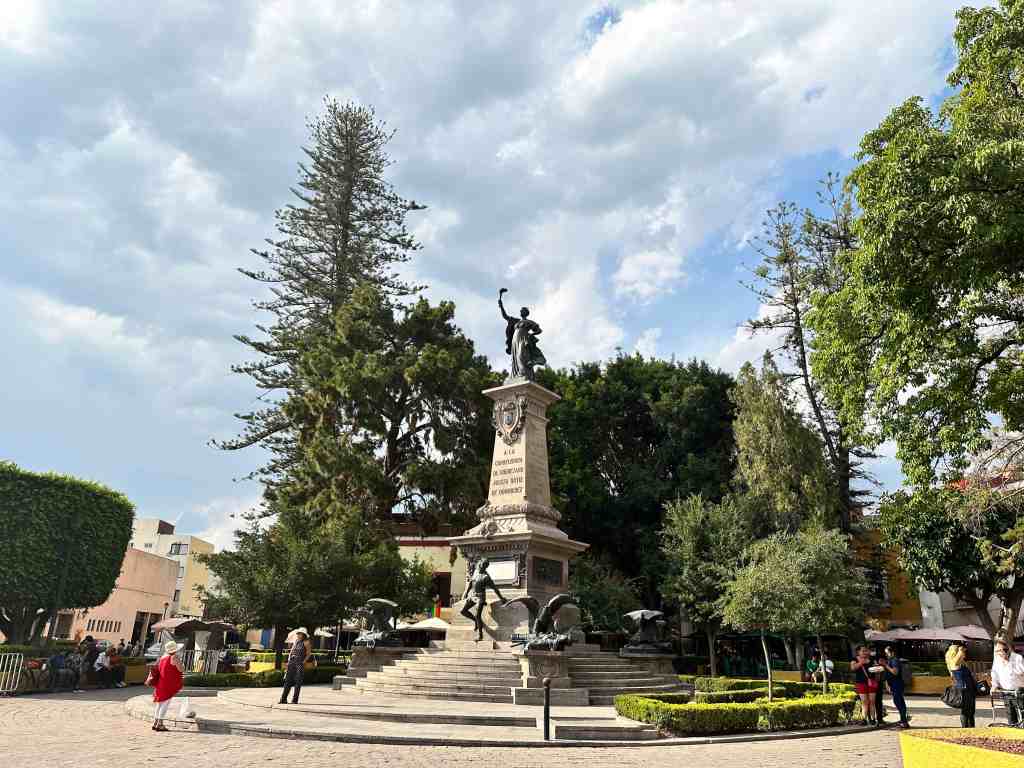
Escultura “La Flautista”
“La Flautista” is a bronze sculpture created by Mexican artist Jorge Marín. It depicts a woman playing a flute while perched on a large rock. The sculpture is known for its intricate details, particularly in the woman’s dress and the delicate curves of the flute. You can find this statue right at two cross streets of the city market.
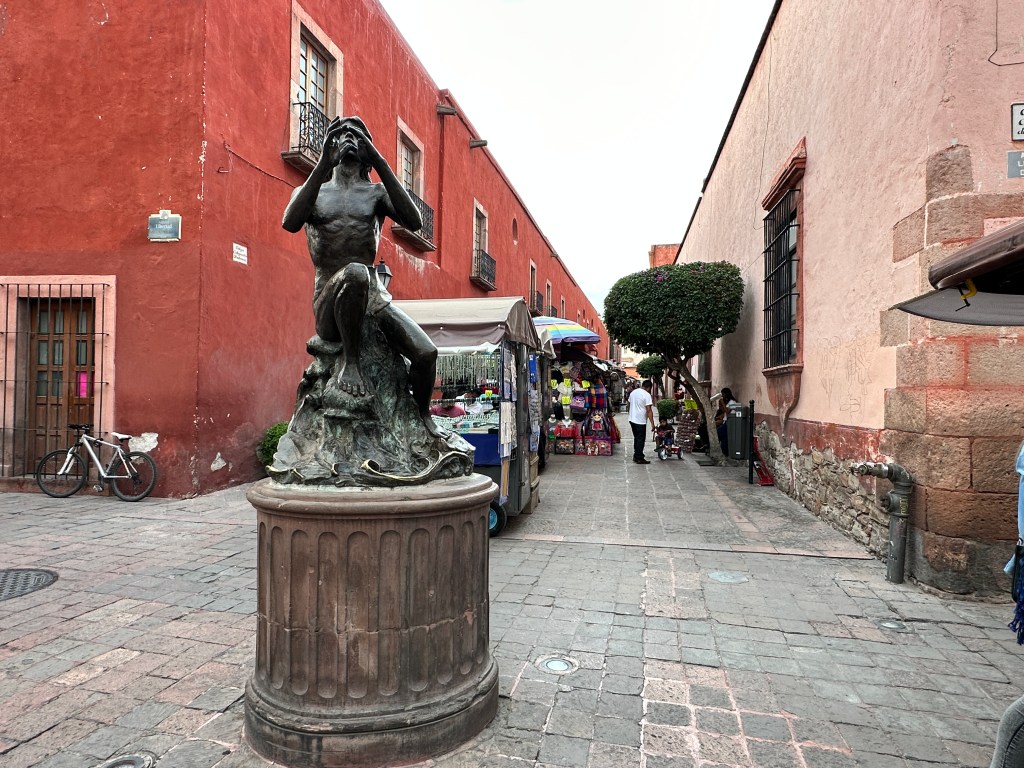
Neptune Fountain
The Neptune Fountain is a famous landmark featuring a statue of Neptune, the Roman god of the sea. The fountain is a popular attraction due to its intricate design and beautiful craftsmanship. It is often featured in photos and postcards, and is considered a symbol of beauty and elegance. You can find it easily along the foot-traffic street of Francisco Madero. It’s right on the corner.

Fuente de “Los Perros”
Fuente de “Los Perros” is a bronze fountain located in the center of the Plaza de Armas. It was built during the Porfiriato, a period of Mexican history from 1876 to 1911, and features several sculpted dogs standing on their hind legs. The fountain is an iconic symbol of the city and a popular spot to take photos and have a rest.
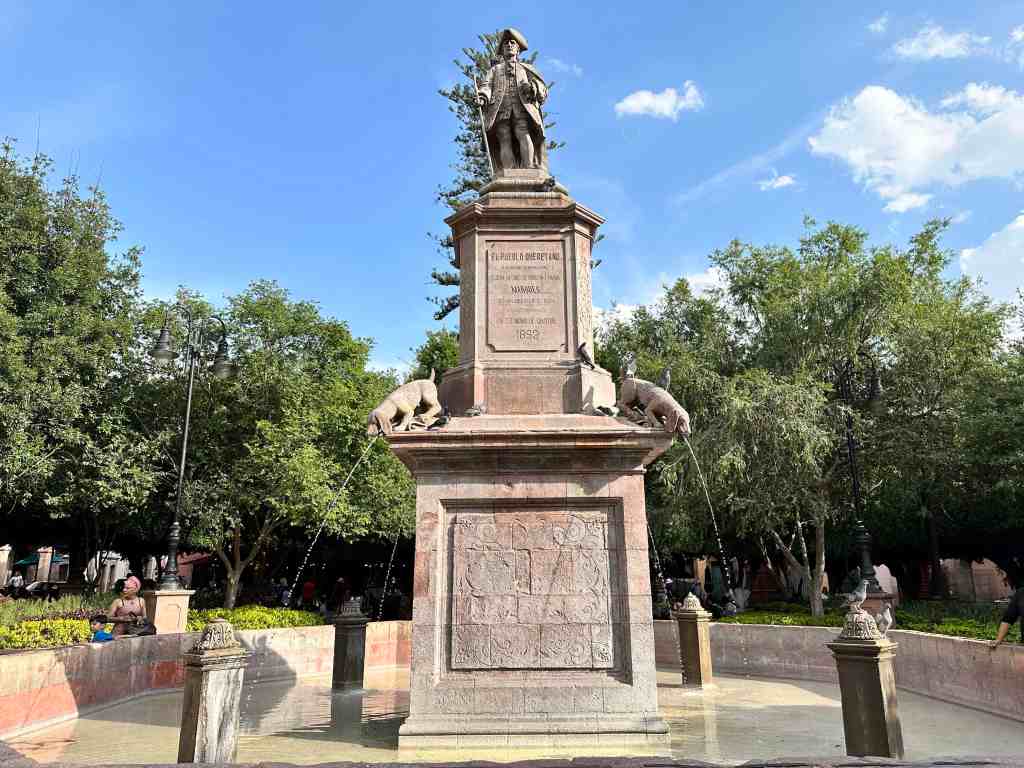
Querétaro Travel Guide: Plazas and Parks of Querétaro
Zenea garden.
Zenea Garden is a public park located right in the center of the city. The park features gardens, fountains, and walkways for visitors to enjoy. It’s a popular spot for locals and tourists to relax, people-watch, and attend concerts and events held throughout the year. During the day there are often people selling craft items, and children playing and riding bikes in the center. In the evenings it comes alive. There are occasionally dance events (like pictured below) or concerts. On holidays, market stalls are set up in the garden.
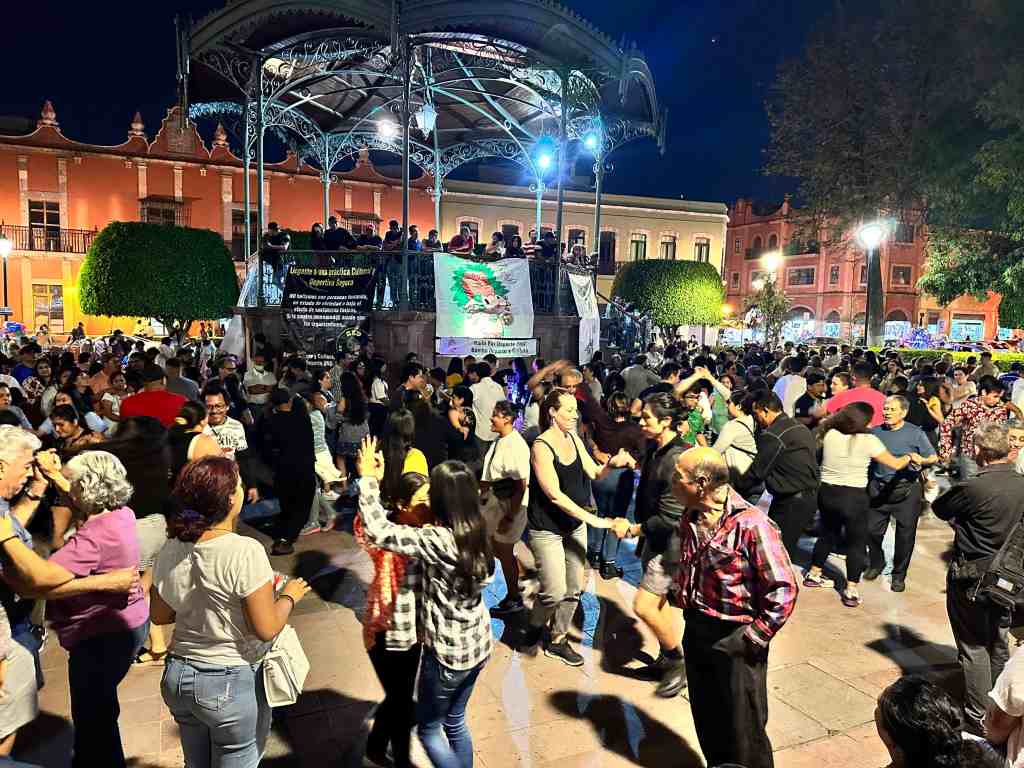
Plaza de Armas Querétaro
Plaza de Armas is the main square of Querétaro, and is surrounded by historic buildings and landmarks. It is a popular gathering place for both locals and tourists, with numerous benches and shady trees to relax under. At the center of the square stands a kiosk, where live music and cultural events are often held. All around the edges are (more expensive) restaurants, cafes, and shops.

Jardín Guerrero
Jardín Guerrero is a concrete park. There are benches to relax, and trees lining the edges. There is also a basketball court. The space is often used for events so you might find tents set up. The park is named after Vicente Guerrero, a national hero who played a key role in Mexico’s struggle for independence from Spain. The park dates back to the 16th century. A convent was meant to be built there but then the idea was scrapped. You can find the Templo de la Congregación, a historic church located adjacent to the park.
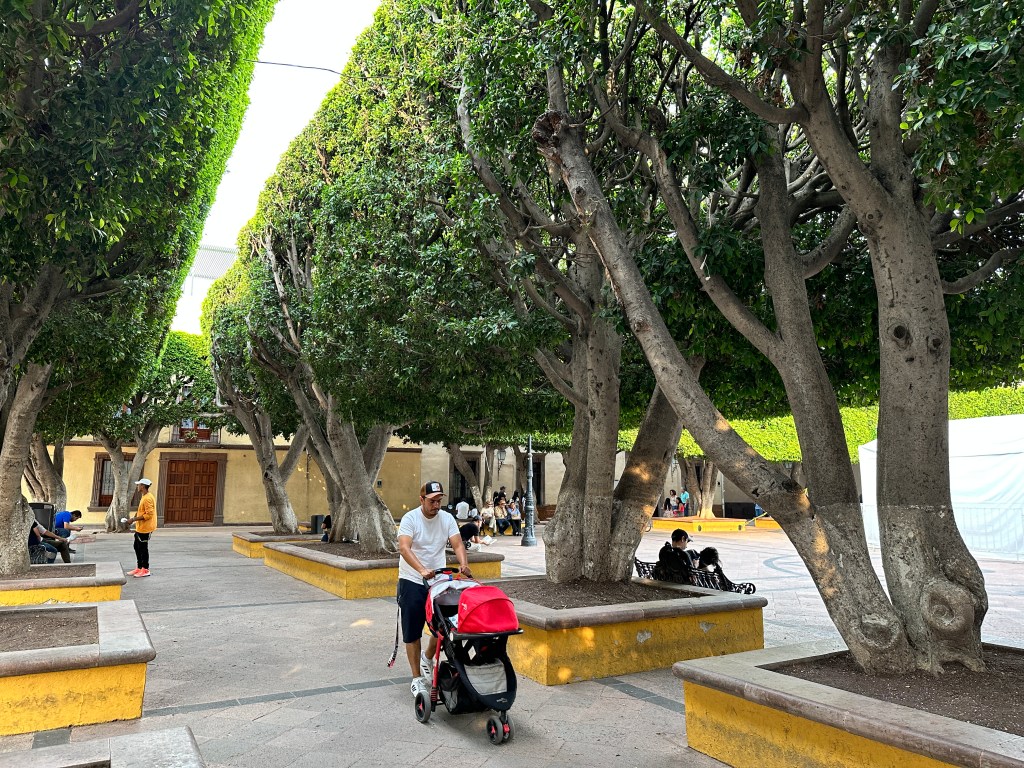
Alameda Hidalgo
Alameda Hidalgo is a public park located just south of the city center. It has beautifully landscaped gardens, fountains, and statues, making it a great place to walk, read, relax, or have a picnic. The park also hosts various cultural events and activities throughout the year. They close the gates on some holidays.
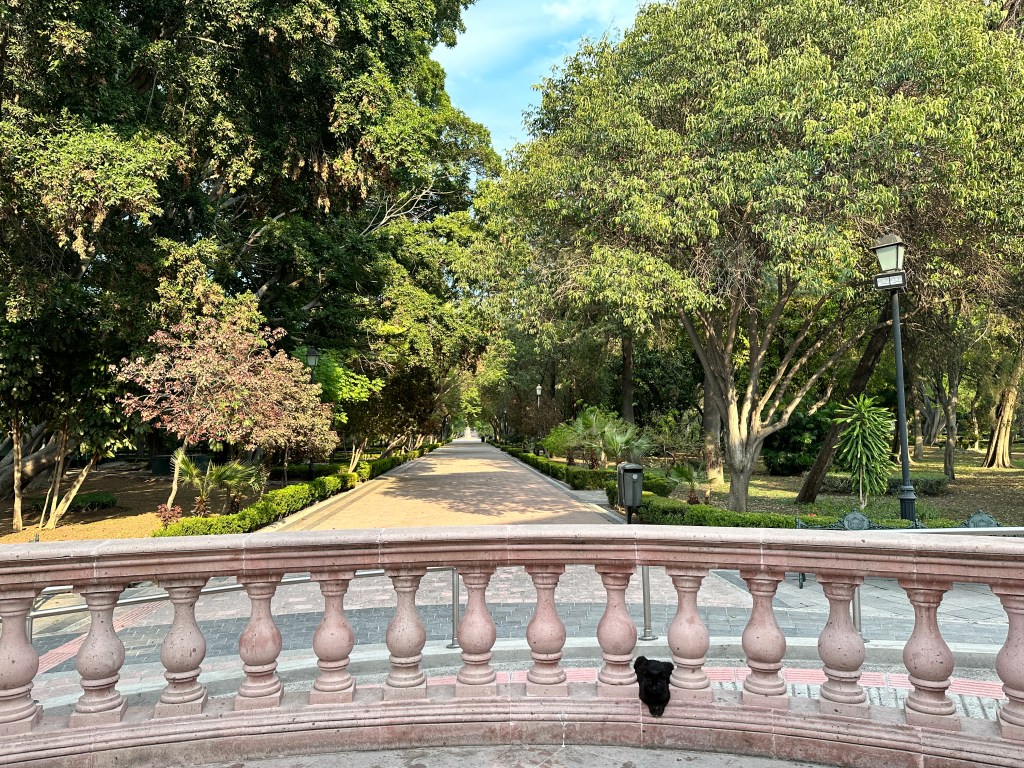
Plaza de los Fundadores
Plaza de los Fundadores is a historic square just next to the Ex-Convento de Santa Cruz (the big yellow church). It was built in the 16th century and served as the main hub of commerce and politics in the region. The plaza features a beautiful fountain, a bronze sculpture of the founders, and is surrounded by several historic buildings, including the Casa de la Corregidora. You can also find the Museum of Contemporary Art of Querétaro (MACQ) there. There are often different fairs and market stands set up here.
Mirador de los Arcos
From this lookout point, you can get a nice view of the city below, and the long aqueduct. Unfortunately the aqueduct is a bit far away so it’s actually a bit hard to see in the photos. But it’s a nice place to spend a half hour. There are raspado sellers, and markets in the plaza just next to the lookout. While you’re here, take 3 minutes to walk down the hill and see the aqueduct up close.
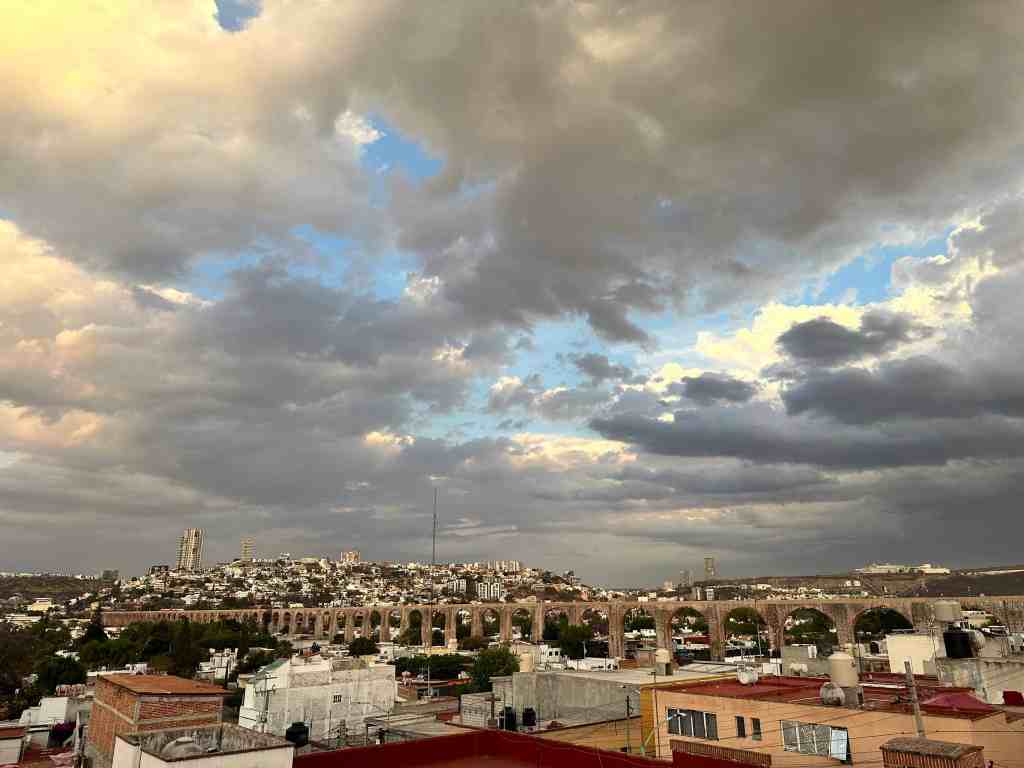
Acueducto de Querétaro
The Aqueduct of Querétaro is a remarkable feat of colonial engineering that spans over 1,200 meters in length. The aqueduct was constructed in the 18th century to bring water from nearby springs to the city. Its towering arches, built without the use of mortar, are an impressive sight and have made it one of the most iconic landmarks in Querétaro. If you do the Leyendas y Mitos Tour, you’ll learn about the nun who made this possible.

Querétaro Travel Guide: Museums in Querétaro
Museo regional de querétaro.
The actual building that this museum is in, is an old convent several hundred years old. The architecture and the inner courtyard with a fountain are stunning and the best part of the visit. You can capture beautiful photos here.
The information in the museum is ALL in Spanish, and very information heavy. If you speak Spanish, and enjoy large blocks of text, then this could be an enjoyable experience for you. It would take several hours to go through the entire museum and read everything. If you are fine with just walking around and perusing the old artifacts, clothing, and paintings, it could also be somewhat interesting.
I felt the museum had a lot of potential and a lot of interesting info that i would have liked to learn, but the large quantities of text in Spanish made it feel overwhelming and dissatisfying.

Museo de los Conspiradores
It’s free to enter, so you can just enter and do a quick stroll around. The man at the entrance will ask for your name and country. The museum consists of mainly one floor with 3-4 small rooms. The walls have large murals and descriptions of several different conspirators within the Americas at the time of independence. There is a lot of information to read. All the information is in Spanish, written in calligraphy by hand.

Museo Casa de la Zacatecana
I really enjoyed this museum. It’s very well organized and laid out. There is just the right amount of information, to not feel overwhelmed. Information in English is available.
I came here the day after I did the Leyendas y Mitos tour because they had told the mysterious legend about the husband and wife who once lived here. The wife had the husband murdered, and was later murdered herself under mysterious circumstances. The museum has a good balance of telling this Leyenda and providing information about the culture and style of life back in those times.
You will start the tour with a video (available in English), and then go thru the first 4 rooms downstairs. Then you will go upstairs and watch another video, and visit the remaining rooms. There is also a lookout point in the covered roof tower. The people who work here are helpful and friendly.
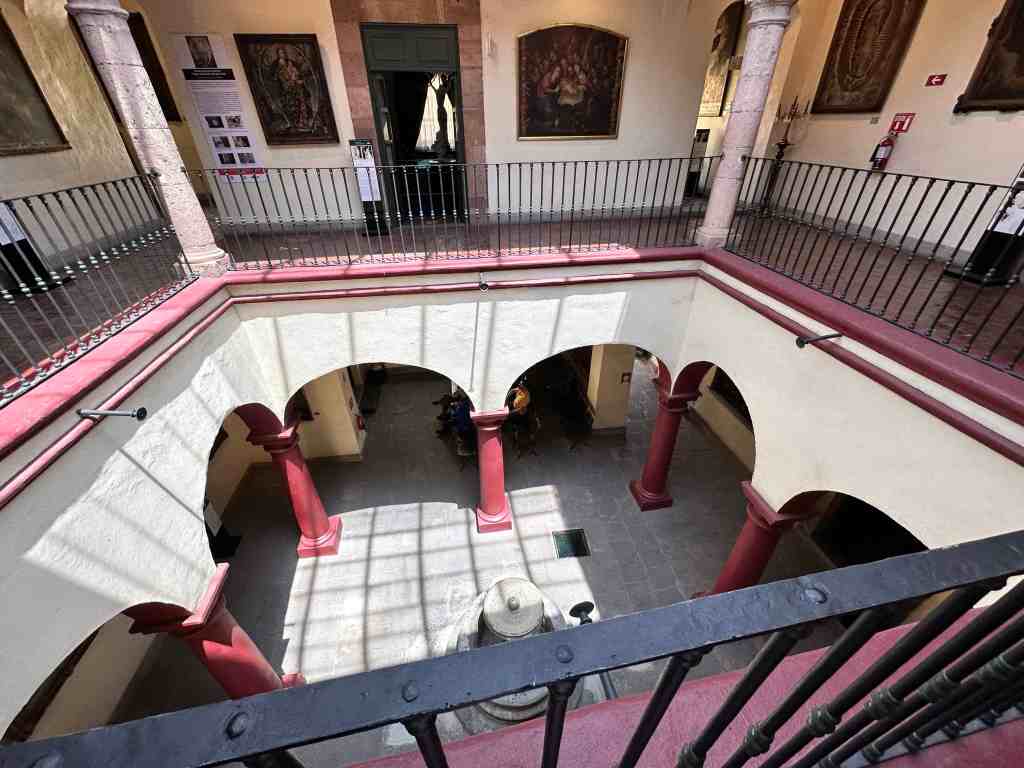
Museum of Contemporary Art of Querétaro
There was just one hallway open when I went, with about 6 different rooms open. There are alternating exhibits upstairs, so you will be lucky if you can catch the museum when the new sections are open. It’s free and it doesn’t take too much time, so it’s worth it to pop in. You’ll need to check your bag and water bottles at the front entrance.

Pantheon of Illustrious Querétanos
This is a small building, and inside there are a few paintings and old portraits of men who did stuff in Querétaro, although there is not much explanation. The outside gardens are really nice. The building from the outside is quite cute and there are several statues. It will only take a couple minutes to visit, so you might as well stop by. It’s just next to the mirador de Los Arcos.
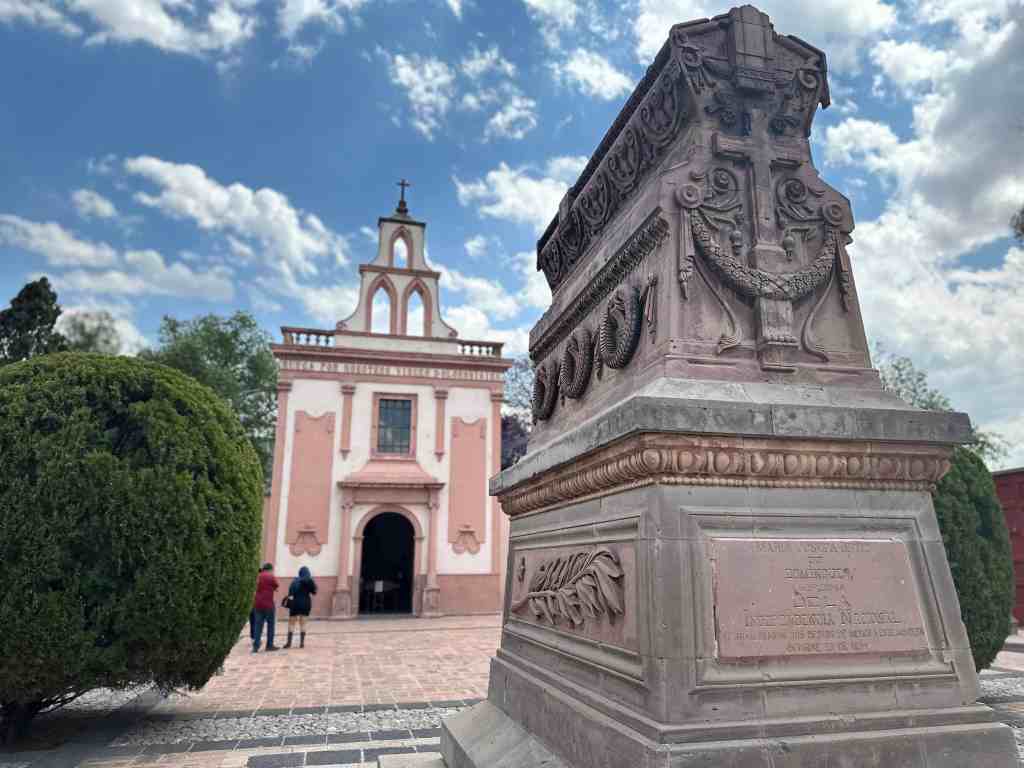
Querétaro Travel Guide: Eat & Drink in Querétaro
Alquimia bar.
This bar is very cozy. There is a stylish bar in the front with several bottles of alcohols. In the back there is a dark lounge room. They play good music and the vibes are good. They have many types of drinks and cocktails, as well as beer and clamatos. They make a lot of things homemade in house: bitters, syrups, juices, etc. So everything is very fresh. A plate of potato chips and ranch is 75 pesos. Beers and michelatas are between 45-65. Cocktails are between 140-200.

Nonico Taproom
This is a very small and unassuming spot, with fantastic beer. The people working there were very kind and helpful when deciding which beer to get. Some small food items are available as well. This is right in the center, and very worth it for a stop in one evening.
Cervecería Hércules
Cervecería Hércules is a craft brewery known for its unique beer flavors and creative branding. The brewery offers a variety of beers, including stouts, IPAs, and lagers. You can enjoy a tasting flight in a relaxed, industrial-chic setting with an outdoor patio. Cervecería Hércules is a popular spot for beer enthusiasts and a must-visit destination for those looking to experience the thriving craft beer scene in Querétaro. However, it is not right in the center of town. You’ll need to take a taxi about 10 minutes from the centro.

This a cute brunch spot in the center of town, with a French influence. If you go on a Sunday, expect a wait.
There is a small room downstairs and an upstairs terrace. If you can, try to avoid getting a table downstairs along the wall when you first walk in. The tables are strangely short compared to the booth and you’ll be hunching over trying to eat. It’s very awkward. The prices are of course higher than you would find at a traditional Mexican restaurant.
Hot drinks are between 45-65 pesos, iced drinks go up to 70 pesos. The brunch options range from 160-300. For food, they have several options both Mexican, American, and European.

Querétaro Travel Guide: Religious Sites in Querétaro
Templo y ex-convento de la santa cruz.
The Templo y Ex-convento de la Santa Cruz is a historic religious complex in Mexico. It was built in the 16th century by the Augustinian order and served as a religious center for several centuries. Today, it is a popular tourist attraction due to its beautiful architecture and rich history. Its bright yellow façade makes it stand out and makes for great photos. It’s at the head of the Plaza de los Fundadores. You can go in and have a look around if you want.
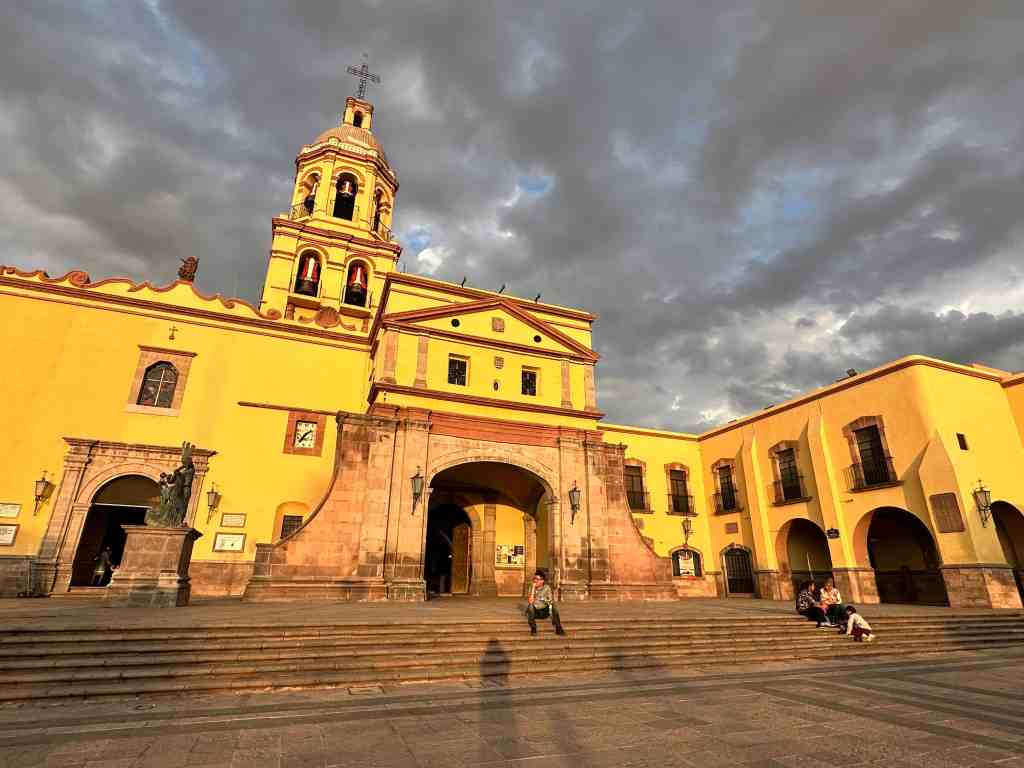
Templo de Santa Rosa de Viterbo
The Templo de Santa Rosa de Viterbo is a stunning baroque church located several blocks to the west of the city center. Built in the 18th century, it is considered one of the most impressive examples of baroque architecture in the country. The church was originally part of a convent and is named after Saint Rose of Viterbo, a 13th-century Italian saint known for her piety and miracles. This is where you can find the letters for the Querétaro city sign, which makes for an iconic photo for your stay in the city. It is about a 15 minute walk from the main center of the city, but very worth it.
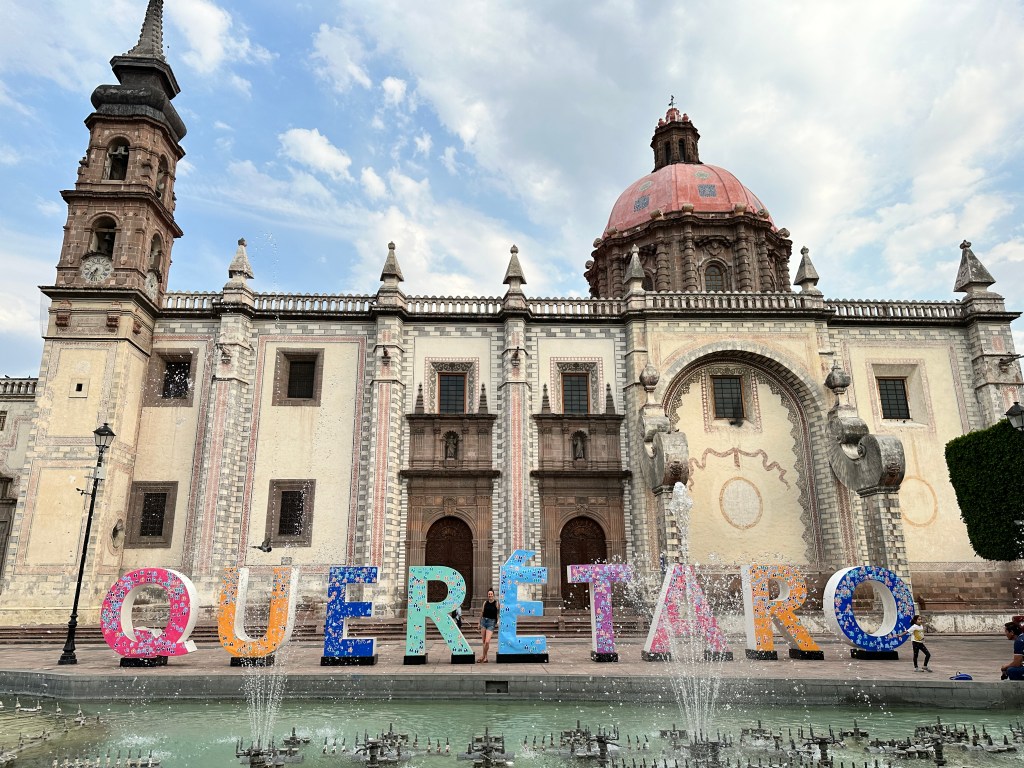
Where to stay in Querétaro
El mexa hostel.
El Mexa Hostel is right in the center of the city, and close to everything. Clean. Upstairs roof area. There are cooking facilities onsite that you can use. Downstairs can get a bit noisy, so if you want more privacy, get a double room upstairs.
Casa Santiago Hotel Boutique
Casa Santiago Hotel Boutique is very centrally located, clean, and modern. Breakfast is available for an additional charge. The hotel has a bar and a terrace, and of course free wifi, and private bathrooms in each room. There is also a small workout room. Prices range from $80-$165/night.
Markee Hotel Boutique
Markee Hotel Boutique is centrally located near the Zenea Garden. American style breakfast is included. Clean, modern design, inner courtyard. Several rooms have outside balconies. Free wifi, toiletries. This hotel is high quality with fair prices. Price ranges from $57-$90/night.
Querétaro FAQ
The city of Querétaro has 4 syllables: Keh – reh – ta – ro. Remember to add stress to any syllable that has an accent in Spanish. In this case, you would want to stress the “reh” (second syllable) sound: keh REH ta ro.
Querétaro is in central Mexico, about 2.5 hours north of Mexico City. The capital city of the state of Querétaro is officially Santiago de Querétaro, though most people just called it Querétaro. Querétaro is about 8.5 hours (672km’s) from Puerto Vallarta on the west coast, and 5.5 hours (472 km’s) from the east coast.
Querétaro is right in the center of Mexico, so it is definitely not known as a beach destination. Puerto Vallarta is the closest, most well-known beach on Mexico’s west coast, and it’s about a 8-9 hour drive. I don’t recommend Querétaro if you’re looking for a beach vacation.
Querétaro is known for its well-preserved colonial architecture, rich history, vibrant cultural scene, and as a major industrial and economic hub in Mexico. It’s also famous for its delicious local cuisine and wine production. There are several wine & cheese tours in the region. Querétaro is also known for its important role in Mexican history, including being the site where the country’s constitution was signed in 1917.
This really depends on how much time you have and how much you want to see. If you have a lot of energy, you could probably see the majority of the main tourist attractions in the centro in one day. Give yourself two days if you also want to visit museums. If you would like to see the city in a more relaxed manner, give yourself 4-5 days.
The main bus station in Querétaro lies about 15 minutes to the south of the city center, near the Estadio Correguidora. Buses leave from terminal B to other destinations within the state of Querétaro. Long distance buses come and go from terminal A and C. A more affordable and convenient option is to download the BlaBlaCar app and use ride shares.
Like any big city, there is a possibility of theft or danger. However, I never felt unsafe walking around Querétaro, both by day and night. The streets are usually quite busy and full, so you’re never alone.
QUERÉTARO FINAL THOUGHTS
Querétaro is a charming city that offers a fascinating glimpse into Mexico’s rich history and culture. From exploring its well-preserved colonial architecture and UNESCO World Heritage sites to indulging in local cuisine and drinks, there’s no shortage of things to see and do in this enchanting destination. Whether you’re a history buff, a foodie, or a nature lover, Querétaro has something to offer. I hope this Querétaro travel guide has inspired you to plan a visit to this beautiful city and experience all it has to offer. So what are you waiting for? Pack your bags and head to Querétaro to explore this hidden gem in the heart of Mexico! Don’t forget to share this blog post with your friends and family to inspire them to visit Querétaro too.
TRAVELING SOON? INSURANCE: Cover yourself with travel medical insurance by SafetyWing . FLIGHTS: Get the best flight deals with Skyscanner and set flight alerts with Hopper . STAYS : Check out hotels and apartments with Booking.com and Vrbo . RENTAL CARS: Get the best deal on rental cars with Discover Cars or RentalCars . GOING HIKING? Get a 30% discount off your yearly AllTrails+ Account (code: nickiposts30) eSIM : Get an international eSim with Airalo or eSim ple. CITY GUIDES : Save time and purchase pre-made city guides with Thatch . CITY TOURS : Book your tour with GetYourGuide and Viator LUGGAGE : Get the best carry-on suitcase here . CREDIT CARD: Start earning travel points with the best travel credit card . BUENOS AIRES GUIDE : Purchase my Buenos Aires travel companion here . CONSULTATION : Book a 1:1 travel consultation with Nicki here .
Discover more from
Subscribe now to keep reading and get access to the full archive.
Type your email…
Continue reading
You must be logged in to post a comment.
Explore Queretaro City

Plan Your Trip to Queretaro City: Best of Queretaro City Tourism
Discover the best of mexico with meliá.

Essential Queretaro City
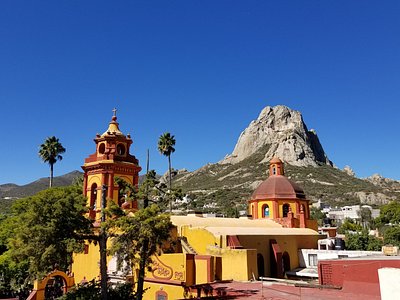
Trending in the forums
Queretaro City Is Great For
Archaeology tours.

Historical Tours

Shopaholics
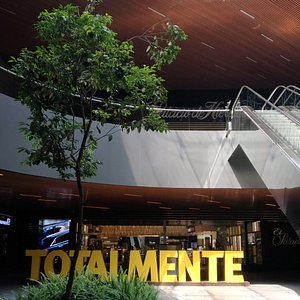
Eat & drink
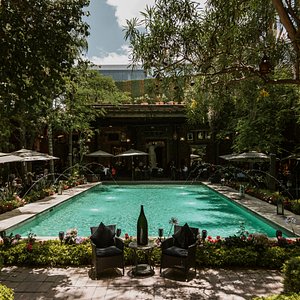
- La Casa del Atrio
- Hacienda Jurica by Brisas
- La Casa de la Marquesa
- Domun Hotel
- Grand Fiesta Americana Queretaro
- Hacienda Laborcilla
- Hacienda El Salitre
- Jardín de Cerveza Hércules
- 130 Grados Steakhouse Querétaro
- Tikua Sur Este
- La Pena de Bernal
- Historic Center of Santiago de Querétaro
- Reserva Sierra Gorda
- Santuario de la Virgen de Schoenstatt
- Museum of Arts of Queretaro
- Tour to the Tolantongo Caves in English, leaving Querétaro.
- Tour to the Sierra Gorda in One day in English, leaving Querétaro
- Tour to the Pyramids of Teotihuacán in English, leaving Querétaro
- Full Day Tour of 3 amazing magical towns of Queretaro.
- Tour to the Sierra Gorda Queretana in 1 day in Spanish, departing from Querétaro
Journey To Mexico
Your Travel Guide To Mexico
10 Best Things To Do In Querétaro, Mexico
Are you looking for the best things to do in Querétaro, Mexico?
Santiago de Querétaro, or known simply as Querétaro, is an exquisite example of a Spanish colonial city. Located in a small state in north-central Mexico that bears the same name, Querétaro’s well-preserved historic center was given a UNESCO World Heritage designation in 1996.
The city of Querétaro was established by Otomi Indians and became a part of the Aztec empire in 1446. This charming city is noted for its wealth of history, colonial architecture, and vibrant culture. Its historic center features colorful buildings and plazas, as well as excellent Baroque churches.
The city is also a foodie’s haven, with sumptuous traditional Mexican dishes you can sample, including like gorditas, carnitas, and barbacoa.
Natural beauty surrounds Querétaro that allows for a number of outdoor activities. Let’s check out the 10 best things to do in Querétaro, Mexico.
Things you'll find in this article
10 Best Things to Do in Querétaro, Mexico
1. start your tour of the city at its historic center, 2. visit the templo de santa rosa de viterbo, 3. check out the museo de la ciudad, 4. walk along the acueducto de querétaro (aqueduct of querétaro), 5. take in the views from the mirador de los arcos, 6. tour the convento de la cruz, 7. visit the casa de la zacatecana, 8. take a rest at the jardin zenea, 9. visit the cerro de las campanas, 10. explore the sierra gorda biosphere reserve.

The Historic Center of Querétaro is a UNESCO World Heritage site , featuring colorful Colonial-era buildings, picturesque plazas, Baroque churches, and a vibrant atmosphere.
You can take a simple walking tour at this historic center to see its landmarks, which include the Cathedral of Querétaro, the Aqueduct, and the Plaza de Armas.
Querétaro is also known for its lively cultural scene and various events that take place here throughout the year, including festivals, concerts, and art exhibits.
The historic center of Querétaro is a marvelous spot for immersing yourself in the city’s history and culture.

This stunning 18th-century Baroque church features an ornate interior and a bell tower and houses important relics and artworks. If you are an architecture enthusiast and/ or a history buff, this is a must-not-miss in Querétaro.
Learn about the church’s history, take a guided tour, or simply admire its architecture. The garden is also fantastic and open to the public so you can take a stroll and enjoy its peaceful atmosphere.
The Templo de Santa Rosa de Viterbo also houses a museum with religious artifacts and artwork as well as several exhibits showcasing the history of the building and the surrounding area.
Take your time soaking in the beauty and history of this unique site!

If you want to learn about the history and culture of Querétaro, the Museo de la Ciudad is a great place to go.
Here you should take your time exploring the exhibits and getting amazed by the beauty of the building and its surroundings.
If your schedule permits, you may also attend events, and appreciate the beauty of the building and its surroundings. The Museo de la Ciudad offers an interesting view of the history and culture of Querétaro.
It has exhibits on everything worth knowing from the city’s establishment to its role in Mexican independence.

The Acueducto de Querétaro (Aqueduct of Querétaro) is one of the city’s most iconic landmarks. Walking along it is a fun way to experience Querétaro’s history and architecture.
Walking along the Aqueduct of Querétaro will afford you to enjoy it up close. There are several spots along the aqueduct where you can stop and take pictures of the city, so don’t forget your phone or camera.
The 1,280-meter long aqueduct forms part of Querétaro’s historic center. It has 74 arches and an average height of 28.5 meters. To learn more about the history of the aqueduct and its surrounding area, it is best to take a guided tour. This will also help you to better appreciate the 18th-century aqueduct.
The best time to visit this historic site is at sunset, when the light is totally stunning.

The Mirador de los Arcos de Querétaro is a stone plaza that serves as a viewpoint that offers a breathtaking panoramic views of the city.
Apart from the stunning views, the plaza also houses a small museum where you can learn about the water canal system and all the monuments there.
This is a nice spot to take pictures of the old aqueduct and the city, best visited at dawn or at sunset.

The Convento de la Cruz is a former convent that now houses the Centro de las Artes de Querétaro, a cultural center where exhibitions, workshops, and performances are held.
The historic convent was built on top of an Aztec pyramid. Back in the day, the Convento de la Cruz served as a religious center for the area.
Made of pink stone, it features a combination of Renaissance and Baroque architectural styles, among others. Its interior is adorned with fascinating frescoes and murals. Here you can also view a nice collection of religious art and artifacts.

This elegant Colonial-era mansion now serves as a museum dedicated to the city of Querétaro’s art and culture.
Casa de la Zacatecana is located in the heart of the city. It was built in the 17th century and houses numerous period antiques and furnishings. The mansion is open to the public and offers guided tours where guests can learn about its history as well as its significance to the region.
Since Casa de la Zacatecana is in the historic center of Querétaro, there are many other historic landmarks and attractions in the vicinity of the mansion. Checking out this mansion cannot be missed when visiting Querétaro.

Jardin Zenea is a popular meeting place among locals, with plenty of benches, fountains, and greenery to take in. It is one of the must-see attractions in Querétaro.
This public park sits in the heart of the city and boasts gorgeous gardens, fountains, and statues. A quaint gazebo is situated in the middle of the park where concerts and other events frequently take place.
If you’re visiting with kids in tow, the park has a playground for them to play in. If you want to explore the park, you can ride the small train on a tour of the Jardin Zenea.

Cerro de las Campanas, or “Hill of the Bells” in English, is an important site in the history of Mexico as it was where the executions of famous historical figures such as Gen. Miguel Miramón, Gen. Tomás Mejíaz, and Emperor Maximilian I took place.
If you’re visiting Querétaro, Cerro de las Campanas must be in your itinerary. It is a fascinating site where you can have a unique perspective on the history of Querétaro and Mexico.

The Sierra Gorda Biosphere Reserve covers 33% of the state of Querétaro and is home to an incredible variety of flora and fauna.
Jaguars and pumas as well as black bears live here, although it is unfortunate that many of the other endemic species are threatened by illegal poaching.
They include the golf-ball cactus and the Querétaro yucca, which are nearing extinction. The vast reserve has plenty of natural springs of water. You can swin in streams and rivers as well as see lots of different trees, including apple, mango, guava, orange, fig, blackberry, and pecan.
The Sierra Gorda Biosphere Reserve is great for hiking – highly recommended for those visiting Querétaro, Mexico.
Hola! Que tal? I'm Christine, a Filipina but in love with Mexico. I used to live in Central America and Mexico is my favorite. Love tacos, tequila, and margarita.
Similar Posts

8 Best Things To Do In Durango, Mexico
Are you looking for the best things to do in Durango, Mexico? One of the most visited tourist destinations in Mexico is the state of Durango. People who have a thirst for excitement and a desire to participate in outdoor activities such as hiking, canoeing, and camping will find it to be the perfect spot…
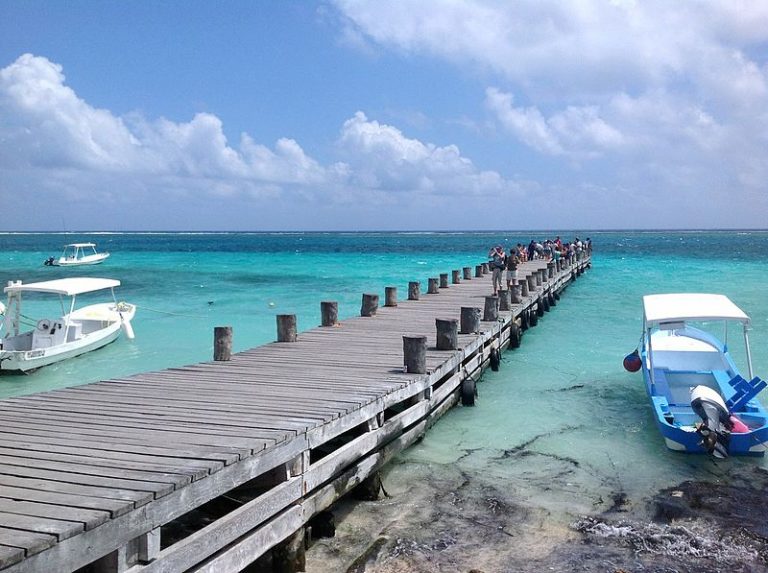
11 Exciting Things To Do In Puerto Morelos, Mexico
There are many things to do in Puerto Morelos. This small quiet town is still the classic “sleepy little fishing town” in many ways, even if it’s only 22 miles from Cancun. Puerto Morelos remains to be among the hidden gems on the Caribbean coast of the Yucatán Peninsula. Aside from its beaches and the…

11 Best Things To Do In Acapulco, Mexico
Are you looking for the best things to do in Acapulco? Tourism industry in Acapulco, once a hot spot for international jetsetters, began its decline in 2014 due to the upsurge in gang violence in the area. Foreign tourists became few in the succeeding years. However, this beautiful resort town in Mexico’s Pacific coast has…

11 Best Things To Do in Tulum, Mexico
There are several things to do in Tulum. Located on the Caribbean coastline of the Yucatan peninsula and the state of Quintana Roo, Tulum is now one of the most popular destinations in the area. It is known mostly for its pristine beaches, and the ruins of an ancient Mayan port city. READ READ: Best…

9 Best Things To Do In Valladolid, Mexico
Are you looking for the best things to do in Valladolid? Valladolid is the capital of the Yucatan state, which is one of the three states that make up the Yucatan Peninsula. It is located in the central part of the Yucatan, approximately 100 miles from Merida and Cancun, and is a popular tourist destination….

11 Best Things To Do In Playa Del Carmen, Mexico
Located by the coast of Mexico’s Yucatan peninsula and only an hour from Cancun, Playa del Carmen is more than just its pristine sandy beaches and sunny skies. There’s a wealth of activities you can enjoy here as well as interesting places to visit, including ‘secret ones’. READ MORE: Best Hotels In Playa Del Carmen,…
We’re sorry, this site is currently experiencing technical difficulties. Please try again in a few moments. Exception: request blocked
You can also search using these:
Discover Mexico A-Z

- News & Offers
- Mexico Guides
- Mexico Features
- Free eBooks
- Free Guides
Travel Experiences
Trip planning, travel destinations, destination highlights, mexico lifestyles, living & lifestyle, lifestyle planning, real estate, healthcare & wellbeing, leisure assistance, lifestyle assistance, insurance coverages, property assistance, about mexperience, mexico essentials, discover more, experience querétaro.
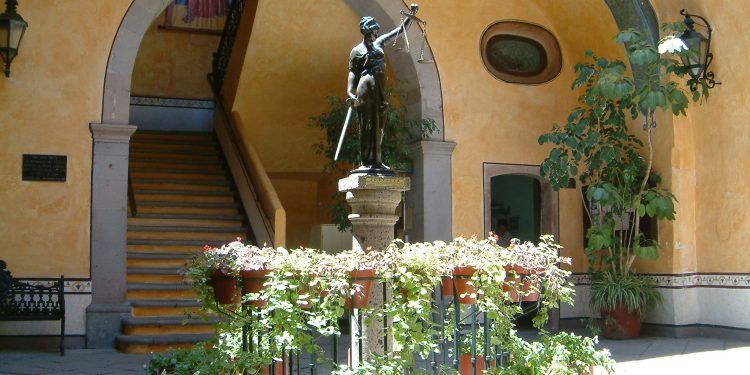
Discover Querétaro
Queretaro is one of a group of old Silver Mining cities which also includes San Miguel , Zacatecas , Guanajuato and San Luis Potosi .
These cities all lie north-west of Mexico City . Each has its own unique character, features and atmosphere—but together they make up some of Mexico’s best inland travel experiences. These cities are friendly places; the areas are not overwhelmed with tourists as some of the coastal areas can be.
It is in the colonial cities that the real Mexico begins to emerge. You’ll see real people living real lives; experience magnificent scenery; stay at wonderful colonial hotels that offer terrific value for money; savor local foods and flavors as colorful and diverse as the cultures that created them.
The road network in this region is well developed and traveling through it is fast and efficient in most places. These cities are safe: crime is low and its a great region to consider if you want to treat your family to a real cultural experience in Mexico.
Santiago de Queretaro, or just Queretaro as its known, is a colonial city steeped in Mexican history. The Spanish took control of the city in 1531 and designated it the “third city of New Spain”. It was here where the father’s of Mexico’s Independence Movement met in secret to discuss the overthrow of their Spanish rulers.
Installed by the French in 1864, Emperor Maximilian surrendered here three years later in 1867 after a 100 day siege. He was subsequently executed by firing squad, on an order handed down by Benito Juarez in San Luis Potosi .
The Mexican Constitution, written in 1917, was composed here— the same document that underscores the rule of law in Mexico today. Queretaro was also the birthplace of the Partido Revolucionario Institucional (PRI)—the political party that governed Mexico for 71 years, before Vicente Fox’s PAN ( Partido de Accion Nacional ) ousted the regime in July of 2000.
Queretaro itself is a bright, lively and very clean city. It’s just 130 miles north-west of Mexico City and is connected by high-speed modern highways (tolled).
The feel here is Baroque. Take time to browse its churches, its mansions with their graceful balconies, the myriad of tree-lined plazas and the quaint colonial side streets and alleyways. The local government in Queretaro strives to make the colonial city a pleasant place for people to live in and visit; and you will find that the historic colonial center is pristinely well kept and maintained.
This colonial city is one for walkers. Walk around the streets and discover little plazas leading off narrow alleys. At night, Queretaro lights up with a carefully orchestrated system of flood lighting, giving the whole place a wonderful look, feel and atmosphere.
Surrounding Queretaro are a series of beautiful small towns like Tequisquiapan and San Juan del Rio. This area is one of Mexico’s natural hot spring regions, which are a very popular attraction with locals and visitors alike. You’ll also find a good number of quality spas in this region, too.
Queretaro and its surrounding attractions are so close to Mexico City that it makes the destination an ideal one for visitors looking for a first stop on a colonial city tour starting from the country’s capital. Although day trips to Queretaro are easy from Mexico City, as well as other nearby colonial cities, it’s recommended that you spend at least one night here to have enough time time to experience Queretaro’s charm and elegance properly. Those who do, often stay longer, or come back for a longer stay later on.
Key Attractions
Colonial center.
Begin your exploration at one of the the town’s key plazas: Jardin Zenea. The bandstand dates back to the 1800’s and live music can be heard playing from it at weekends.
The main plaza is Plaza de la Independencia —central, and a very good place from which to explore the rest of city’s colonial charm.
For an excellent example of baroque architecture, visit the churches of Santa Clara and Santa Rosa de Viterbo , which you’ll find in the downtown colonial area of Queretaro.
Other places of historical and architectural interest include the Casa de La Corregidora , where Doña Josefa Ortiz de Dominguez lived (Heroine of War of Independence), La Casa de la Zacatecana , which is an excellent representation of the way that mansions looked and felt like during the colonial era, and the Cerro de Campanas (Hill of Bells), which is where Emperor Maximilian was executed after his capture here in 1867.
Queretaro also has a 1.3km Aqueduct (Acueducto) featuring 74 arches and is still used today as a means to transport water to the city.
Between Tuesday and Sunday, there is a tour that will take you around 21 of the most historical buildings and places of interest in Queretaro and explain the history behind them. The tour starts from the local Tourism Office – see Practical Information for details of where to find this.
Wine Production
In recent years, the state of Querétaro has become one of Mexico’s top wine-producing regions, and wine and cheese tours are one of the highlights of a visit to this area.
Hot Springs & Day Trips
Just 40 miles west of Querétaro is the beautiful little town of Tequisquiapan. You can buy great arts and Mexican crafts here, and it’s also famous for its hot springs. This whole area has volcanic springs situated under it, so warm pools of water are said to be therapeutic and able to relieve the symptoms of arthritis, gout and insomnia.
Also nearby is the growing town of San Juan del Rio, which boasts high quality textiles and Mexican craftwork, as well as hot springs, and colonial architecture dating back to the 16th centuries.
Museums and Art in Queretaro
The Museo Regional (Regional Museum) offers visitors a selection of artifacts from pre-Hispanic, colonial and and republican times.
The Museo de Arte (Art Museum) hosts some of the finest collections of Mexican colonial artwork in the country, all housed in the fabulous 18th century Baroque architecture of Ex-Covento de San Augustin.
Getting There & Around
By Air – Situated 8km northeast of the city center, Queretaro’s modern international airport has regular flights to and from Mexico City, Guadalajara and Monterrey. You can take a taxi or a city colectivo (the more economical option) to the city center. For detailed information about flights and flying, see the Mexperience guide to Air Travel in Mexico .
By Bus – You can travel to Queretaro on a luxury bus from Mexico City – the trip takes around 3 hours. You can get a bus directly from the Airport or from the Northern Bus Terminal in Mexico City. Buses run all day from Mexico City to Queretaro at least once an hour. For detailed information about bus transportation read the Mexperience guide to Bus Travel in Mexico .
By Car – Driving to Queretaro is very fast and efficient on the toll roads that connect the Capital to Queretaro. Take Highway 57D from Mexico City, Highway 57D (South) from San Luis Potosi, or Highway 111/57D from San Miguel de Allende. See additional information about Driving in Mexico and Mexico’s Toll Roads on Mexperience.
Car Rental – To explore Mexico’s colonial towns and cities, consider renting a car for your visit. Having your own car will give you more flexibility than using public transport options and, in some cases, offer you access to places which are otherwise difficult to visit without the use of a car. Read our guide to Car Rental in Mexico to learn what you need to know about car rental in Mexico and connect to the Mexperience Travel Center to reserve your Rental Car .
Taxis – Taxis in most of Mexico’s colonial towns and cities are not metered, so agree your price before you get in. Taxi travel is very affordable in Mexico, in comparison to the USA, Canada and Europe, and so provides a viable means of public transportation in Mexico. Your hotel can arrange taxis for you; some post their rates on a board in the lobby; taxi hotel rates are usually higher than cabs you hail off the street. If you speak Spanish , you will have a distinct advantage and be able to negotiate a price with the driver. For detailed information, read the Mexperience guide to Taxi Travel in Mexico .
Querétaro Essentials
Telephone: Connect to the guide about Communications in Mexico on Mexperience for detailed information about keeping in touch and the latest table of national dialing codes.
Exchanging Currency: Banks with ATM machines are found throughout the downtown area of Queretaro, especially around the main plaza. During business hours, they and the local Casas de Cambio will buy traveler’s cheques and cash from you as well. For detailed information about exchanging and managing your money, read the Mexperience guide to Money in Mexico .
Travel Insurance: We recommend that you are adequately covered with travel medical insurance and/or travel assistance insurance when you are visiting Mexico. Read the Mexperience guide to Travel Insurance in Mexico for full details and links to specialist insurance suppliers.
Internet Access: Internet cafes can be easily found in towns and cities across Mexico and WiFi is increasingly commonplace–from cafes, shops, hotels, and some cities even offer free WiFi in some defined public spaces.
What to Buy in Querétaro
Queretaro is well known for its sale of Opals—soft stones which have chameleon-like properties as they exhibit different colors and play games with the light they reflect. Queretaro still mines Opals for their local, national and international sale. Be sure to find a bargain for yourself here in Queretaro, where the stones are particularly good value for money.
Local Climate
Queretaro enjoys year-round hot, dry weather. The climate is ideal for taking part in a variety of outdoor sports and activities and for taking in the local culture, architecture and scenery. Rain is seldom a feature here; when they do come they tend to be during the months of April thru November. Rains tend to be fierce and brief in the late afternoon, leaving the evenings dry and cooled off.
Weather & Climates in Mexico
Learn more about the weather and climates through the seasons and regions by connecting to the Mexperience guide about Weather and Climates in Mexico
Mexico in your inbox
Our free newsletter about Mexico brings you a monthly round-up of recently published stories and opportunities, as well as gems from our archives.
Please SAVE the PDF for your personal use.
Download again
My File Downloaded - Close this box
Update April 12, 2024
Information for u.s. citizens in the middle east.
- Travel Advisories |
- Contact Us |
- MyTravelGov |
Find U.S. Embassies & Consulates
Travel.state.gov, congressional liaison, special issuance agency, u.s. passports, international travel, intercountry adoption, international parental child abduction, records and authentications, popular links, travel advisories, mytravelgov, stay connected, legal resources, legal information, info for u.s. law enforcement, replace or certify documents.
Before You Go
Learn About Your Destination
While Abroad
Emergencies
Share this page:
Travel Advisory August 22, 2023
Mexico - see state summaries.
Reissued after periodic review with general security updates, and the removal of obsolete COVID-19 page links.
Country Summary: Violent crime – such as homicide, kidnapping, carjacking, and robbery – is widespread and common in Mexico. The U.S. government has limited ability to provide emergency services to U.S. citizens in many areas of Mexico, as travel by U.S. government employees to certain areas is prohibited or restricted. In many states, local emergency services are limited outside the state capital or major cities.
U.S. citizens are advised to adhere to restrictions on U.S. government employee travel. State-specific restrictions are included in the individual state advisories below. U.S. government employees may not travel between cities after dark, may not hail taxis on the street, and must rely on dispatched vehicles, including app-based services like Uber, and regulated taxi stands. U.S. government employees should avoid traveling alone, especially in remote areas. U.S. government employees may not drive from the U.S.-Mexico border to or from the interior parts of Mexico, except daytime travel within Baja California and between Nogales and Hermosillo on Mexican Federal Highway 15D, and between Nuevo Laredo and Monterrey on Highway 85D.
Read the country information page for additional information on travel to Mexico.
Do Not Travel To:
- Colima state due to crime and kidnapping .
- Guerrero state due to crime .
- Michoacan state due to crime and kidnapping .
- Sinaloa state due to crime and kidnapping
- Tamaulipas state due to crime and kidnapping.
- Zacatecas state due to crime and kidnapping .
Reconsider Travel To:
- Baja California state due to crime and kidnapping .
- Chihuahua state due to crime and kidnapping .
- Durango state due to crime .
- Guanajuato state due to crime and kidnapping .
- Jalisco state due to crime and kidnapping .
- Morelos state due to crime .
- Sonora state due to crime and kidnapping .
Exercise Increased Caution When Traveling To:
- Aguascalientes state due to crime .
- Baja California Sur state due to crime .
- Chiapas state due to crime .
- Coahuila state due to crime .
- Hidalgo state due to crime .
- Mexico City due to crime .
- Mexico State due to crime .
- Nayarit state due to crime.
- Nuevo Leon state due to crime and kidnapping .
- Oaxaca state due to crime .
- Puebla state due to crime and kidnapping .
- Queretaro state due to crime .
- Quintana Roo state due to crime .
- San Luis Potosi state due to crime and kidnapping .
- Tabasco state due to crime .
- Tlaxcala state due to crime .
- Veracruz state due to crime .
Exercise Normal Precautions When Traveling To:
- Campeche state
- Yucatan state
Visit our website for Travel to High-Risk Areas .
If you decide to travel to Mexico:
- Keep traveling companions and family back home informed of your travel plans. If separating from your travel group, send a friend your GPS location. If taking a taxi alone, take a photo of the taxi number and/or license plate and text it to a friend.
- Use toll roads when possible and avoid driving alone or at night. In many states, police presence and emergency services are extremely limited outside the state capital or major cities.
- Exercise increased caution when visiting local bars, nightclubs, and casinos.
- Do not display signs of wealth, such as wearing expensive watches or jewelry.
- Be extra vigilant when visiting banks or ATMs.
- Enroll in the Smart Traveler Enrollment Program (STEP) to receive Alerts and make it easier to locate you in an emergency.
- Follow the Department of State on Facebook and Twitter .
- Follow the U.S. Embassy on Facebook and Twitter .
- Review the Country Security Report for Mexico.
- Mariners planning travel to Mexico should check for U.S. maritime advisories and alerts , which include instructions on reporting suspicious activities and attacks to Mexican naval authorities.
- Prepare a contingency plan for emergency situations. Review the Traveler’s Checklist .
- Visit the CDC page for the latest travel health information related to your travel.
Aguascalientes state – Exercise Increased Caution
Exercise increased caution due to crime.
Criminal activity and violence may occur throughout the state.
There are no restrictions on travel for U.S. government employees in Aguascalientes state.
Baja California state – Reconsider Travel
Reconsider travel due to crime and kidnapping.
Transnational criminal organizations compete in the border area to establish narco-trafficking and human smuggling routes. Violent crime and gang activity are common. Travelers should remain on main highways and avoid remote locations. Of particular concern is the high number of homicides in the non-tourist areas of Tijuana. Most homicides appeared to be targeted; however, criminal organization assassinations and territorial disputes can result in bystanders being injured or killed. U.S. citizens and LPRs have been victims of kidnapping.
U.S. government employees must adhere to the noted restrictions:
- Mexicali Valley: U.S. government employees should avoid the Mexicali Valley due to the heightened possibility of violence between rival cartel factions. The boundaries of the restricted area are: to the east, the Baja California/Arizona and Baja California/Sonora borders; to the south, from La Ventana (on Highway 5) due east to the Colorado River; to the west, Highway 5; and to the north, Boulevard Lazaro Cardenas/Highway 92/Highway 1 to Carretera Aeropuerto, from the intersection of Highway 1 and Carretera Aeropuerto due north to the Baja California/California border, and from that point eastward along the Baja California/California border.
- Travelers may use Highways 2 and 2D to transit between Mexicali, Los Algodones, and San Luis Rio Colorado during daylight hours. Travelers may also use Highways 1 and 8 to transit to and from the Mexicali Airport during daylight hours. Travel on Highway 5 is permissible during daylight hours.
There are no other travel restrictions for U.S. government employees in Baja California state. These include high-traffic tourism areas of border and coastal communities, such as Tijuana , Ensenada , and Rosarito .
Baja California Sur state – Exercise Increased Caution
There are no restrictions on travel for U.S. government employees in Baja California Sur state.
Campeche state – Exercise Normal Precautions
Exercise normal precautions.
There are no restrictions on travel for U.S. government employees in Campeche state.
Chiapas state – Exercise Increased Caution
There are no restrictions on travel for U.S. government employees in Chiapas state.
Chihuahua state – Reconsider Travel
Violent crime and gang activity are common. Most homicides are targeted assassinations against members of criminal organizations. Battles for territory between criminal groups have resulted in violent crime in areas frequented by U.S. citizens and U.S. government employees, including restaurants and malls during daylight hours. Bystanders have been injured or killed in shooting incidents. U.S. citizens and LPRs have been victims of kidnapping.
U.S. government employee travel is limited to the following areas with the noted restrictions:
- Ciudad Juarez: U.S. government employees may travel to the area of Ciudad Juarez bounded to the east by Bulevar Independencia; to the south by De los Montes Urales/Avenida Manuel J Clouthier/Carretera de Juárez; to the west by Via Juan Gabriel/Avenida de los Insurgentes/Calle Miguel Ahumada/Francisco Javier Mina/Melchor Ocampo; and to the north by the U.S.-Mexico border. Direct travel to the Ciudad Juarez airport (officially called the Abraham González International Airport) and the factories located along Bulevar Independencia and Las Torres is permitted. Travel to San Jerónimo is permitted only through the United States via the Santa Teresa U.S. Port of Entry; travel via Anapra is prohibited.
U.S. government employees may only travel from Ciudad Juarez to the city of Chihuahua during daylight hours via Federal Highway 45, with stops permitted only at the Guardia Nacional División Caminos station, the Umbral del Milenio overlook area, the border inspection station at KM 35, and the shops and restaurants on Federal Highway 45 in the city of Ahumada.
- U.S. government employees may travel between Ciudad Juarez and Ascension via Highway 2.
- Nuevo Casas Grandes Area (including Nuevo Casas Grandes, Casas Grandes, Mata Ortiz, Colonia Juárez, Colonia LeBaron, Paquimé and San Buenaventura): U.S. government employees may travel to the Nuevo Casas Grandes area during daylight hours via Mexico Federal Highway 2, and subsequently Federal Highway 10, to Nuevo Casas Grandes. Employees are permitted to stay overnight in the cities of Nuevo Casas Grandes and Casas Grandes only.
- City of Chihuahua: U.S. government employees may travel at any time to the area of the city of Chihuahua bounded to the north by Avenida Transformación; to the east by Avenida Tecnológico/Manuel Gómez Morín/Highway 16/Blvd.José Fuentes Mares; to the west by the city boundary; and to the south by Periférico Francisco R. Almada.
- U.S. government employees may travel on Highways 45, 16, and 45D through the city of Chihuahua and to the Chihuahua airport (officially called the General Roberto Fierro Villalobos International Airport).
- U.S. government employees may travel to Santa Eulalia to the east of the city of Chihuahua, as well as to Juan Aldama via Highway 16 to the northeast.
- U.S. government employees may travel south of the city of Chihuahua on Highway 45 to the southern boundary of Parral, including each town directly connected to Highway 45, including Lázaro Cárdenas, Pedro Meoqui, Santa Cruz de Rosales, Delicias, Camargo, Ciudad Jiménez, and Parral itself.
- U.S. government employees may only travel on official business from the city of Chihuahua on Highway 16 to Ciudad Cuauhtémoc bounded by Highway 21 to the north and east, Highway 5 to the west, and Bulevar Jorge Castillo Cabrera to the south.
- Ojinaga: U.S. government employees must travel to Ojinaga via U.S. Highway 67 and enter through the U.S. Port of Entry in Presidio, Texas.
- Palomas: U.S. government employees may travel to Palomas via U.S. highways through the U.S. Port of Entry in Columbus, New Mexico, or via Highway 2 in Mexico.
U.S. government employees may not travel to other areas of Chihuahua, including Copper Canyon .
Coahuila state – Exercise Increased Caution
Violent crime and gang activity occur in parts of Coahuila state.
U.S. government employees must adhere to the following travel restrictions:
- Zaragoza, Morelos, Allende, Nava, Jimenez, Villa Union, Guerrero, and Hidalgo municipalities : U.S. government employees may not travel to these municipalities.
- Piedras Negras and Ciudad Acuña: U.S. government employees must travel directly from the United States and observe a curfew from midnight to 6:00 a.m. in both cities.
There are no other restrictions on travel for U.S. government employees in Coahuila state.
Colima state – Do Not Travel
Do not travel due to crime and kidnapping.
Violent crime and gang activity are widespread. Most homicides are targeted assassinations against members of criminal organizations. Shooting incidents between criminal groups have injured or killed bystanders. U.S. citizens and LPRs have been victims of kidnapping.
Travel for U.S. government employees is limited to the following areas with noted restrictions:
- Manzanillo: U.S. government employee travel is limited to the tourist and port areas of Manzanillo.
- Employees traveling to Manzanillo from Guadalajara must use Federal Toll Road 54D during daylight hours.
U.S. government employees may not travel to other areas of Colima state.
Durango state – Reconsider Travel
Reconsider travel due to crime.
Violent crime and gang activity are common in parts of Durango state.
- West and south of Federal Highway 45: U.S. government employees may not travel to this region of Durango state.
There are no other restrictions on travel for U.S. government employees in Durango state.
Guanajuato state – Reconsider Travel
Gang violence, often associated with the theft of petroleum and natural gas from the state oil company and other suppliers, occurs in Guanajuato, primarily in the south and central areas of the state. Of particular concern is the high number of murders in the southern region of the state associated with cartel-related violence. U.S. citizens and LPRs have been victims of kidnapping.
- Areas south of Federal Highway 45D: U.S. government employees may not travel to the area south of and including Federal Highway 45D, Celaya, Salamanca, and Irapuato.
There are no other restrictions on travel for U.S. government employees in Guanajuato state, which includes tourist areas in: San Miguel de Allende , Guanajuato City , and surrounding areas.
Guerrero state – Do Not Travel
Do not travel due to crime.
Crime and violence are widespread. Armed groups operate independently of the government in many areas of Guerrero. Members of these groups frequently maintain roadblocks and may use violence towards travelers. U.S. citizens and LPRs have been victims of kidnapping in previous years.
Travel for U.S. government employees is limited to the following area with the noted restrictions:
- Taxco: U.S. government employees must use Federal Highway 95D, which passes through Cuernavaca, Morelos, and stay within downtown tourist areas of Taxco. Employees may visit Grutas de Cacahuamilpa National Park during the day with a licensed tour operator.
U.S. government employees may not travel to other areas of the state of Guerrero, including to tourist areas in Acapulco , Zihuatanejo , and Ixtapa .
Hidalgo state – Exercise Increased Caution
There are no restrictions on travel for U.S. government employees in Hidalgo state.
Jalisco state – Reconsider Travel
Violent crime and gang activity are common in parts of Jalisco state. In Guadalajara, territorial battles between criminal groups take place in tourist areas. Shooting incidents between criminal groups have injured or killed innocent bystanders. U.S. citizens and LPRs have been victims of kidnapping.
- Jalisco-Michoacan border and Federal Highway 110: U.S. government employees may not travel to the area between Federal Highway 110 and the Jalisco-Michoacan border, nor travel on Federal Highway 110 between Tuxpan, Jalisco, and the Michoacan border.
- Federal Highway 80: U.S. government employees may not travel on Federal Highway 80 south of Cocula.
There are no other restrictions on travel for U.S government employees in Jalisco state which includes tourist areas in: Guadalajara Metropolitan Area , Puerto Vallarta (including neighboring Riviera Nayarit) , Chapala , and Ajijic .
Mexico City (Ciudad de Mexico) – Exercise Increased Caution
Both violent and non-violent crime occur throughout Mexico City. Use additional caution, particularly at night, outside of the frequented tourist areas where police and security patrol more routinely. Petty crime occurs frequently in both tourist and non-tourist areas.
There are no restrictions on travel for U.S. government employees in Mexico City.
Mexico State (Estado de Mexico) – Exercise Increased Caution
Both violent and non-violent crime occur throughout Mexico State. Use additional caution in areas outside of the frequented tourist areas, although petty crime occurs frequently in tourist areas as well.
There are no restrictions on travel for U.S. government employees in Mexico State.
Michoacan state – Do Not Travel
Do not travel due to crime and kidnapping.
Crime and violence are widespread in Michoacan state. U.S. citizens and LPRs have been victims of kidnapping.
Travel for U.S. government employees is limited to the following areas with the noted restrictions:
- Federal Highway 15D: U.S. government employees may travel on Federal Highway 15D to transit the state between Mexico City and Guadalajara.
- Morelia: U.S. government employees may travel by air and by land using Federal Highways 43 or 48D from Federal Highway 15D.
- Lazaro Cardenas: U.S. government employees must travel by air only and limit activities to the city center or port areas.
U.S. government employees may not travel to other areas of the state of Michoacan, including the portions of the Monarch Butterfly Reserve located in Michoacan.
Morelos state – Reconsider Travel
Violent crime and gang activity are common in parts of Morelos state.
There are no restrictions on travel for U.S. government employees in Morelos state.
Nayarit state – Exercise Increased Caution
Criminal activity and violence may occur throughout Nayarit state.
There are no restrictions on travel for U.S government employees in Nayarit state.
Nuevo Leon state – Exercise Increased Caution
Exercise increased caution due to crime and kidnapping.
Criminal activity and violence may occur throughout the state. U.S. citizens and LPRs have been victims of kidnapping.
There are no restrictions on travel for U.S. government employees in Nuevo Leon state.
Oaxaca state – Exercise Increased Caution
Criminal activity and violence occur throughout the state.
U.S. travelers are reminded that U.S. government employees must adhere to the following travel restrictions:
- Isthmus region: U.S. government employees may not travel to the area of Oaxaca bounded by Federal Highway 185D to the west, Federal Highway 190 to the north, and the Oaxaca-Chiapas border to the east. This includes the cities of Juchitan de Zaragoza, Salina Cruz, and San Blas Atempa.
- Federal Highway 200 northwest of Pinotepa: U.S. government employees may not use Federal Highway 200 between Pinotepa and the Oaxaca-Guerrero border.
There are no restrictions on travel for U.S. government employees to other parts of Oaxaca state, which include tourist areas in: Oaxaca City , Monte Alban , Puerto Escondido, and Huatulco .
Puebla state – Exercise Increased Caution
There are no restrictions on travel for U.S. government employees in Puebla state.
Queretaro state – Exercise Increased Caution
There are no restrictions on travel for U.S. government employees in Queretaro state.
Quintana Roo state – Exercise Increased Caution
Criminal activity and violence may occur in any location, at any time, including in popular tourist destinations. Travelers should maintain a high level of situational awareness, avoid areas where illicit activities occur, and promptly depart from potentially dangerous situations.
While not directed at tourists, shootings between rival gangs have injured innocent bystanders. Additionally, U.S. citizens have been the victims of both non-violent and violent crimes in tourist and non-tourist areas.
There are no restrictions on travel for U.S. government employees in Quintana Roo state. However, personnel are advised to exercise increased situational awareness after dark in downtown areas of Cancun, Tulum, and Playa del Carmen, and to remain in well-lit pedestrian streets and tourist zones.
San Luis Potosi state – Exercise Increased Caution
Criminal activity and violence may occur throughout the state. U.S. citizens and LPRs have been victims of kidnapping.
There are no restrictions on travel for U.S. government employees in San Luis Potosi state.
Sinaloa state – Do Not Travel
Violent crime is widespread. Criminal organizations are based in and operating in Sinaloa. U.S. citizens and LPRs have been victims of kidnapping.
- Mazatlan: U.S. government employees may travel to Mazatlan by air or sea only, are limited to the Zona Dorada and historic town center, and must travel via direct routes between these destinations and the airport and sea terminal.
- Los Mochis and Topolobampo: U.S. government employees may travel to Los Mochis and Topolobampo by air or sea only, are restricted to the city and the port, and must travel via direct routes between these destinations and the airport.
U.S. government employees may not travel to other areas of Sinaloa state.
Sonora state – Reconsider Travel
Sonora is a key location used by the international drug trade and human trafficking networks. Violent crime is widespread. U.S. citizens and LPRs have been victims of kidnapping. Travelers should maintain a heightened level of awareness of their surroundings in all their travels in Sonora. Security incidents may occur in any area of Sonora.
- Travel between Hermosillo and Nogales: U.S. government employees may travel between the U.S. Ports of Entry in Nogales and Hermosillo during daylight hours via Federal Highway 15 only. U.S. government employees may not use ANY taxi services, public buses, nor ride-share applications due to a lack of secure vetting and/or dispatching procedures. Travelers should exercise caution and avoid unnecessary stops as security incidents, including sporadic, armed carjackings, and shootings have been reported along this highway during daylight hours. Travelers should have a full tank of gas and inform friends or family members of their planned travel.
- Nogales: U.S. government employees may not travel in the triangular area north of Avenida Tecnologico, west of Bulevar Luis Donaldo Colosio (Periferico), nor east of Federal Highway 15D (Corredor Fiscal). U.S. government employees also may not travel in the residential and business areas to east of the railroad tracks along Plutarco Elias Calle (HWY 15) and Calle Ruiz Cortino, including the business area around the Morley pedestrian gate port-of-entry. U.S. government employees may not use ANY taxi services, public buses, nor ride-share applications in Nogales due to a lack of secure vetting and/or dispatching procedures and the danger of kidnapping and other violent crimes.
- Puerto Peñasco: U.S. government employees may travel between Puerto Peñasco and the Lukeville-Sonoyta U.S. Port of Entry during daylight hours via Federal Highway 8 only. They may not travel on any other route to Puerto Peñasco. U.S. government employees may not use ANY taxi services, public buses, nor ride-share applications in Puerto Peñasco. due to a lack of secure vetting and/or dispatching procedures and the danger of kidnapping and other violent crimes.
- Triangular region near Mariposa U.S. Port of Entry: U.S. government employees may not travel into or through the triangular region west of the Mariposa U.S. Port of Entry, east of Sonoyta, and north of Altar municipality.
- San Luis Rio Colorado, Cananea, and Agua Prieta : U.S. government employees may travel directly from the nearest U.S. Port of Entry to San Luis Rio Colorado, Cananea (via Douglas Port of Entry), and Agua Prieta, but may not go beyond the city limits. Travel is limited to daylight hours only. Travel between Nogales and Cananea via Imuris is not permitted. U.S. government employees may not use ANY taxi services, public buses, nor ride-share applications in these cities due to a lack of secure vetting and/or dispatching procedures and the danger of kidnapping and other violent crimes.
- Eastern and southern Sonora (including San Carlos Nuevo Guaymas and Alamos): U.S. government employees may not travel to areas of Sonora east of Federal Highway 17, the road between Moctezuma and Sahuaripa, and State Highway 20 between Sahuaripa and the intersection with Federal Highway 16. U.S. government employees may travel to San Carlos Nuevo Guaymas and Alamos; travel to Alamos is only permitted by air and within city limits. U.S. government employees may not travel to areas of Sonora south of Federal Highway 16 and east of Federal Highway 15 (south of Hermosillo), as well as all points south of Guaymas, including Empalme, Guaymas, Obregon, and Navojoa. U.S. government employees may not use ANY taxi services, public buses, nor ride-share applications in these areas due to a lack of secure vetting and/or dispatching procedures and the danger of kidnapping and other violent crimes.
U.S. government employees may travel to other parts of Sonora state in compliance with the above restrictions, including tourist areas in: Hermosillo , Bahia de Kino , and Puerto Penasco .
Tabasco state – Exercise Increased Caution
There are no restrictions on travel for U.S. government employees in Tabasco state.
Tamaulipas state – Do Not Travel
Organized crime activity – including gun battles, murder, armed robbery, carjacking, kidnapping, forced disappearances, extortion, and sexual assault – is common along the northern border and in Ciudad Victoria. Criminal groups target public and private passenger buses, as well as private automobiles traveling through Tamaulipas, often taking passengers and demanding ransom payments.
Heavily armed members of criminal groups often patrol areas of the state and operate with impunity particularly along the border region from Reynosa to Nuevo Laredo. In these areas, local law enforcement has limited capacity to respond to incidents of crime. Law enforcement capacity is greater in the tri-city area of Tampico, Ciudad Madero, and Altamira, which has a lower rate of violent criminal activity compared to the rest of the state.
U.S. citizens and LPRs have been victims of kidnapping.
- Matamoros and Nuevo Laredo: U.S. government employees may only travel within a limited radius around and between the U.S. Consulates in Nuevo Laredo and Matamoros, their homes, the respective U.S. Ports of Entry, and limited downtown sites, subject to an overnight curfew.
- Overland travel in Tamaulipas: U.S. government employees may not travel between cities in Tamaulipas using interior Mexican highways. Travel between Nuevo Laredo and Monterrey is limited to Federal Highway 85D during daylight hours with prior authorization.
U.S. government employees may not travel to other parts of Tamaulipas state.
Tlaxcala state – Exercise Increased Caution
There are no restrictions on travel for U.S. government employees in Tlaxcala state.
Veracruz state – Exercise Increased Caution
Violent crime and gang activity occur with increasing frequency in Veracruz, particularly in the center and south near Cordoba and Coatzacoalcos. While most gang-related violence is targeted, violence perpetrated by criminal organizations can affect bystanders. Impromptu roadblocks requiring payment to pass are common.
There are no restrictions on travel for U.S. government employees in Veracruz state.
Yucatan state – Exercise Normal Precautions
There are no restrictions on travel for U.S. government employees in Yucatan state, which include tourist areas in: Chichen Itza , Merida , Uxmal , and Valladolid .
Zacatecas state – Do Not Travel
Violent crime, extortion, and gang activity are widespread in Zacatecas state. U.S. citizens and LPRs have been victims of kidnapping.
- Zacatecas City : U.S. government employee travel is limited to Zacatecas City proper, and employees may not travel overland to Zacatecas City.
- U.S. government employees may not travel to other areas of Zacatecas state.
Embassy Messages
View Alerts and Messages Archive
Quick Facts
Passport must be valid at time of entry
One page per stamp
Yes, if visiting for more than 180 days
See Travelers’ Health section
Embassies and Consulates
EMERGENCY ASSISTANCE FOR U.S. CITIZENS IN MEXICO From Mexico: 800-681-9374 or 55-8526-2561 From the United States: 1-844-528-6611
U.S. Citizen Services Inquiries: Contact Form
U.S. Embassy Mexico City
Paseo de la Reforma 305 Colonia Cuauhtémoc 06500 Ciudad de México
U.S. Consulate General Ciudad Juarez
Paseo de la Victoria #3650 Fracc. Partido Senecú 32543 Ciudad Juárez, Chihuahua
U.S. Consulate General Guadalajara
Progreso 175 Colonia Americana 44160 Guadalajara, Jalisco
U.S. Consulate General Hermosillo
Monterey, Esqueda 141 El Centenario 83260 Hermosillo, Sonora
U.S. Consulate General Matamoros
Constitución No. 1 Colonia Jardín 87330 Matamoros, Tamaulipas
U.S. Consulate General Merida
Calle 60 No. 338-K x 29 y 31 Colonia Alcalá Martin 97050 Mérida, Yucatán
U.S. Consulate General Monterrey
Avenida Alfonso Reyes 150 Colonia Valle del Poniente 66196 Santa Catarina, Nuevo León
U.S. Consulate General Nogales
Calle San José s/n Fracc. Los Álamos 84065 Nogales, Sonora
U.S. Consulate General Nuevo Laredo
Paseo Colon 1901 Colonia Madero 88260 Nuevo Laredo, Tamaulipas
U.S. Consulate General Tijuana
Paseo de las Culturas s/n Mesa de Otay Delegación Centenario 22425 Tijuana, Baja California
Consular Agencies
Acapulco Hotel Continental Emporio Costera M. Alemán 121 – Office 14 39670 Acapulco, Guerrero Cancun
Blvd. Kukulcan Km 13 ZH Torre La Europea, Despacho 301 77500 Cancún, Quintana Roo
Los Cabos Las Tiendas de Palmilla L-B221, Km. 27.5 Carretera Transpeninsular 23406 San José del Cabo, Baja California Sur
Playa Gaviotas 202, Local 10 Zona Dorada 82110 Mazatlán, Sinaloa
Oaxaca Macedonio Alcalá 407, Office 20 68000 Oaxaca, Oaxaca
Piedras Negras Abasolo 211, Local 3, Centro 26000 Piedras Negras, Coahuila
Playa del Carmen Plaza Progreso, Local 33 Carretera Federal Puerto Juarez-Chetumal, Mz. 293 Lt. 1. 77710 Playa del Carmen, Quintana Roo
Puerto Vallarta
Paradise Plaza, Paseo de los Cocoteros 85 Sur, Local L-7 63732 Nuevo Nayarit, Nayarit
San Miguel de Allende Plaza La Luciérnaga, Libramiento Jose Manuel Zavala 165, Locales 4 y 5 Colonia La Luciérnaga 37745 San Miguel de Allende, Guanajuato
Destination Description
See the State Department’s Fact Sheet on Mexico for more information on U.S.-Mexico relations.
Entry, Exit and Visa Requirements
A valid passport book is required to enter Mexico by air, and those attempting to enter at an airport with a U.S. passport card only may be denied admission.
Review the Mexican government’s most current entry, exit, and visa requirements ( Spanish only ) or visit the Embassy of Mexico in Washington, D.C., for more information.
For travelers entering Mexico by air only, Mexican immigration authorities implemented a process to replace the previous paper Forma Migratoria Multiple or FMM with a Forma Migratoria Multiple Digital or FMMD. The FMMD process is in place at all 66 international airports in Mexico. Upon arrival at an airport, Mexican immigration authorities will determine a traveler’s authorized length of stay and either place a date stamp in the traveler’s passport or direct the traveler through a self-service electronic gate (E-Gate) that will generate a printed receipt with QR code. Air travelers who wish to download a record of their FMMD or find more information on the FMMD process may visit the National Migration Institute’s (INM) website .
Travelers entering Mexico by land should have a valid passport book or card. If you enter Mexico by land and plan to travel beyond the immediate border area (approximately 12 miles or 20 kilometers into Mexico), you must stop at an INM office to obtain an entry permit (Forma Migratoria Multiple or FMM), even if not explicitly directed to do so by Mexican officials. INM may opt to allow tourists entry of up to 180 days without a visa or may limit authorized stays to shorter periods at their discretion; visitors should confirm the specific length of authorized stay written on the entry permit (FMM) or by the stamp in their passport. Mexican immigration authorities could ask you to present both your passport and entry permit if applicable at any point and may detain you while they review your immigration status if you are not carrying your passport and proof of legal status in Mexico, or if you have overstayed your authorized stay. Immigration check points are common in the interior of Mexico, including in popular tourist areas far from the border.
You will also need a temporary vehicle import permit to bring a U.S.-registered vehicle beyond the border zone. These permits are processed through Banjercito and require a deposit that will be refunded once the vehicle leaves Mexico. For more information, visit the Banjercito website ( Spanish only ).
Baja California, Baja California Sur, and Sonora have a “hassle-free” zone that allows cars traveling without an entry permit or car registration within the zone.
Mexican authorities can impound a vehicle that enters the country without a valid U.S. registration, a vehicle driven by a Mexican national who is not resident in the United States, or a vehicle found beyond the border zone without the temporary import permit.
Mexican law permits Mexican immigration authorities to deny foreigners entry into Mexico if they have been charged with or convicted of a serious crime in Mexico or elsewhere.
Travelers bringing in goods beyond their personal effects worth $300.00 or more must declare those goods with Mexican customs (SAT) Mexican customs ( Spanish only ) or risk having them confiscated. This also applies to used goods or clothing, including items for donation. U.S. citizens driving such items into Mexico without declaring them or without sufficient funds to pay duty fees are subject to having their vehicle seized by Mexican customs authorities. For further information about customs regulations, please read our customs information page .
The U.S. Department of State is unaware of any HIV/AIDS entry restrictions for visitors to or foreign residents in Mexico.
A parent or legal guardian departing Mexico with minor children should carry a notarized consent letter from the other parent if traveling separately. INM requires at least one parent to complete a SAM ( Formato de Salida de Menores, Spanish only ) for all Mexican or foreign minors with Temporary Resident, Temporary Student Resident, or Permanent Resident status departing Mexico alone or with a third party. Further information about the prevention of international parental child abduction is available on our website.
Find information on dual nationality , and customs regulations on our websites. Both Mexico and the United States allow dual nationality.
Safety and Security
Travelers are urged to review the Mexico Travel Advisory for information about safety and security concerns affecting the country on a state-by-state basis.
U.S. citizens traveling to and residing in Mexico should not expect public health and safety standards like those in the United States. Even where such standards exist, enforcement varies by location. Travelers should mitigate the risk of illness or injury by taking standard health and safety precautions.
The phone number to report emergencies in Mexico is “911.” Although there may be English-speaking operators available, it is best to seek the assistance of a Spanish speaker to place the call.
Crime: Crime in Mexico occurs at a high rate and can be violent, from random street crime to cartel-related attacks. Over the past year, Mission Mexico has assisted U.S. citizens who were victims of armed robbery, carjacking, extortion, homicide, kidnapping, pick-pocketing, and sexual assault. Increased levels of cartel-related violence have resulted in territorial disputes and targeted killings, injuring or killing innocent bystanders. Travelers who find themselves in an active shooter scenario should flee in the opposite direction, if possible, or drop to the ground, preferably behind a hard barrier.
Drivers on roads and highways may encounter government checkpoints, which often include National Guard or military personnel. State and local police also set up checkpoints in and around cities and along the highways to deter criminal activity and enforce traffic laws. In some parts of Mexico, criminal organizations and other non-governmental actors have been known to erect unauthorized checkpoints and have abducted or threatened violence against those who fail to stop and/or pay a “toll.” When approaching a checkpoint, regardless of whether it is official, cooperate and avoid any actions that may appear suspicious or aggressive.
While Mexican authorities endeavor to safeguard the country’s major resort areas and tourist destinations, those areas have not been immune to the types of violence and crime experienced elsewhere in Mexico. In some areas of Mexico, response time of local police is often slow. In addition, filing police reports can be time consuming. See our Mexico Travel Advisory for more information.
Demonstrations occur frequently. They may take place in response to political or economic issues, on politically significant holidays, and during international events. Protesters in Mexico may block traffic on roads, including major thoroughfares, or take control of toll booths on highways. Travelers who encounter protesters who demand unofficial tolls are generally allowed to pass upon payment. U.S. citizens should avoid participating in demonstrations or other activities that might be deemed political by authorities, as Mexican law prohibits political activities by foreign citizens and such actions may result in detention or deportation.
- Demonstrations can be unpredictable, avoid areas around protests and demonstrations.
- Past demonstrations have turned violent.
- Check local media for updates and traffic advisories.
International Financial Scams: See the Department of State and the FBI pages for information.
Internet romance and financial scams are prevalent in Mexico. Scams are often initiated through Internet postings/profiles or by unsolicited emails and letters. Scammers almost always pose as U.S. citizens who have no one else to turn to for help. Common scams include:
- Romance/Online dating
- Money transfers
- Lucrative sales
- Grandparent/Relative targeting
- Free Trip/Luggage
- Inheritance notices
- Bank overpayments
Mexico’s consumer protection agency, PROFECO (Procuraduría Federal del Consumidor, Spanish only), can sometimes provide assistance (Spanish only) to victims of such scams. In addition, there have been allegations of banking fraud perpetrated by private bankers against U.S. citizens. U.S. citizens who believe they have been victims of fraud can file a police report file a complaint (Spanish only) with the Mexican banking regulatory agency, CONDUSEF (Comision Nacional para la Proteccion y Defensa de los Usuarios de Servicios Financieros, Spanish only), or consult with an attorney.
Victims of Crime: U.S. victims of sexual assault are encouraged to contact the U.S. Embassy or nearest Consulate for assistance. Report emergencies to the local police at 911, report crimes already committed to the Ministerio Publico, and contact the Embassy or Consulate at +52-55-85262561. Remember that local authorities are responsible for investigating and prosecuting crimes.
U.S. citizen victims of crime should contact the local authorities to file a Mexican police report before departing Mexico. In most instances, victims of crime will file reports with the Ministerio Publico (equivalent to the office of public prosecutor or district attorney in the United States) and not with police first responders. U.S. citizens should also inform the U.S. Embassy or nearest consulat e .
See our webpage on help for U.S. victims of crime overseas . We can:
- help you find appropriate medical care,
- assist you in reporting a crime to the police,
- contact relatives or friends with your written consent,
- provide general information regarding the victim’s role during the local investigation and following its conclusion,
- provide a list of local attorneys,
- provide information on victim’s compensation programs in the United States ,
- provide an emergency loan for repatriation to the United States and/or limited medical support in cases of destitution,
- help you find accommodation and arrange flights home,
- replace a stolen or lost passport.
Domestic Violence: U.S. citizen victims of domestic violence are encouraged to contact the U.S. Embassy or nearest consulate for assistance.
Kidnapping: Mexico experiences very high rates of kidnapping. If you believe you or your U.S. citizen or Lawful Permanent Resident (LPR) relative has been kidnapped, please contact the U.S. Embassy or nearest consulate immediately.
Robbery: Mexico experiences robberies, typically in cities, in which abductors force victims to use their debit or credit card to withdraw money from ATMs in exchange for their release. Perpetrators commonly work in cooperation with, or pose as, taxi drivers. To minimize the risk of such robberies:
- Only use a reputable taxi company or a trusted ride-sharing app.
- Book taxis through your hotel or an authorized taxi stand.
Extortion: Extortion schemes are common in Mexico. In a typical scheme known as a virtual kidnapping, criminals convince family members that a relative has been abducted, when, in fact, the person is safe but unreachable. The purported abductors will often use threats to persuade victims to isolate themselves, making communication with family members less likely. Unable to reach their loved ones, family members often consent to paying the “ransom” demand. Criminals use various means to gather information about potential victims, including monitoring social media sites, eavesdropping on conversations, or using information taken from a stolen cell phone. Some of these extortions have been conducted from Mexican prisons. You can reduce the risk of falling victim to this type of extortion through the following:
- Do not discuss travel plans, your room number, or any other personal information within earshot of strangers.
- Do not divulge personal business details to strangers in person or over the phone, especially when using hotel phones.
- If you are threatened on the phone, hang up immediately.
Sexual Assault: Rape and sexual assault are serious problems in some resort areas. Many of these incidents occur at night or during the early morning hours, in hotel rooms, on hotel grounds, or on deserted beaches. In some cases, assailants drug the drinks of victims before assaulting them. Pay attention to your surroundings and to who might have handled your drink.
Credit/Debit Card “Skimming:” There have been instances of fraudulent charges or withdrawals from accounts due to “skimmed” cards. If you choose to use credit or debit cards, you should regularly check your account to ensure there are no unauthorized transactions. Travelers should limit the amount of cash they carry in public, exercise caution when withdrawing cash from ATMs, and avoid ATMs located in isolated or unlit areas.
Alcohol: If you choose to drink alcohol, it is important to do so in moderation and to stop and seek medical attention if you begin to feel ill. There have been reports of individuals falling ill or blacking out after consuming unregulated alcohol. The Mexican Federal Commission for the Protection against Sanitary Risk, COFEPRIS ( Comision Federal para la Proteccion contra Riesgos Sanitarios, Spanish only ), is responsible for inspecting hotels, restaurants, and other establishments for health violations, including reports of unregulated alcohol. Please email COFEPRIS at [email protected] for more information or if you wish to file a report. You can file a report online (Spanish only) via the COFEPRIS website, by calling the COFEPRIS call center at 800 033 50 50 (from Mexico) or +52 (55) 5080-5425 (from the United States), or by scheduling an appointment (Spanish only) to visit a COFEPRIS office.
There have also been instances of criminals drugging drinks to rob or sexually assault victims. Additionally, if you feel you have been the victim of unregulated alcohol or another serious health violation, you should notify the U.S. Embassy or nearest consulate . You may also contact the U.S. Department of State – Bureau of Consular Affairs in Washington, D.C. at 1-888-407-4747 (toll-free in the United States and Canada) or 1-202-501-4444 (from all other countries).
Drug Smuggling: Mexican criminal organizations are engaged in a violent struggle to control trafficking routes. Criminal organizations smuggling drugs into the United States have targeted unsuspecting individuals who regularly cross the border. Frequent border crossers are advised to vary their routes and travel times and to closely monitor their vehicles to avoid being targeted.
Tourism: In major cities and resort areas, the tourism industry is generally well-regulated. Best practices and safety inspections are regularly enforced. Hazardous areas and activities are identified with appropriate signage, and professional staff is typically on hand in support of organized activities. In the event of an injury, appropriate medical treatment is widely available throughout the country. Outside of a major metropolitan center, it may take more time for first responders and medical professionals to stabilize a patient and/or provide life-saving assistance. In smaller towns and areas less commonly frequented by foreign tourists, the tourism industry is unevenly regulated, and safety inspections for equipment and facilities do not commonly occur. Hazardous areas/activities are not always identified with appropriate signage, and staff may not be trained or certified either by the host government or by recognized authorities in the field. In the event of an injury, appropriate medical treatment is typically available only in or near major cities. First responders are generally unable to access areas outside of major cities to provide urgent medical treatment. U.S. citizens are encouraged to purchase medical evacuation insurance .
Since 2016, Mexico has opened seven multilingual Centers for the Care and Protection of Tourists (CAPTA) and Tourist Assistance Centers (CATTAC) in Los Cabos, La Paz, Acapulco, Playa del Carmen, Mazatlan, Ciudad Madero, and Queretaro. These offices have proven helpful assisting U.S. citizen visitors in resolving disputes with merchants and government entities, filing criminal reports, securing needed services, and locating special needs accommodations.
Local Laws & Special Circumstances
Criminal Penalties: You are subject to local laws. If you violate local laws, even unknowingly, you may be expelled, arrested, or imprisoned. Individuals establishing a business or practicing a profession that requires additional permits or licensing should seek information from the competent local authorities prior to practicing or operating a business.
Furthermore, some laws are also prosecutable in the United States, regardless of local law. For examples, see our website on crimes against minors abroad and the Department of Justice website.
Arrest Notification: If you are arrested or detained, ask police or prison officials to notify the U.S. Embassy or nearest consulate immediately. See our webpage for further information.
The Mexican government is required by international law to contact the U.S. Embassy or consulate promptly when a U.S. citizen is arrested if the arrestee so requests. This requirement does not apply to dual nationals.
Firearms and Other Weapons: Weapons laws in Mexico vary by state, but it is generally illegal for travelers to carry weapons of any kind including firearms, knives, daggers, brass knuckles, as well as ammunition (even used shells). Illegal firearms trafficking from the United States to Mexico is a major concern, and the Department of State warns all U.S. citizens against taking any firearm or ammunition into Mexico. If you are caught entering Mexico with any type of weapon, including firearms or ammunitions, you likely will face severe penalties, including prison time. U.S.-issued permits allowing an individual to carry weapons are not valid in Mexico. Visit the Department’s Traveling Abroad with Firearms webpage .
Vessels entering Mexican waters with firearms or ammunition on board must have a permit previously issued by a Mexican embassy or consulate.
Drugs: Drug possession and use, including medical marijuana, is illegal in Mexico and may result in a lengthy jail sentence or fines.
Electronic Cigarettes (Vaping Devices): It is illegal for travelers to bring electronic cigarettes (vaping devices) and all vaping solutions to Mexico. Customs will confiscate vaping devices and solutions and travelers could be fined or arrested. Avoid delays and possible sanctions by not taking these items to Mexico.
Real Estate and Time Shares: U.S. citizens should exercise caution when considering time-share investments or purchasing real estate and be aware of the aggressive tactics used by some sales representatives. Before initiating a real estate purchase or time-share investment, U.S. citizens should consult with a Mexican attorney to learn about important regulations and laws that govern real estate property.
Mountain Climbing and Hiking: The Mexican government has declared the area around the Popocatepetl and the Colima volcanoes off limits. In remote rural areas, there can be limited cell phone coverage and internet connectivity, and it may be difficult for rescue teams and local authorities to reach climbers and hikers in distress.
Potential for Natural Disasters: Mexico is in an active earthquake zone. Tsunamis may occur following significant earthquakes. Please visit our disaster and crisis preparedness webpage for more information. For additional information concerning disasters, see:
- U.S. Embassy Mexico City website
- Civil Protection ( Proteccion Civil, Spanish only ) provides information from the Mexican Government about natural disaster preparedness
- U.S. Federal Emergency Management Agency (FEMA) provides general information about natural disaster preparedness
- U.S. Geological Survey provides updates on recent seismic and volcanic activity
Storm Season: Tropical storms in the Gulf of Mexico or along the Caribbean and Pacific Coast between May and November can produce heavy winds and rain. Please visit our disaster and crisis preparedness webpage for more information.
Spring Break: Millions of U.S. citizens visit Mexican beach resorts each year, especially during “ spring break ” season. The legal drinking age in Mexico is 18. See the “Alcohol” section above to learn more about the risks associated with drinking, as well as reports of illnesses associated with the possible consumption of unregulated alcohol.
Resort Areas and Water Activities: Beaches in Mexico may be dangerous due to strong currents, rip tides, and rogue waves. Warning notices and flags on beaches should be taken seriously. Not all hazardous beaches are clearly marked. If black or red warning flags are up, do not enter the water. Strong currents can lead to dangerous conditions for even the most experienced swimmers. U.S. citizens simply walking along the shore or wading have been swept out to sea by rogue waves, and some citizens have drowned or disappeared at Mexican beaches. Avoid the consumption of alcohol while engaging in water activities and do not swim alone.
Boats used for excursions may not be covered by accident insurance and sometimes lack adequate life jackets, radios, and tools to make repairs. Participation in adventure sports may not be covered by accident insurance and safety protections and regulations for these activities may differ from U.S. standards. Visit our website and the U.S. Centers for Disease Control and Prevention website for more information about adventure travel.
Counterfeit and Pirated Goods: Although counterfeit and pirated goods are prevalent in many countries, they may still be illegal according to local laws. You may also be subject to fines or forced to relinquish the goods if you bring them back to the United States. See the U.S. Department of Justice website for more information.
Faith-Based Travelers: See the following webpages for details:
- Faith-Based Travel Information
- International Religious Freedom Report – see country reports
- Human Rights Report – see country reports
- Hajj Fact Sheet for Travelers
- Best Practices for Volunteering Abroad
LGBTQI+ Travelers: There are no legal restrictions on same-sex sexual relations or on the organization of Lesbian, Gay, Bisexual, Transgender, or Intersex (LGBTQI+) events in Mexico. However, due to sporadic reports of violence targeting LGBTQI+ individuals, U.S. citizens should exercise discretion in identifying themselves publicly as LGBTQI+. See our LGBTQI+ Travel Information page and Section 6 of the Department of State’s Human Rights Report for Mexico for further details.
Travelers with Disabilities: Mexican law prohibits discrimination against persons with physical, sensory, intellectual, or mental disabilities. Social acceptance of persons with disabilities in public is not as prevalent as in the United States. The most common types of accessibility may include accessible facilities, information, and communication/access to services/ease of movement or access. Expect accessibility to be limited in public transportation, lodging, communication/information, and general infrastructure in more rural and remote parts of the country, and more common in public transportation, lodging, communication/information, and general infrastructure in major cities. U.S. citizens with disabilities should consult individual hotels and service providers in advance of travel to ensure they are accessible.
Students: See our Students Abroad page and FBI travel tips .
Women Travelers: There were several reports of sexual assault or domestic violence involving U.S. citizen women over the past year. See our travel tips for Women Travelers .
Excellent health facilities are available in Mexico City and other major cities. Ambulance services are widely available, but training and availability of emergency responders may be below U.S. standards. Injured or seriously ill travelers may prefer to take a taxi to a health provider. Mexican facilities often require payment “up front” before providing medical care, and most hospitals in Mexico do not accept U.S. health insurance. A list of doctors and hospitals is available on the U.S. Embassy or consulate website.
U.S. citizens have lodged complaints against some private hospitals in Cancun, the Riviera Maya, and Los Cabos to include exorbitant prices and inflexible collection measures. Travelers should obtain complete information on billing, pricing, and proposed medical procedures before agreeing to any medical care in these locations. Be aware that some resorts have exclusive agreements with medical providers and ambulance services, which may limit your choices in seeking emergency medical attention. Some hospitals in tourist centers utilize sliding scales, deciding on rates for services based on negotiation and on the patient’s perceived ability to pay. In some instances, providers have been known to determine the limits of a patient’s credit card or insurance, quickly reach that amount in services rendered, and subsequently discharge the patient or transfer them to a public hospital.
Visit the U.S. Centers for Disease Control and Prevention website for information on Medical Tourism.
For emergency services in Mexico, dial 911 . Although there may be English-speaking operators available, it is best to seek the assistance of a Spanish speaker to place the call.
Ambulance services are:
- widely available in major cities but training and availability of emergency responders may be below U.S. standards,
- not present in many remote and rural areas of the country,
- not equipped with state-of-the-art medical equipment.
- Injured or seriously ill travelers may prefer to take a taxi or private vehicle to the nearest major hospital rather than wait for an ambulance.
We do not pay medical bills: Be aware that U.S. Medicare/Medicaid does not apply overseas. Most hospitals and doctors overseas do not accept U.S. health insurance.
Medical Insurance: Make sure your health insurance plan provides coverage overseas. Most care providers overseas only accept cash payments. See our webpage for more information on insurance coverage overseas. Visit the U.S. Centers for Disease Control and Prevention for more information on type of insurance you should consider before you travel overseas.
We strongly recommend supplemental insurance to cover medical evacuation as well.
Always carry your prescription medication in original packaging, along with your doctor’s prescription. Check the Mexican government’s Drug Schedule to ensure the medication is legal in Mexico.
Vaccinations: Be up-to-date on all vaccinations recommended by the U.S. Centers for Disease Control and Prevention.
Further health information :
- World Health Organization
- U.S. Centers for Disease Control and Prevention ( CDC)
Air Quality: Visit AirNow Department of State for information on air quality at U.S. Embassies and Consulates.
The U.S. Embassy maintains a list of doctors and hospitals . We do not endorse or recommend any specific medical provider or clinic.
Medical Tourism and Elective Surgery:
- U.S. citizens have suffered serious complications or died during or after having cosmetic or other elective surgery.
- Medical tourism is a rapidly growing industry. People seeking health care overseas should understand that medical systems operate differently from those in the United States and are not subject to the same rules and regulations. Anyone interested in traveling for medical purposes should consult with their local physician before traveling and visit the U.S. Centers for Disease Control and Prevention website for more information on Medical Tourism.
- We strongly recommend supplemental insurance to cover medical evacuation in the event of unforeseen medical complications.
- Your legal options in case of malpractice are very limited in Mexico. Several foreigners have successfully enlisted the support of PROFECO (Spanish only) in order to resolve disputes over medical services.
- Although Mexico has many elective/cosmetic surgery facilities that are on par with those found in the United States, the quality of care varies widely. If you plan to undergo surgery in Mexico, make sure that emergency medical facilities are available and professionals are accredited and qualified.
Pharmaceuticals
- Exercise caution when purchasing medication overseas. Pharmaceuticals, both over the counter and requiring prescription in the United States, are often readily available for purchase with little controls. Counterfeit medication is common and may prove to be ineffective, the wrong strength, or contain dangerous ingredients. Medication should be purchased in consultation with a medical professional and from reputable establishments.
- The Drug Enforcement Agency reports counterfeit prescription pills are sold by criminals on both sides of the border. These pills are sometimes represented as OxyContin, Percocet, Xanax, and others, and may contain deadly doses of fentanyl. Counterfeit pills are readily advertised on social media and can be purchased at small, non-chain pharmacies in Mexico along the border and in tourist areas. U.S. citizens have become seriously ill or died in Mexico after using synthetic drugs or adulterated prescription pills.
- U.S. Customs and Border Protection and the Food and Drug Administration are responsible for rules governing the transport of medication back to the United States. Medication purchased abroad must meet their requirements to be legally brought back into the United States. Medication should be for personal use and must be approved for usage in the United States. Please visit the U.S. Customs and Border Protection and the Food and Drug Administration websites for more information.
- Visit the Mexican Health Department website (Spanish only) or contact the Embassy of Mexico in Washington, D.C., for more information about obtaining a permit to import medicine into Mexico.
- For a list of controlled substances in Mexico, visit the COFEPRIS website (Spanish only) and the Mexican Drug Schedule (Spanish only). U.S. citizens should carry a copy of their prescription or doctor’s letter, but it is still possible that they may be subject to arrest for arriving in Mexico with substances on these lists. Note that a medicine considered “over the counter” in some U.S. states may be a controlled substance in Mexico. For example, pseudoephedrine, the active ingredient in Sudafed, is considered a controlled substance in Mexico. For more information, contact the Embassy of Mexico in Washington, D.C.
Assisted Reproductive Technology and Surrogacy
- If you are considering traveling to Mexico to have a child through use of assisted reproductive technology (ART) or surrogacy, please see our ART and Surrogacy Abroad page .
- Surrogacy is legal for foreigners in most of Mexico, in some states surrogacy is either not legal or is not governed by regulation.
- If you decide to pursue parenthood in Mexico via assisted reproductive technology (ART) with a gestational mother, be prepared for long and unexpected delays in documenting your child’s citizenship.
- Make sure you understand Mexican law, which can vary from state to state and is ambiguous in its treatment of non-Mexican or same-sex intending parents. Mexican courts, for example, may fail to enforce surrogacy agreements between non-Mexican or same-sex intending parents and gestational mothers.
- Gestational mothers are normally treated as the child’s legal parent with full parental rights in most states. The gestational mother’s name is typically listed on the Mexican state-issued birth certificate. In Mexico City, the intended parents may be listed on the Mexican birth certificate if they can demonstrate a valid surrogacy agreement was in place regarding the child’s birth.
- Be aware that individuals who attempt to circumvent local law risk criminal prosecution. Mexican authorities have made arrests stemming from surrogacy cases.
Carbon Monoxide
- Many hotels and other lodgings are not equipped with carbon monoxide detectors, even if they contain sources of this potentially lethal gas. U.S. citizens have died as a result of carbon monoxide poisoning throughout Mexico. If your lodging is not equipped with a carbon monoxide detector, consider traveling with a portable one.
Water Quality:
- In many areas in Mexico, tap water is not potable. Bottled water and beverages are safe, although you should be aware that many restaurants and hotels serve tap water unless bottled water is specifically requested. Be aware that ice for drinks might be made using tap water.
Altitude:
- Many cities in Mexico, such as Mexico City, are at high altitude, which can lead to altitude illness. Visit the U.S. Centers for Disease Control and Prevention website for more information about Travel to High Altitudes .
Adventure Travel
- Participation in adventure sports and activities may not be covered by accident insurance and safety protections and regulations for these activities may differ from U.S. standards. Visit our website and the U.S. Centers for Disease Control and Prevention website for more information about adventure travel.
General Health
The following diseases are prevalent:
- Typhoid Fever
- Travelers’ Diarrhea
- Chikungunya
- Rocky Mountain Spotted Fever
- Parasitic Infections
- Chronic Respiratory Disease
- Visit the U.S. Centers for Disease Control and Prevention website for more information about Resources for Travelers regarding specific issues in Mexico.
Air Quality
- Air pollution is a significant problem in several major cities in Mexico. Consider the impact seasonal smog and heavy particulate pollution may have on you and consult your doctor before traveling if necessary.
For further health information, go to:
- U.S. Centers for Disease Control and Prevention (CDC)
Private Residential Treatment Facilities:
- These facilities provide care to U.S. citizens throughout Mexico and include child behavior modification facilities, rehabilitation facilities, and assisted living centers.
- There is a wide range in standards for education, safety, health, sanitation, immigration, and residency. Staff licensing may not be strictly enforced or meet the standards of similar facilities in the United States.
- The State Department has received reports of abuse, negligence, or mismanagement at some of these facilities. U.S. citizens should exercise due diligence and do extensive research before selecting a residential treatment facility.
Travel and Transportation
Road Conditions and Safety: Motor vehicle accidents are a leading cause of U.S. citizen deaths in Mexico. If you have an emergency while driving, dial “911.” If you are driving on a toll highway (“ cuota ”) or any other major highway, you may contact the Green Angels ( Spanish only ), a fleet of trucks with bilingual crews, by dialing 078 from any phone in Mexico. Generally, individuals involved in an accident who do not require immediate medical care should contact their insurance providers, who may come to the site to provide an immediate assessment.
Avoid driving on Mexican highways at night. Travel with a charged and functional cell phone capable of making calls in Mexico. Travelers should exercise caution at all times and should use toll (“ cuota ”) roads rather than the less secure free (“ libre ”) roads whenever possible. Do not hitchhike or accept rides from or offer rides to strangers anywhere in Mexico. Travelers encountering police or security checkpoints should comply with instructions.
Road conditions and maintenance across Mexico vary with many road surfaces needing repair. Travel in rural areas poses additional risks to include spotty cell phone coverage and delays in receiving roadside or medical assistance.
Vehicular traffic in Mexico City is subject to restriction Monday through Saturday, according to the license plate number, in order to reduce air pollution. For additional information, refer to the Hoy No Circula website ( Spanish only ) maintained by the Mexico City government. See our Road Safety Page for more information. Also, visit Mexico’s national tourist office website , MexOnline, and Mexico’s customs website Importacion Temporal de Vehiculos ( Spanish only ) for more information regarding travel and transportation.
Traffic Laws: U.S. driver’s licenses are valid in Mexico. Mexican law requires that only owners drive their vehicles or that the owner be inside the vehicle. Failing to abide by this law may lead to impoundment and a fine equal to the value of the vehicle.
Mexican citizens who are not also U.S. citizens or LPRs may not operate U.S.-registered vehicles in Mexico. Mexican insurance is required for all vehicles, including rental vehicles. Drivers involved in accidents, even minor incidents, may be subject to arrest if they are found to be driving without proper insurance, regardless of whether they were at fault. Driving under the influence of alcohol, using a mobile device while driving, and driving through a yellow light are all illegal in Mexico.
If you drive your vehicle into Mexico beyond the immediate border area (approximately 12 miles into Mexico), you must apply for a temporary vehicle import permit with Mexican customs, Banjercito , or at some Mexican consulates in the United States. The permit requires the presentation of a valid passport and a monetary deposit that will be returned to you upon leaving Mexico before the expiration of the permit. Failing to apply for a temporary vehicle import permit may lead to impoundment and a fine equal to the value of the vehicle.
Vehicles crossing into Mexico must have a valid license plate and registration sticker. Mexican authorities will often refuse to admit vehicles with temporary or paper license plates. Vehicles with expired registration or unauthorized plates will likely be confiscated and the operator could be charged with a fine equal to the value of the vehicle.
The Mission Mexico Vehicle Recovery Unit assists with the return of stolen U.S. vehicles recovered by Mexican authorities.
If you have an emergency while driving, dial “911.” If you are driving on a toll highway (“cuota”) or any other major highway, you may contact the Green Angels (Spanish only), a fleet of trucks with bilingual crews, by dialing 078 from any phone in Mexico. Generally, individuals involved in an accident who do not require immediate medical care should contact their insurance providers, who may come to the site to provide an immediate assessment.
Public Transportation/Taxis: Security on public buses varies throughout the country but is considered a relatively safe transportation option in Mexico City and other major tourist centers. Passengers should protect their personal possessions at all times as theft is common. Intercity bus travel should be conducted during daylight hours in preferably first-class buses using toll roads.
Robberies and assaults on passengers in taxis not affiliated with a taxi stand (known as “libre” taxis) are common. Avoid taking any taxi not summoned by telephone or contacted in advance, including “libre” taxis. When in need of a taxi, telephone a radio taxi or “sitio” (regulated taxi stand) and ask the dispatcher for the driver’s name and the taxi’s license plate number. Application-based car services such as Uber and Cabify are available in many Mexican cities, and generally offer another safe alternative to taxis. Official complaints against Uber and other drivers do occur, however, and past disputes between these services and local taxi unions have occasionally turned violent, resulting in injuries to U.S. citizens in some instances.
See our Road Safety page for more information.
Aviation Safety Oversight: The U.S. Federal Aviation Administration (FAA) has assessed the Government of Mexico’s Civil Aviation Authority as not being in compliance with International Civil Aviation Organization (ICAO) aviation safety standards for oversight of Mexico’s air carrier operations. Further information may be found on the FAA safety assessment page .
Maritime Travel: Mariners planning travel to Mexico should also check for U.S. maritime advisories and alerts . Information may also be posted to the U.S. Coast Guard homeport website , and the NGA broadcast warnings .
If you enter by sea, review the Mexican boating permit requirements prior to travel or contact the Embassy of Mexico in Washington, D.C., for more information.
Maritime Safety Oversight: The Mexican maritime industry, including charter fishing and recreational vessels, is subject solely to Mexican safety regulations. Travelers should be aware that Mexican equipment and vessels may not meet U.S. safety standards or be covered by any accident insurance.
For additional travel information
- Enroll in the Smart Traveler Enrollment Program (STEP) to receive security messages and make it easier to locate you in an emergency.
- Call us in Washington, D.C. at 1-888-407-4747 (toll-free in the United States and Canada) or 1-202-501-4444 (from all other countries) from 8:00 a.m. to 8:00 p.m., Eastern Standard Time, Monday through Friday (except U.S. federal holidays).
- See the State Department’s travel website for the Worldwide Caution and Travel Advisories .
- Follow us on Twitter and Facebook .
- See traveling safely abroad for useful travel tips.
Review information about International Parental Child Abduction in Mexico . For additional IPCA-related information, please see the International Child Abduction Prevention and Return Act ( ICAPRA ) report.
Travel Advisory Levels
Assistance for u.s. citizens, learn about your destination, enroll in step.

Subscribe to get up-to-date safety and security information and help us reach you in an emergency abroad.
Recommended Web Browsers: Microsoft Edge or Google Chrome.
Check passport expiration dates carefully for all travelers! Children’s passports are issued for 5 years, adult passports for 10 years.
Afghanistan
Antigua and Barbuda
Bonaire, Sint Eustatius, and Saba
Bosnia and Herzegovina
British Virgin Islands
Burkina Faso
Burma (Myanmar)
Cayman Islands
Central African Republic
Cote d Ivoire
Curaçao
Czech Republic
Democratic Republic of the Congo
Dominican Republic
El Salvador
Equatorial Guinea
Eswatini (Swaziland)
Falkland Islands
France (includes Monaco)
French Guiana
French Polynesia
French West Indies
Guadeloupe, Martinique, Saint Martin, and Saint Barthélemy (French West Indies)
Guinea-Bissau
Isle of Man
Israel, The West Bank and Gaza
Liechtenstein
Marshall Islands
Netherlands
New Caledonia
New Zealand
North Korea (Democratic People's Republic of Korea)
Papua New Guinea
Philippines
Republic of North Macedonia
Republic of the Congo
Saint Kitts and Nevis
Saint Lucia
Saint Vincent and the Grenadines
Sao Tome and Principe
Saudi Arabia
Sierra Leone
Sint Maarten
Solomon Islands
South Africa
South Korea
South Sudan
Switzerland
The Bahamas
Timor-Leste
Trinidad and Tobago
Turkmenistan
Turks and Caicos Islands
United Arab Emirates
United Kingdom
Vatican City (Holy See)
External Link
You are about to leave travel.state.gov for an external website that is not maintained by the U.S. Department of State.
Links to external websites are provided as a convenience and should not be construed as an endorsement by the U.S. Department of State of the views or products contained therein. If you wish to remain on travel.state.gov, click the "cancel" message.
You are about to visit:
- English (EN)
- Español (ES)
- Português (BR)
Is Queretaro City Safe? Crime Rates & Safety Report
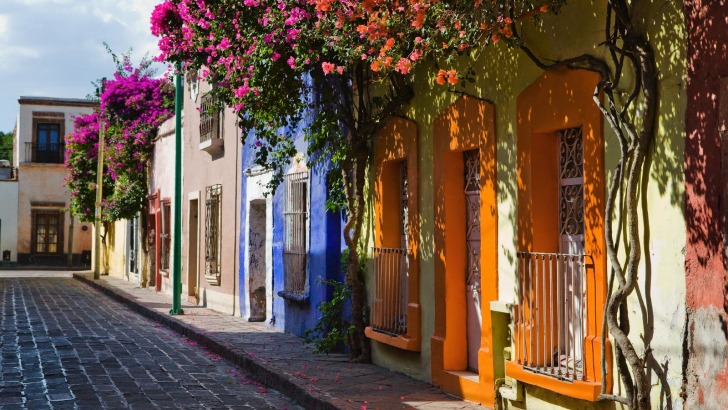
Mexico : Safety by City
- Aguascalientes
- Cabo San Lucas
- Chichen Itza
- Guadalajara
- Isla Holbox
- Isla Mujeres
- Mexico City
- Nuevo Laredo
- Piedras Negras
- Playa del Carmen
- Puerto Morelos
- Puerto Vallarta
- Queretaro City
- San Luis Potosi
- San Miguel de Allende
- Zihuatanejo
Queretaro is a city in central Mexico and the capital of the state of Queretaro.
The city’s full name is “Santiago de Queretaro” but nobody uses its full name.
For many, it’s an unbelievably safe city (safer than most US cities), has a great private education system, fantastic and affordable healthcare, some of the best restaurants in the world, the ideal weather, and one of the strongest economies in Mexico.
You also have a number of fantastic destinations within a few hours of driving.
San Miguel de Allende is an easy 45-minute drive and is a great place to wander, explore, and spend a day.
Bernal is another easy day trip.
- Warnings & Dangers in Queretaro City
OVERALL RISK: MEDIUM
Queretaro City is a very safe city: in fact, there isn't too much to worry about in this city compared to many other cities in Mexico. Just in case, you should apply all possible precaution measures, to minimize the chances of anything going wrong.
TRANSPORT & TAXIS RISK: LOW
Even though public transport is an issue in Mexico, in general, Queretaro doesn't seem to have that problem. Still, be very careful as this is one of the primary places where pickpockets operate.
PICKPOCKETS RISK: MEDIUM
Pickpocketing and bag snatching is a somewhat common issue in Queretaro, especially in public and crowded places like bus and train stations and airports. Keep your belongings by your side at all times and try to leave all your valuables in a security deposit box of your hotel.
NATURAL DISASTERS RISK: LOW
Queretaro isn't prone to suffer from natural disasters except for occasional earthquakes happening in the near vicinity of the city.
MUGGING RISK: LOW
Muggings and kidnappings are not typical for this area since this is a very peaceful city when it comes to violent crimes. Still, avoid poorly lit and abandoned areas.
TERRORISM RISK: LOW
There haven't been any terrorist attacks in Queretaro's recent history, but they shouldn't be ruled out. Remain vigilant at all times and aware of your surroundings.
SCAMS RISK: LOW
You should be very vigilant, decline all drinks sent by strangers, double-check all information and negotiate everything in advance. Be wary of people trying to distract you as it may be a scheme to try and steal from you.
WOMEN TRAVELERS RISK: LOW
Many women have traveled safely to Queretaro, without having any problems, and it's the norm here. Still, avoid parts of cities that are filled with bars and clubs, and visiting them alone, since there is a higher chance of running into intoxicated people.
- So... How Safe Is Queretaro City Really?
Queretaro City is, overall, a safe place to be in and to visit: in fact, its residents claim that the quality of living in Queretaro is exceptionally high.
Queretaro certainly has a lower crime rate than most medium-large American cities.
Queretaro is considered one of the safest cities in Mexico.
Due to this, and to its buoyant industrial economy, it leads the country in internal migration statistics (people who migrate from other parts of Mexico).
Many of them are fleeing from the violence that is observed in other parts of the country.
While crime does happen, as it does everywhere in the world, your odds of being safe are very good if you stay in the tourist areas, keep a low profile and avoid lonely places – basically, just use good old common sense!
For the most part, crime in the city is isolated and limited to certain hot spots.
It would be best to avoid the areas around the boroughs of San José el Alto, Santa Rosa Járegui, Casa Blanca and Menchaca (where you probably have nothing to do anyway).
Downtown is beautiful and completely safe, the rural areas are great for a visit as well as the ancient ruins and the malls are safe, too.
- How Does Queretaro City Compare?
- Useful Information
Legally entering Queretaro (and Mexico, in general) is fairly easy: all nationals receive a traveler's permit upon entering Mexico, and it costs 15 USD, while there are still some countries do need to acquire a visa. If you are not sure about your visa status, contact your local Mexican embassy for further details.
The Mexican peso is the official currency in Queretaro. ATMs are widespread throughout the country, and while credit cards are accepted in most top-end hotels, restaurants and stores, Mexico is considered largely a cash economy.
In Santiago de Queretaro, the wet season is overcast, the dry season is partly cloudy, and it is warm year-round. There is not much rainfall in the city throughout the year.
Querétaro Intercontinental Airport is an international airport located in the municipalities of Colón and El Marqués, in the city of Querétaro. It's one of the fastest-growing airports in the country.
Travel Insurance
Just like anywhere else, we recommend getting travel insurance when traveling to Queretaro, since it covers not only the costs of medical problems but also theft and loss of valuables.
Queretaro City Weather Averages (Temperatures)
- Average High/Low Temperature
Mexico - Safety by City
- Where to Next?
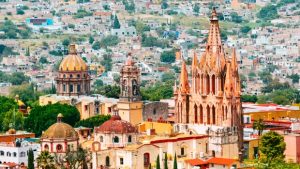
3 Reviews on Queretaro City
We were there 2 years back, it is a very safe and expensive city. Rich folks live here and you will see expensive homes and cars. There is an airline related economy here, mostly businesses that supply to airlines hence the money flowing in. Very nice, safe as far as we experienced.
Very safe city, especially downtown. Been coming here for 20 years and feel safer than many US cities.
A Delightful City
My wife and I were in Querétaro about five years ago for about four or five days. I have done a lot of traveling and have never seen a cleaner city. No litter anywhere! Impeccably maintained! Gracious people, beautiful architecture, lovely parks and excellent restaurants. Overall appears to be a very well managed, prosperous and livable city. Readily visible affluence. Easy, short trip from there to nearby San Miguel de Allende. We were genuinely impressed with the city of Querétaro and will definitely go back in the future.
Share Your Experience Cancel reply
Your Review
Title of your review
Article Contents
- Queretaro City : Safety by City
- Overall Risk
- Transport & Taxis Risk
- Pickpockets Risk
- Natural Disasters Risk
- Mugging Risk
- Terrorism Risk
- Women Travelers Risk
- Weather Averages (Temperatures)
- User Reviews
- Share Your Experience
Popular Destinations

Safety Index
Recent reviews & comments.
- Anonymous on Afghanistan
- Seth on Chad
- Claire on Peru
- Zach Cooper on 10 Most Dangerous Cities in South Carolina
- Zoe Diaz on 10 Most Dangerous Cities in South Carolina
Popular US States
- Pennsylvania
Expedia Rewards is now One Key™
$49 cheap flights to querétaro.
Bundle Your Flight + Hotel & Save!
Add a place to stay
Direct flights only
Featured airlines

- trending down icon Be in the know Get alerts if flight prices drop or rise*
- bex rewards loyalty icon Book smarter Save up to 30% on select hotels after you book a flight*
- one key icon Earn twice Earn your airline miles on top of our OneKeyCash Learn about One Key
How much is the cheapest flight to Querétaro?
Prices were available within the past 7 days and start at $49 for one-way flights and $83 for round trip, for the period specified. Prices and availability are subject to change. Additional terms apply.
Find Your Flights to Querétaro QRO
Cheap flights to Querétaro ( QRO)
Get started finding a cheap flight to Querétaro on Expedia by either choosing a deal on this page or entering into the search bar your travel dates, origin airport, and whether you want roundtrip or one-way airfare. You can filter for flexibility, number of stops, airline, and departure/arrival times to find the best flight for you.
We recommend using the ‘Flexible Dates’ calendar at the top of the page to see the price of plane tickets on the surrounding dates. This allows you to pick the cheapest days to fly if your trip allows flexibility and score cheap flight deals to Querétaro.
Roundtrip prices range from $83 - $239, and one-ways to Querétaro start as low as $49.
Be aware that choosing a non-stop flight can sometimes be more expensive while saving you time. And routes with connections may be available at a cheaper rate.
Airlines that fly to Querétaro ( QRO)
You have several options for which airline you choose to travel with to Querétaro. There are 10 airlines flying into QRO: Aeromexico, Volaris, American Airlines, United.
Cheap plane tickets may be available from different airlines at different times and with unique terms. It’s best to understand the details of each airline’s offer before judging its value.
For example, if you plan to check a bag or bring a carry-on, check whether the cheap airfare deal includes a baggage allowance. If not, verify whether the baggage fee is higher than the difference of other airline plane ticket deals offering free checked/carry-on baggage in exchange for a slightly higher airfare.
Additionally, your preferred frequent flyer membership programs may influence your choice of cheap airline. Expedia allows you to enter your membership numbers during checkout to earn points from your airline and Expedia Rewards—all while getting a great deal and planning all your travel in one online platform.
Find the best deals
At Expedia, we source many flight deals from multiple providers, so you can easily find the best deals that are right for you. A great strategy for getting the best deals can be to make sure you book and travel at the optimal times. Airfare to Querétaro (QRO) varies throughout the year based on seasonal demand. You’ll see the lowest rates for roundtrips to QRO in May and in April for one-ways.
Cancellation & flexibility
To change or cancel eligible flights, go to ‘My Trips’ and navigate to your itinerary. If you booked within the last 24-hours, you might be able to cancel your flight for free. Learn more about flight changes or cancellations from our customer service portal . Some plane tickets are available with no change fees, which you can filter for during your search.
Frequently asked questions
- What you pack in your carry-on luggage can be the difference between a comfortable flight, and one that leaves you drained. Start with the most important stuff, like a valid ID (like your passport) and your travel documents. Once they’re packed, toss in any medications you might need. Next? It’s all about comfort. A neck pillow, earphones and a juicy bestseller will help the time fly by while you’re cruising at altitude.
- There’s a list of items you should not pack in your carry-on bag too. Flammables, sharps and explosives are strictly prohibited in the cabin — they can include razor blades, box cutters, flares and aerosol cans. Some sporting equipment, like baseball bats and tennis rackets, are also not allowed in your hand luggage. Check your airline’s website for details about what you can and can’t take on board.
- Go for comfort rather than fashion when flying. Layer up and wear natural materials since they allow air and moisture to pass through and keep you cool. Cabin temperatures can get cold on long-haul flights, so pack a pullover and always wear sneakers or enclosed shoes.
- Lessen your risk of developing deep vein thrombosis (DVT), a blood clotting condition which can be caused by sitting for extended periods, by regularly moving around the cabin. Otherwise, do some gentle lower limb exercises in your seat. If you’re at higher risk of developing DVT, consider wearing compression socks.
Get up to 100% off your flight to Querétaro when booking a Flight + Hotel
Trending flights to querétaro.
- Top Flights Destinations
From Other Airports to Querétaro
Flights to cities near querétaro, top querétaro hotels, more popular airlines.
- Expedia's Latest Trends
Top Flight Destinations
- Flights to Cancun
- Flights to Mexico City
- Flights to Cabo San Lucas
- Flights to Tulum
- Flights to Guadalajara
- Flights to Puerto Vallarta
- Flights to Playa del Carmen
- Flights to Mazatlán
- Flights to Oaxaca
- Flights to Tijuana
- Flights to Monterrey
- Flights to Cozumel
- Flights to San Miguel de Allende
- Flights to Mérida
- Flights to Morelia
- Flights to Puerto Peñasco
- Flights to Acapulco
- Flights to Aguascalientes
- Flights to Veracruz
- Flights to Bacalar
Top Flight Destinations In the World
- Flights to United States of America
- Flights to Japan
- Flights to Philippines
- Flights to Costa Rica
- Flights to Italy
- Flights to India
- Flights to Thailand
- Flights to Mexico
- Flights to Greece
- Flights to Dominican Republic
- Flights to Bahamas
- Flights to South Korea
- Flights to Ireland
- Flights to Australia
- Flights to Spain
- Flights to Vietnam
- Flights to New Zealand
- Flights to China
- Flights to Germany
- Flights to Canada
- Chicago to Querétaro (ORD - QRO)
- Newark to Querétaro (EWR - QRO)
- Los Angeles to Querétaro (LAX - QRO)
- Raleigh to Querétaro (RDU - QRO)
- Detroit to Querétaro (DTW - QRO)
- San Antonio to Querétaro (SAT - QRO)
- Charlotte to Querétaro (CLT - QRO)
- Washington to Querétaro (IAD - QRO)
- Ciudad Juarez to Querétaro (CJS - QRO)
- New York to Querétaro (JFK - QRO)
- Flights to Toluca
- FUJITAYA Querétaro
- Hotel Crown Victoria
- Hotel Amberes
- ibis Queretaro
- Darwin Airline SA Lugano
- Evergreen International
- Ghadames Air Transport
- Aircompany Kokshetau
- Royal Airways Limited
- Vietnam Air Service Co.
- West Caribbean Costa Rica
- Olympus Airways
- Bulgarian Air Charter
- Branson Air Express
- Deutsche Bahn

13 budget-friendly places where couples can retire abroad and live on as little as $1,500/month
Retiring in the U.S. can be expensive. In Florida, often the favorite state of the nation's retirees, settling down to enjoy your golden years can cost as much as $58,396 a year .
That's one reason why many Americans choose to leave the States and retire abroad . Nearly 450,000 people received their Social Security checks outside the U.S. at the end of 2021, up from 307,000 in 2008, according to a 2023 report from the Wall Street Journal .
But not all international retirement destinations are created equal, especially if you're on a budget. Last month, International Living released its list of the 13 destinations where a couple can retire for as little as $1,500 a month.
International Living used the following seven categories to determine the best locations out of over 200 countries in the world:
- Visas and benefits
- Cost of living
- Affinity rating
- Health care
- Development and governance
In addition to taking those factors into consideration, International Living also looked at the availability of high-speed internet, networking opportunities and English-speaking locals or service providers in each country.
While the cities and towns are spread across the globe, some countries are especially affordable for retirees. Mexico had the most cities on the list, and five destinations were in Southeast Asia.
Top affordable retirement destinations in the Americas
- Querétaro, Mexico
- Isla Mujeres, Mexico
- Cozumel, Mexico
- Armenia, Colombia
- Arenal, Costa Rica
Querétaro, Mexico, is located in north-central Mexico, just over two hours from Mexico City. The local airport also offers direct flights to several hubs in the U.S., including Dallas/Ft. Worth, Houston and Chicago.
Querétaro offers a mild climate and various warehouse store shopping options, such as Costco and Sam's Club.
The estimated monthly costs for a single person in Querétaro are $744.50 before rent, according to Numbeo .
In Querétaro, the average rent for a one-bedroom apartment is 10,571.43 MXN or about $633. The average rent for the same apartment size in retirement hotspot Florida is $1,236, according to Zillow .
Top affordable retirement destinations in Asia
- Penang, Malaysia
- Chiang Mai, Thailand
- Phnom Penh, Cambodia
- Kuching, Malaysia
- Hoi An, Vietnam
Chiang Mai, Thailand, is one of the five Southeast Asian cities listed in the International Living survey.
It is the largest city in northern Thailand, home to hundreds of Buddhist temples. It is an hour's flight from Bangkok, the country's capital.
Not including rent, a single person's estimated monthly costs are $515.50, according to Numbeo . Additionally, the average rent for a one-bedroom apartment in the city center is 14,100.00฿ or about $395 per month.
Chiang Mai is home to Doi Inthanon, the highest peak in Thailand. It is known as one of the best places for birdwatching, and the park on the peak is home to over 300 species, according to Hotels.com .
Top affordable retirement destinations in Europe
- Alicante, Spain
- Granada, Spain
- Bergerac, France
Granada, Spain, is located at the foot of the Sierra Nevada mountains in Andalusia and is a city full of Spanish and Moorish history.
The city is also home to the University of Granada, which has an estimated 47,000 undergraduate students spread over several campuses around the city.
It offers retirees the opportunity to embrace the more relaxed Spanish lifestyle while still being connected to the more youthful culture of living in a "college town."
A single person's estimated monthly costs are $771.30 before rent in Granada, Numbeo states.
Renting a one-bedroom apartment in the city center costs an average of 583.33€ a month, or around $637. That's still about $677 less than the average rent price for an apartment in Harrisburg, Pennsylvania, one of the best places to retire in the U.S. , according to U.S. News and World Report .
Conversions to USD were done on March 15, 2024, using OANDA conversion rates of 1 euro to 1.09 USD, 1 Thai Baht to 0.02 USD, and 1 Mexican Peso to 0.05 USD. All amounts are rounded to the nearest dollar.
Correction: Querétaro, Mexico, is located in north-central Mexico. An earlier version misstated its location.
Want to make extra money outside of your day job? Sign up for CNBC's new online course How to Earn Passive Income Online to learn about common passive income streams, tips to get started and real-life success stories. Register today and save 50% with discount code EARLYBIRD.
Plus, sign up for CNBC Make It's newsletter to get tips and tricks for success at work, with money and in life.
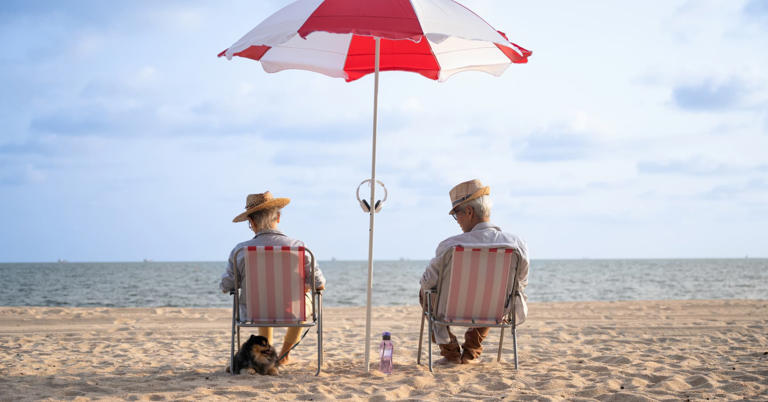

That Time Europe Tried to Bring Monarchy Back to Mexico
In “Habsburgs on the Rio Grande,” Raymond Jonas’s story of French-backed nation building in Mexico foreshadows the proxy battles of the Cold War.
At the height of the American Civil War, the Hapsburg prince Maximilian went to Mexico to rule as king with the best of intentions. Credit... Dea Picture Library via Getty Images
Supported by
- Share full article
By Natasha Wheatley
Natasha Wheatley is a historian at Princeton University and the author of “The Life and Death of States: Central Europe and the Transformation of Modern Sovereignty.”
- April 20, 2024
- Barnes and Noble
- Books-A-Million
When you purchase an independently reviewed book through our site, we earn an affiliate commission.
HABSBURGS ON THE RIO GRANDE: The Rise and Fall of the Second Mexican Empire, by Raymond Jonas
In October 1863, a Mexican delegation arrived in Trieste, a polyglot city in southern Europe on the borderlands of the Hapsburg Empire. In a turreted castle on the Adriatic coast, the delegates — many of them Europhile bankers and industrialists — offered the crown of Mexico to Maximilian, a Hapsburg prince, and his wife, Charlotte, daughter of the king of Belgium.
Since gaining independence in 1821, Mexico had squandered the “splendid legacy” of European rule, the delegates explained, and the country now led a “sad existence” as a shaky, vulnerable republic. Only the resurrection of monarchy could guarantee stability and prosperity. The timing was crucial. Mexico’s republican neighbor, the United States, was too preoccupied by a civil war to block European intervention.
Maximilian thought of himself as a progressive monarch; he would accept the invitation only if it represented the true will of the Mexican people. When the delegates returned the following April, they brought enthusiastic testimonials from towns and villages across Mexico. Satisfied, flattered and ambitious, Maximilian and Charlotte set sail for North America as the emperor and empress of Mexico.
Two years later, a shattered Charlotte was back in Europe, eating nothing but fruit she peeled and nuts she shelled herself for fear of poisoning. Maximilian would soon be dead, executed by Mexico’s republican forces on a rocky hillside outside Querétaro.
The rise and fall of the Second Mexican Empire is the subject of “Habsburgs on the Rio Grande,” by the historian Raymond Jonas. Seen from the American perspective, Maximilian’s fleeting rule is all too easily understood as a European fantasy that failed to grasp history’s ineluctable path from monarchy to democracy. Jonas instead argues for its global significance, placing it at the center of a transcontinental power struggle between an expansionist United States and faltering European supremacy.
When Mexico first cast off Spanish rule, the country established its own independent monarchy — the First Mexican Empire — and then, in 1824, a republic. Two decades of turbulent constitutional change and civil strife followed. In 1845, the United States annexed Texas from Mexico. It then launched a war of aggression that would strip Mexico of half of its territory. U.S. ambitions appeared unlimited, its appetite for territory insatiable, and many Mexicans feared their young republic would succumb entirely.
They were not alone in their alarm. Across the Atlantic, as Mexico ceded California to end its war with the United States, European autocrats were busy stamping out liberal revolutions, many of which had drawn up constitutions inspired by the American one.
But it wasn’t just the existence of a stubbornly persistent democracy that made the United States a threat: European rulers watched aghast as the former English colony assumed colossal new proportions, stretching from coast to coast and dwarfing their own states in size. “In the space of two generations,” Jonas writes, “the American republic had transformed itself from a postcolonial backwater — distant and easily ignored — into an insolent continental powerhouse and an existential threat to Europe and European hegemony.”

They needed a strategy of containment. When the Civil War erupted, absorbing American energy and attention, European rulers, led by the French autocrat Napoleon III, seized the opportunity to check the rising hegemon. They joined forces with conservatives and traditionalists chafing at republican rule in Mexico to launch a wildly ambitious plan to restore monarchy and defend Mexico against the “Yankee imperialism” of the “Robber Republic” to the north.
On the pretext of collecting debt and protecting “persons and property,” British, Spanish and French forces formed a coalition of the willing and invaded Mexico in 1861. Cracks emerged quickly in this motley alliance. Facing military defeats, yellow fever and skeptical opinion at home, Britain and Spain soon fell away, leaving Napoleon III to wage his increasingly bloody “war of liberation” alone.
Napoleon claimed that he was not seeking a new French colony. He even paid lip service to the idea that the Mexican people should determine the type of regime to come — the main thing was that it be friendly to France and strong enough to resist U.S. power.
Yet he also conveniently subscribed to the unsupported view that Mexicans craved a monarch, and was all too happy when Mexican conservatives selected a Hapsburg prince to rule the new government his war had made possible. With Maximilian’s arrival, Napoleon’s project of regime change appeared complete.
Jonas vividly reconstructs how Maximilian’s power was forged and maintained by the sharp end of a French bayonet. It took the “largest transoceanic deployment of its time” — more than 30,000 soldiers were shipped from Europe and North Africa in the space of nine months — and even then the bitter fighting progressed street by street, house by house. Republican guerrilla resistance forces never surrendered.
The irony of an imperial intervention to defend against empire is not lost on Jonas, but, with a historian’s open-ended curiosity, he also wants to understand how the ideology of “liberatory” empire worked. If many invoked it opportunistically, others clearly did so with complete sincerity — including Maximilian, who saw his monarchy as a bulwark of Mexican independence against U.S. encroachment.
Maximilian learned Spanish before departing Europe and took his role seriously, becoming a champion of the majority Indigenous population and refusing to undo the popular nationalization of church property enacted by his republican predecessors, to the fateful dismay of the conservatives who propped up his rule.
He also saw American slavery as “hideous,” but, desperate for allies, he courted Confederate settlers, presenting Mexico as a refuge following their defeat in the American Civil War and drafting a peonage law that allowed them to bring their enslaved laborers to Mexico even though slavery had been abolished there following independence.
Jonas is astute and judicious in navigating the kaleidoscope of contradictory political ideologies that came together in the Second Mexican Empire, before all too quickly coming apart again. Captured by the republican forces of Benito Juárez as French troops withdrew, 34-year-old Maximilian was marched before a firing squad in June 1867. “I am going to die for a just cause, the independence and liberty of Mexico. May my blood end the misfortunes of my new country! Viva Mexico!” he declared, before parting his long blond beard over his shoulders to give the executioners a straight shot at his chest.
Maximilian was far from the last imperial leader to call himself a liberator. The 20th century belonged to two great anti-imperial empires — the United States and the Soviet Union — both of whom espoused self-determination even as they intervened far beyond their borders. The war on terror, with its naked pursuit of regime change abroad, also casts a long shadow over Jonas’s narration. Anti-imperialism, moreover, has remained a popular catch cry, and not just on the left, as Viktor Orban , in Hungary, and Narendra Modi , in India, remind us today.
In the end, Maximilian’s story captures a political world in dramatic transition, as traditional institutions — monarchy chief among them — reckoned with doctrines of popular sovereignty. For all his enlightened modernity, Maximilian still believed in the magical shield of his blue blood, a magic that was fitfully losing its force. Imprisoned and awaiting trial in Querétaro, he reportedly remarked to his general, “Don’t think that an Austrian archduke can be shot so easily.”
HABSBURGS ON THE RIO GRANDE : The Rise and Fall of the Second Mexican Empire | By Raymond Jonas | Harvard University Press | 369 pp. | $35
Explore More in Books
Want to know about the best books to read and the latest news start here..
Salman Rushdie’s new memoir, “Knife,” addresses the attack that maimed him in 2022, and pays tribute to his wife who saw him through .
Recent books by Allen Bratton, Daniel Lefferts and Garrard Conley depict gay Christian characters not usually seen in queer literature.
What can fiction tell us about the apocalypse? The writer Ayana Mathis finds unexpected hope in novels of crisis by Ling Ma, Jenny Offill and Jesmyn Ward .
At 28, the poet Tayi Tibble has been hailed as the funny, fresh and immensely skilled voice of a generation in Māori writing .
Amid a surge in book bans, the most challenged books in the United States in 2023 continued to focus on the experiences of L.G.B.T.Q. people or explore themes of race.
Each week, top authors and critics join the Book Review’s podcast to talk about the latest news in the literary world. Listen here .
Advertisement

IMAGES
VIDEO
COMMENTS
Santiago de Querétaro, most often referred to simply as Querétaro, is a beautiful colonial city in central Mexico well worth putting on your travel radar. With San Miguel de Allende to the northwest and Mexico City to the southeast, Querétaro is easily accessible, whether for a day trip from a nearby destination or a longer stay.
Queretaro International Airport (code: QRO) is the best airport to use for Queretaro Mexico travel. It is located in Tequisquiapan, Queretaro, about 45 minutes from Queretaro City in normal traffic. From the airport, you can rent a car and drive to your Queretaro hotel , or take a bus , taxi or Uber.
Querétaro is an emerging star of a travel destination in Mexico and has quickly joined our growing list of favorites places within the country. It's such a pleasant colonial city to experience in the central highlands of Mexico. We found so many fun things to do in Queretaro to make it worth spending at least a few days in this gorgeous city.
Get lost walking around the historical center, remembering to look up and check the old houses' tiled rooftops, their decorated and multicolored walls, and antique doors. Check out the church's architecture and the heavy Baroque-style interiors, too. Statue in Queretaro Center. 2. Temple de Santa Rosa de Viterbo.
Highways and toll roads connect to Queretaro from many cities across Mexico. If you don't feel comfortable driving, private cars and luxury buses are also available. Take the bus from Mexico City airport to Queretaro. Read our post: Bus Travel in Mexico is Easier Than Flying. Where to Stay in Queretaro
North America. Wandering through the delightful colonial heart of Querétaro with its shady squares, grand fountains and historic mansions, you'd never guess that this is one of the fastest-growing cities in the northern hemisphere thanks to a booming aerospace and technologies industry. Except perhaps you can, as in order to reach the colonial ...
Avenida Hércules Ote 1. Open every day; 10 a.m. - 10 p.m. (midnight on the weekends) If you're looking for craft beer closer to Querétaro city center, check out Almacén Hércules (Avenida Universidad Oriente 156) which offers all the same beers as the main brewery.
Querétaro Travel Guide: Activities to do in Querétaro. Go shopping in the markets. Take a tramvia tour. Listen to legends and myths of Querétaro. Take a Tour of the Wine & Cheese Region. Querétaro Travel Guide: Statues of Querétaro. El Danzante Conchero Chichimeca. Monument of the Corregidora. Escultura "La Flautista".
About Queretaro City. The locals have long frequented "balnearios" and 600 hot springs bubble up around the country. Tequisquiapan, an enticing cheese and wine-making region in the state of Querétaro, is the perfect destination for those wanting to pair their hot springs experience with a delicious gourmet escape.
8. Take a rest at the Jardin Zenea. Jardin Zenea is a popular meeting place among locals, with plenty of benches, fountains, and greenery to take in. It is one of the must-see attractions in Querétaro. This public park sits in the heart of the city and boasts gorgeous gardens, fountains, and statues.
12. Eat in the Market like a Local. The big and busy Josefa Ortiz de Domínguez "La Cruz" Market is the best place in Queretaro to experience the local vibe and taste typical food. Along with the usual produce, meat, and consumer goods, the market also has many small restaurants and food stands with local specialties.
Travel Advisory. August 22, 2023. See State Summaries. K C. Reissued after periodic review with general security updates, and the removal of obsolete COVID-19 page links. Country Summary: Violent crime - such as homicide, kidnapping, carjacking, and robbery - is widespread and common in Mexico. The U.S. government has limited ability to ...
In this Queretaro Mexico travel guide we will explore some of the best things to do in Queretaro Mexico. I will show you some of the top things to see in Que...
Location: Mexico Event: The U.S. Department of State updated the Mexico Travel Advisory and the Mexico country information page on August 22, 2023. The Travel Advisory includes individual risk assessment levels for each state. Actions to Take: Read the Mexico Travel Advisory, including the detailed state summaries and advisory levels for information on your specific travel destination.
🚌 Bus from Mexico City to Queretaro. Buses are one of the most popular travel methods from Mexico City to Queretaro. On average, the bus journey from Mexico City to Querétaro takes about 2.5 to 3 hours, depending on traffic conditions and the specific route taken.
Buses run all day from Mexico City to Queretaro at least once an hour. For detailed information about bus transportation read the Mexperience guide to Bus Travel in Mexico. By Car - Driving to Queretaro is very fast and efficient on the toll roads that connect the Capital to Queretaro. Take Highway 57D from Mexico City, Highway 57D (South ...
Call us in Washington, D.C. at 1-888-407-4747 (toll-free in the United States and Canada) or 1-202-501-4444 (from all other countries) from 8:00 a.m. to 8:00 p.m., Eastern Standard Time, Monday through Friday (except U.S. federal holidays). See the State Department's travel website for the Worldwide Caution and Travel Advisories.
Find the travel option that best suits you. The cheapest way to get from United States to Querétaro costs only $2844, and the quickest way takes just 5 hours. Find the travel option that best suits you. ... Flights from Houston to Queretaro via Mexico City Ave. Duration 5h 1m When Tuesday, Thursday and Friday Estimated price $9500 - $22000 ...
Find the travel option that best suits you. The cheapest way to get from Mexico City to Querétaro costs only $152, and the quickest way takes just 1 hour. Find the travel option that best suits you. ... Flights from Mexico City to Queretaro Ave. Duration 1h 12m When Every day Estimated price $2400 - $7500. Volaris Website volaris.com ...
Mexico : Safety by City. Queretaro is a city in central Mexico and the capital of the state of Queretaro. The city's full name is "Santiago de Queretaro" but nobody uses its full name. For many, it's an unbelievably safe city (safer than most US cities), has a great private education system, fantastic and affordable healthcare, some of ...
We recommend using the 'Flexible Dates' calendar at the top of the page to see the price of plane tickets on the surrounding dates. This allows you to pick the cheapest days to fly if your trip allows flexibility and score cheap flight deals to Querétaro. Roundtrip prices range from $83 - $295, and one-ways to Querétaro star.
Aeroméxico and Volaris fly from Mexico City Airport (MEX) to San José el Alto 3 times a day. Alternatively, Primera Plus operates a bus from Mexico City International Airport T2 to Terminal de Autobuses de Querétaro Acceso 1 every 30 minutes. Tickets cost $330 - $550 and the journey takes 2h 40m. Airlines. Aeroméxico.
Querétaro, Mexico, is located in north-central Mexico, just over two hours from Mexico City. The local airport also offers direct flights to several hubs in the U.S., including Dallas/Ft. Worth ...
Mexico could have more than 200 data centers around the country within 5 years. (Taylor Vick/Unsplash) Novillo told reporters that there are 166 such centers in Mexico, making it one of the top 10 ...
Find the travel option that best suits you. The cheapest way to get from Querétaro to Mexico City costs only $152, and the quickest way takes just 1½ hours. Find the travel option that best suits you. ... Flights from Queretaro to Mexico City Ave. Duration 1h 6m When Every day Estimated price $2400 - $7500. Train operators. Sistema de ...
In "Habsburgs on the Rio Grande," Raymond Jonas's story of French-backed nation building in Mexico foreshadows the proxy battles of the Cold War. At the height of the American Civil War, the ...